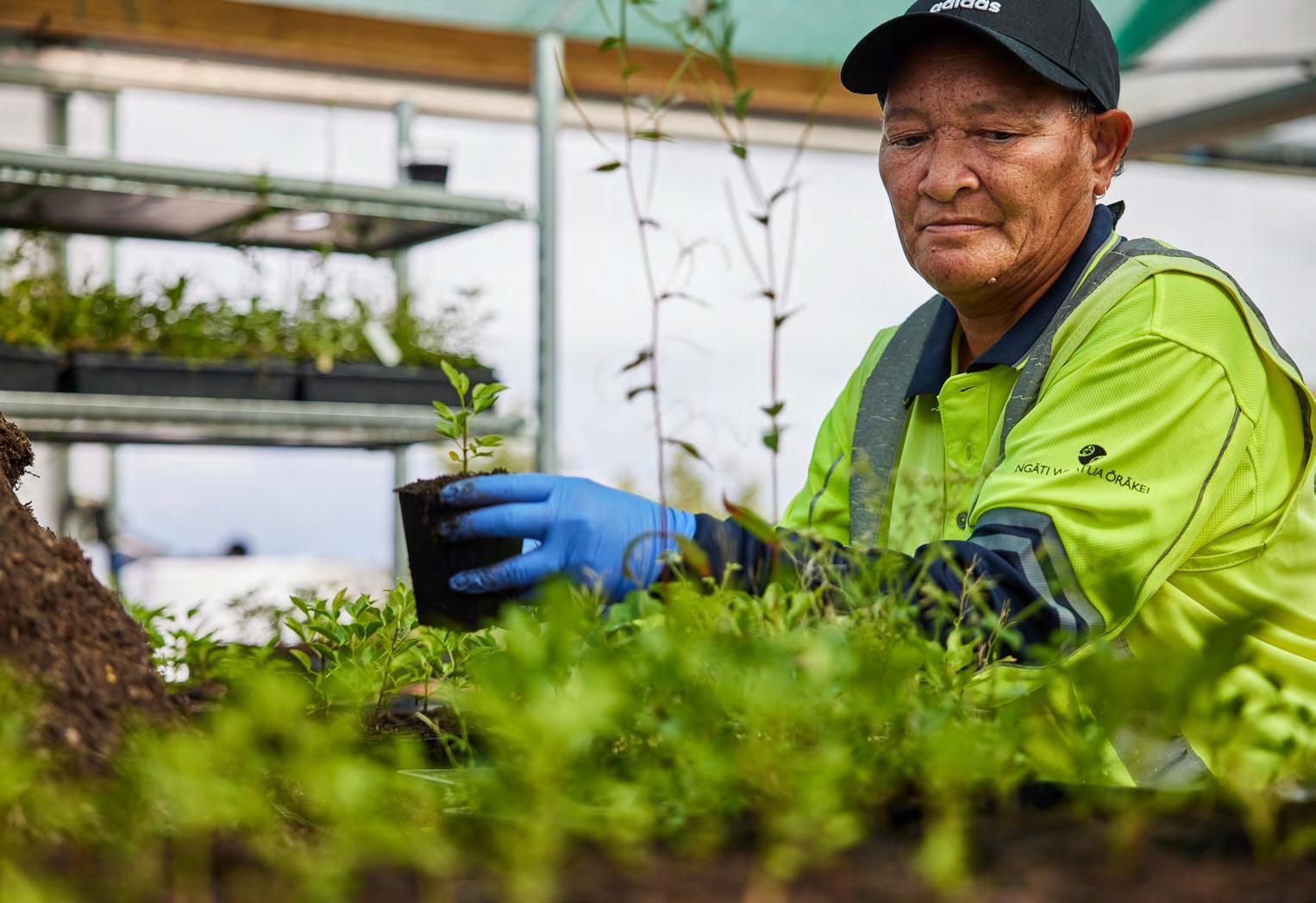

Health, Safety, Environment and Sustainability Report 2022
In March 2023, the New Zealand Geographic Board Ngā Pou Taunaha o Aotearoa formally adopted the proposed City Rail Link (CRL) station names - Maungawhau Station (previously Mt Eden Station), Karanga-a-Hape Station, Te Waihorotiu Station and Waitematā Station (currently Britomart Station until CRL opens).
Please note that as this document was published following the official decision, the stations are referred to throughout the report as follows:
• Maungawhau Station
• Karanga-a-Hape Station
• Te Waihorotiu Station
• Waitematā Station (Britomart)
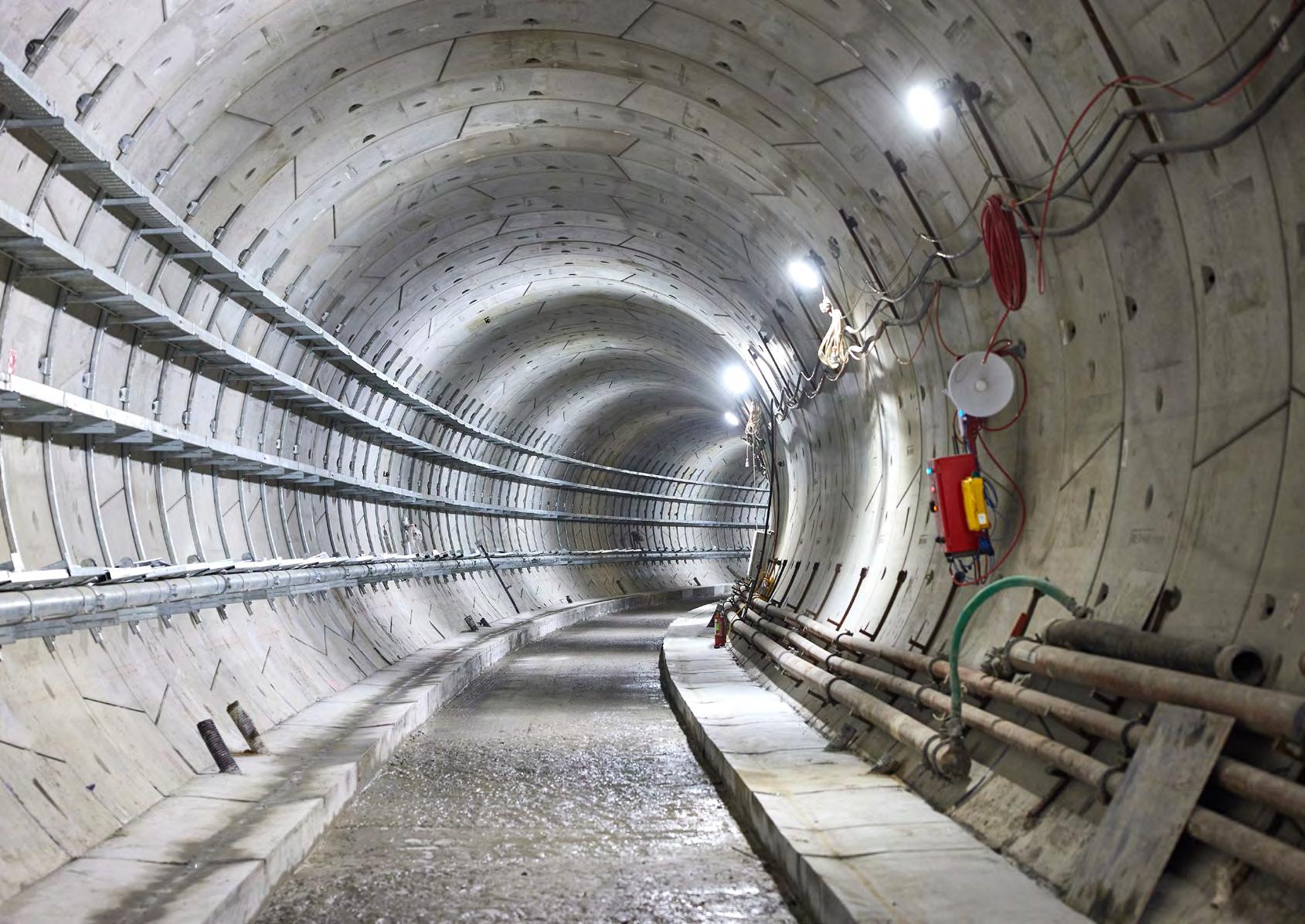
Use of te reo Māori in this document:
Our commitment to te reo Māori means that you will see the use of words and phrases in te reo Māori throughout this document as normal practice.
Some definitions:
Aotearoa - New Zealand
Atua - ancestors with continuing influence, a god, supernatural being, deity
Haahi - religion
Hitori - history
Kai - food
Karakia - words that are chanted to obtain benefit or avert trouble
- incantations to invoke spiritual guidance and protection
Korero - to tell, say, speak, talk, address
Māori mātauranga - Māori knowledge, wisdom, understanding, skill
Mahi - work
Maramataka - the Māori lunar calendar
Ngahere - forest
Pakihi - business
Pepeha - a way of introducing yourself in Māori
Rangatahi - youth
Tapu - a state that is sacred, prohibited, restricted, under atua protection
Tāmaki Makaurau - Auckland
Te ao Māori - the Māori world view
Te reo Māori - the Māori language
Tikanga - Māori practices and ways of doing things
Waiata - song
Whānau - all families
Whakanoa - to remove tapu
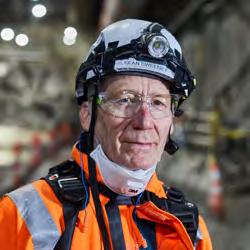
Foreword
The effects of climate change have never been more front of mind. In mid-2022, New Zealand started to emerge from the long shadow of Covid, but as the year ended City Rail Link Ltd (CRL Ltd) found itself facing new external challenges – the weather.
The City Rail Link (CRL) project has a 100-year design life. That means it must be resilient to climate change – a critical task we addressed early in the design phase. We’ve put measures in place to mitigate the potential risks that climate change poses including accounting for increased rainfall in the years ahead and, importantly, ensuring our flood defences are designed to withstand a 1 in 2,500-year event.
Safety on site is first and foremost on CRL and our ongoing investment in workplace systems
and behaviour is delivering the kind of dividend everybody wants – a safer workplace.
A significant focus in 2022 was the continued education of frontline Link Alliance leaders and supervisors. Throughout the year 150 Link Alliance managers, who have a critical role in ensuring a safe work area and safe delivery of work, undertook a comprehensive and practical training programme.
In September, the ‘Alive on Site’ behavioural safety training programme was rolled out within Link Alliance to more than 650 workers over three weeks, the largest application for this global safety programme ever delivered to date.
As part of our goal to create a healthier workplace, confidential health monitoring was offered to all team members, alongside regular occupational health monitoring of exposure to both short and
long-term hazards like noise, vibration, silica, dust, fumes, and other hazardous substances.
Given the scale and complexity of this project, we have a very real responsibility to be an industry exemplar in environmental protection, sustainability, health (including mental health) and safety. Our partnership with mana whenua has formed the crucial foundation our approach in these areas is built upon: Mahia te mahi, hei painga hei oranga mo tātou katoa,’ ‘To do the work, for the good of everyone’.
At CRL Ltd and Link Alliance, we look to move the dial wherever we can – leaving a legacy we can be proud of and that future projects can learn from.
Among our initiatives to deliver a positive and lasting social outcome is our Progressive Employment Programme (PEP), a 16-week training
course targeting Māori and Pasifika rangatahi who face barriers to entering the workforce. CRL Ltd would like to acknowledge the passion and commitment of our pastoral care and other Link Alliance partners. Thanks to their support we now have a total of 21 rangatahi in employment.
In March 2022, six rangatahi joined the PEP, gained practical experience and micro-credentials and all six were offered full time positions with Downer and labour hire companies. In August a second cohort of six rangatahi entered the PEP scheme and four are on track to receive fulltime employment (two left after realising construction wasn’t for them).
These are excellent results and we are now actively recruiting for a dozen rangatahi to participate in PEP during 2023.
Our commitment to supporting Māori and Pasifika also extends to our project spend. The Link Alliance has awarded 41 contracts to Māori and Pasifikaowned sub-contractors and suppliers, worth $79 million, a significant investment in the Māori and Pasifika business economy. This will build both capacity and capability in the Māori and Pasifika
construction sector, benefiting the broader industry by increasing diversity in the supply chain.
Our efforts in social outcomes initiatives targeting mana whenua, Māori, Pasifika and youth were recognised at the 2022 Infrastructure Sustainability Council Awards where the project achieved the Excellence in Social Outcomes, Highly Commended Award.
Sustainability is at the cornerstone of our thinking as we aim to build New Zealand’s largest transport infrastructure project without using unnecessary resources or creating unnecessary waste. We are confident that CRL will set the benchmark for delivering sustainable infrastructure in New Zealand as we continue to construct the project to the highest sustainability standards.
An objective measure of our success is the independent assessment of project outcomes by the Infrastructure Sustainability Council. Standards in this field are high and we were particularly proud to achieve the highest possible rating in June with a ‘Leading’ As Built for the completed Contract 1 (C1)Waitematā Station (Britomart)/Lower Queen Street.
In November the project also won the prestigious Decarbonisation Outcomes Award (projects over $20m) at the Building Nations 2050 Impact Awards for efforts to achieve sustainability excellence.
But we haven’t finished yet. Until this project is complete, we’ll continue to ensure that our project is doing the work for the good of everyone. We’ll continue to dedicate our resources to contribute to better outcomes for New Zealand across health, safety, sustainability, and environment and we’ll continue to work hard to keep our people safe.
And as climate change continues to test us now and into the future our investment and commitment in these areas will put us in the best place possible to be able to weather the impacts.
 Dr Sean Sweeney, Chief Executive Officer
Dr Sean Sweeney, Chief Executive Officer
Project overview and benefits
The CRL will deliver multi-generational benefits that will change Auckland for the better.
The project offers a huge opportunity to leave a positive legacy for New Zealand. It is designed to set new benchmarks for construction, workplace safety, environmental sustainability and community engagement.
CRL will deliver a wide range of long-lasting economic, social, environmental and business benefits over the lifetime of the infrastructure.
The primary direct benefits of a world-class efficient railway that enables and activates the entire rail network are to Auckland commuters and businesses.
CRL will double capacity, increase frequency, reduce travel times, carrying up to 54,000 people per hour when complete.
There is a focus on helping people who are traditionally disadvantaged into career pathways which are life-changing. The project leverages its scale, complexity and innovation to set the bar for social investment.
$11.928 billion
A PwC economic study, in October 2022 found CRL will deliver total economic benefits of $11.9 billion for the next 60 years.
The biggest impact is on travel time for public transport users, which PwC has assessed as delivering $4.543 billion in benefits.
The project has also been assessed on its agglomeration benefits. This is a broad-based measure that accounts for CRL’s additional employment density and business investment. CRL agglomeration benefits worth $4.229 billion are expected to be delivered. This leads to a corresponding lift in GDP due to increased productivity and economic output.
Reliability improvements from the CRL due to more trains running on time and less delays for passengers yields $1.575 billion in benefits to the Auckland economy. The benefits of reduced congestion to road users are set at $594 billion.
CRL will drive investment in businesses, employment and housing around CRL stations along Auckland’s rail corridors, supporting a more sustainable and productive city.
The core value of CRL is the creation of a world-class modern urban transit network, improving travel options and times due to increasing efficiency across the rail network. CRL will double the number of people within 30 minutes of central Auckland.
The rail network’s increased capacity will be the equivalent to three Harbour Bridges or 16 extra traffic lanes at peak travel time.
In the near-future, it will take only three minutes to get from Maungawhau Station to Karanga-a-Hape Station and only six minutes from Maungawhau Station to Te Waihorotiu Station. Another three minutes gets commuters to Waitematā Station (Britomart).
When CRL opens, the entire capacity of Eden Park can be transported to the Downtown entertainment district in nine minutes.
Contracts
The CRL project is divided into six delivery contracts, with Link Alliance delivering the main works –the stations and tunnels.
Maungawhau Station
Waitematā Station (Britomart) Queen Street
Te Waihorotiu Station
Karanga-a-Hape Station
Under Construction
Contract 3 - Alliance:
Stations and tunnels
Western Line connection/NAL
--- Rail Systems
Contract 9 - Britomart East
Contract 8 - not shown
• Newmarket
• Strand (completed)
• Ōtāhuhu (completed)
Completed
DSC - Downtown Shopping Centre
Contract 1 -
• Waitematā Station (Britomart)
• Lower Queen St
Contract 2 - Albert St (Customs to Wyndham St)
Contract 6 - Mt Eden Stormwater Main
Contract 1 (C1) –
Britomart Station/Lower Queen Street
Delivered by Downer Soletanche Bachy Joint Venture (DSBJV)
Contract 2 (C2) –
Lower end of Albert Street between Customs and Wyndham Streets
Delivered by Connectus – a McConnell Dowell and Downer Joint Venture
Contract 3 (C3) –
Main Tunnel, Stations, Western Line Connection and Rail Systems
Delivered by Link Alliance (Vinci Construction Grands Projets SAS, Downer, Soletanche Bachy, WSP, AECOM, Tonkin + Taylor and CRL Ltd)
The final components of C1 were completed in October 2021. This contract included the construction of the initial sections of the CRL tunnels from Waitematā Station (Britomart) to the Downtown Shopping Centre, and refurbishment of the Chief Post Office (CPO) heritage building that is part of the station building. Lower Queen Street was converted into a people friendly square, known as Te Komititanga, with further streetscape enhancement works completed on adjacent Tyler and Galway streets.
This contract has been awarded an Infrastructure Sustainability ‘Leading’ As Built rating.
C2 was completed in October 2020. The contract included 350 metres of trenching and tunnelling from Commercial Bay at Customs Street to Wyndham Street, relocating a stormwater main, strengthening the Ōrakei Main Sewer and improvements at street level including new street furniture, lighting, tree planting and bus bays.
This contract has been awarded an Infrastructure Sustainability ‘Excellent’ As Built rating.
C3 includes excavating tunnels on Albert Street just south of Wyndham Street to the Western Line at Maungawhau Station; building two underground stations, Te Waihorotiu Station and Karanga-a-Hape Station, and redeveloping Maungawhau Station. The contract also includes original C5 scope (Western Line works, including connection of tunnels to the existing live rail corridor environment and line-wide systems) and original C7 scope (rail systems integration, testing and commissioning from Waitematā Station (Britomart) to Maungawhau Station.
The Dame Whina Cooper tunnel boring machine (TBM) completed its first tunnel drive from Maungawhau Station through Karanga-a-Hape Station and arrived at Te Waihorotiu Station on 22 December 2021. The TBM was then dismantled and transported back to Maungawhau Station where it was reassembled and relaunched for the second tunnel drive on 26 April 2022. This drive broke through at Te Waihorotiu Station on 14 September 2022. Logistical support to the TBM was located at Maungawhau Station, it included concrete tunnel lining segment storage and the stockpile for excavated material.
Work along the North Auckland Line (NAL) has continued with construction of the first half of the rail corridor foundations completed. This allowed the NAL single line to be realigned onto these new foundations during the during the December 2021 Christmas Block of Line (BOL) rail network closure. Construction of the second half of the NAL foundations has commenced and is forecasted to be completed by the end of 2022 with the transfer back into a two line railway in 2023.
Contract 3 (C3)Main Tunnel, Stations, Western Line Connection and Rail Systems (cont'd)
The diversion of the Huia 2 watermain at Maungawhau Station, along with a significant portion of the CRL connecting structures, have been completed. Work has begun on the vent shaft and station buildings, along with several of the remaining structures. These structures will be completed during 2023.
Development of Karanga-a-Hape Station continues to progress well. The structural shafts at Beresford Square and Mercury Lane have been completed along with the platform and concourse mined tunnels. The second TBM drive was pulled through the completed station platform tunnels at Karanga-a-Hape Station to allow the TBM to continue boring through to Te Waihorotiu Station. Once the TBM was pulled through it allowed the final tunnel structural works to be completed. Construction of the internal structures in the shafts and tunnels continue and will be followed by the commencement of the architectural works and the installation of building and rail management systems.
Te Waihorotiu Station piling and diaphragm wall construction of the perimeter structure has been completed and the roof slab installed. Mass excavation of the station box area and construction of the base and intermediate level floors have been completed and the construction of the platform and track slab was commenced. The temporary closure of Victoria Street enabled the construction of the northern end of the station box structure to be completed, which allows the final urban realm works at Victoria St to commence. Construction of the internal structural slabs and walls will continue, followed by the architectural works and the installation of the building and rail management systems.
Contract 6 (C6) –Mt Eden Stormwater Main
Delivered by March Bessac Joint Venture
Replacement of the stormwater line in Mt Eden, completed in August 2019, prior to the start of C3 works.
Contract 8 (C8) –Wider network improvements
Delivered by KiwiRail and CRL Ltd
C8 includes improvement works at Ōtāhuhu and at the Strand in Parnell.
The design for the C8 Newmarket works has been completed. KiwiRail has completed 80% of construction and a further 10% will be completed by April 2023. The remaining signalling works are due for completion in Q2 2024.
Auckland Transport is reviewing the potential works and funding required at Henderson Station. This will be reviewed by the Sponsors before work can commence. However, CRL Ltd is currently funding up to Stage B Design completion.
The Strand Station will undergo further modification, primarily upgrading pedestrian mobility access and walkway compliance. CRL Ltd is currently funding the design stage with the expectation that this will be completed by March 2023.
Ōtāhuhu delivery completed October 2020.
Contract 9 (C9) –Eastern end of Britomart Station
Delivered by KiwiRail
Additional connections, platform widening and track modification at the eastern end of Waitematā Station (Britomart) required before CRL is operational.
• C9 Stage 1 scissors were installed over the Christmas 2020 BOL. The Stage 2A structural works and Stage 3 junction of two turnouts and the double slip were completed over Christmas 2021 BOL. Stage 2B completed the remaining structural works over Christmas 2022 BOL with demolition of the old south wall. Design works for the remaining portions of the contract have been completed, and the Stage 4 track next to the outer platforms is underway.
• In May 2022 a contract was directly signed with rail specialist Martinus Rail to undertake additional works at Waitematā Station (Britomart). This is the Stage 4 to 6 “Structures” package. The contract includes structural tunnel wall strengthening, at-surface utilities relocations and tunnel pedestrian walkways. Completion of this Contract is expected by May 2023.
• The Stage 4 to 6 “Track” Contract was recently awarded directly to KiwiRail for track slab and track works in the vicinity of Platforms 1 and 5. Physical works for that package start in January 2023, with completion expected January 2024.
Highlights from the year
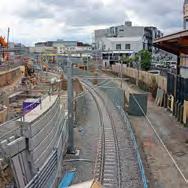


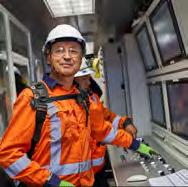
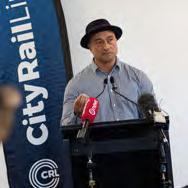
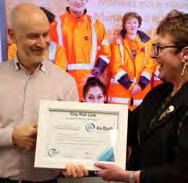
January Work to connect the NAL with CRL was executed with a rail line switch at Maungawhau Station during the Christmas rail network closure.
February
March
April
May
An overnight operation brought the last sections of the TBM back to Maungawhau Station where the TBM was prepared for its second underground journey.
The Porters Avenue pedestrian bridge span was successfully lifted into place above the NAL.
The TBM started its second subterranean drive from Maungawhau/ Station to Te Waihorotiu Station.
In partnership with Auckland Transport, CRL Ltd announced the proposed te reo Māori names and designs for the CRL stations.
June CRL Ltd was awarded a ‘Leading’ As Built rating, the highest possible rating by the Infrastructure Sustainability Council for C1.
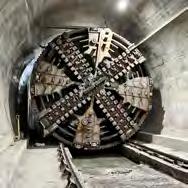
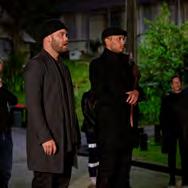
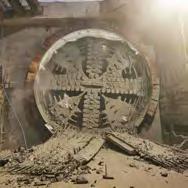
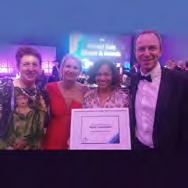
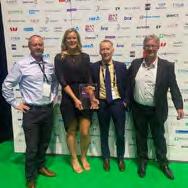
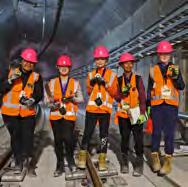
July
The TBM had its second breakthrough at Karanga-a-Hape Station slightly ahead of schedule.
August The completion of the Basque Park utility works were celebrated with a dawn karakia.
September
October
November
December
The TBM had its final breakthrough into Te Waihorotiu Station, marking the completion of two 3.45km-long tunnels.
The project received an Excellence in Social Outcomes
Highly Commended Award at the 2022 Infrastructure Sustainability Council Awards in recognition of the success of initiatives designed to assist mana whenua, Māori, Pasifika and youth.
The project was rewarded for efforts to achieve sustainability excellence at the Building Nations 2050 Impact Awards, winning the prestigious Decarbonisation Outcome Award (projects over $20 million).
Five school children and their guardians were invited to be the first members of the public to walk the entire length of the tunnels in an event dubbed ‘Tamariki in the Tunnels’.

Decarbonisation Award - Building Nations
Scott Elwarth, Sarah Sutherland, CRL Ltd CE Sean Sweeney and Hugh Leersnyder
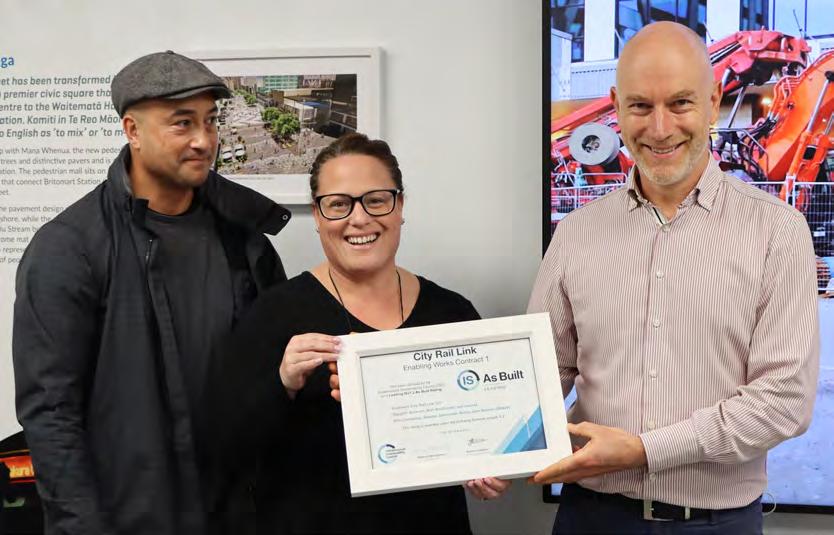
C1 ISC Leading As Built Rating
Paora Puru and Josie Wall - Mana Whenua, and Nick Braxton - CRL Ltd
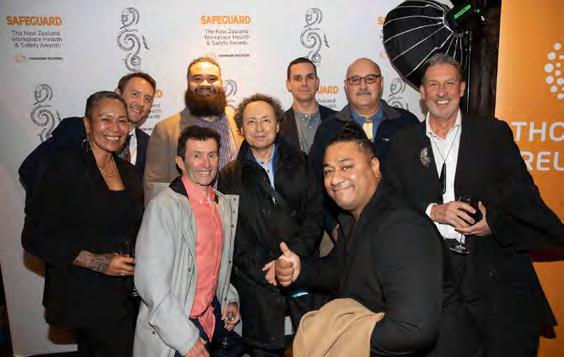
NZ Safety Blackwoods Workplace Health & Safety Engagement Award
Francois Dudouit, Project Director with the Link Alliance Health and Safety team members

Excellence in Social Outcomes – Highly Commended Award
Infrastructure Sustainability Council
Kerry Griffiths - ISC, Ainsley Simpson - ISC, Berenize Peita - Link Alliance
Social Outcomes Legacy Manager, Tom Young - ISC
Safety in numbers 2022*
5,369,634 hours worked
2,672 workers inducted onto the CRL project
878 safety toolbox talks delivered
1,285 safety improvement suggestions or observations received
740 site safety inspections completed
60 health and wellbeing events held
124 heavy goods vehicle safety checks conducted
77 safety leadership tours conducted
1,836 drug and alcohol monitoring tests completed
*Data for January to December 2022

Health & Safety
CRL Ltd aspires to health and safety (H&S) excellence in everything we do. This is an ambitious and challenging goal, and one which requires continued effort and focus from everyone involved.
CRL Ltd and Link Alliance's Health and Safety Strategy 2022-24 sets out our vision 'Mahia te mahi, hei painga hei oranga mo tātou katoa (to do the work for the good of everyone').
Four strategic priorities have been identified to achieve this vision:
• Partner to ensure and drive continuous H&S improvement
• Build and maintain workforce resilience
• Develop and enhance safety leadership capacity and supervisory competence throughout the workforce
• Enhance the maturity and effectiveness of the H&S management system.
Our approach to H&S management encompassed programmes of work under each of these strategic priorities. We work closely with construction delivery partners and industry stakeholders to ensure a strong H&S culture and framework is implemented across all areas of the project.
Link Alliance is the main construction partner for CRL Ltd and its first objective is to ‘achieve
industry-leading standards for health, safety and wellbeing’.
Link Alliance continues to invest in training their teams, including over 75 staff completing the Frontline Safety Leadership Programme, the largest ever rollout of the ‘Alive on Site’ behavioural safety initiative, and a health monitoring programme.
The focus has been on ensuring all teams have the correct competencies to manage their works safely above and below ground. This is vitally important to manage critical risks on site: work at heights, confined space, incident reporting and working in a tunnel environment.
CRL Ltd continued to monitor and support the delivery of safety excellence across the project through site visits, engagement with workers and frontline supervisors and highlighting and recognising both good and poor practice where it is seen. CRL Ltd is grateful to its construction partners for their commitment to achieving the shared health and safety goals.
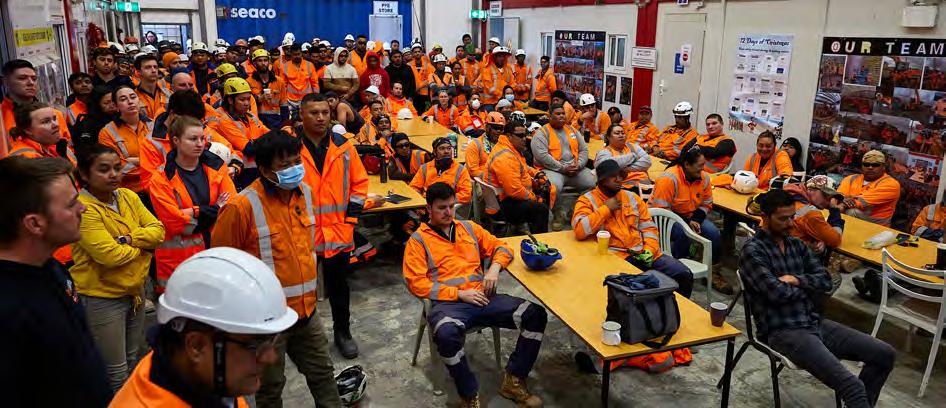
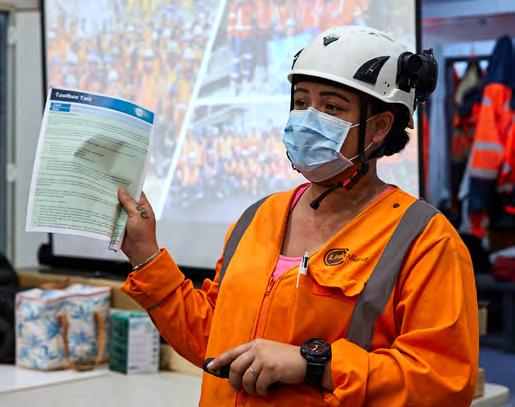
Enhancing health and safety management systems
Risk Management Maturity Model
A H&S management system provides the framework to enable consistent and predictable H&S performance. It includes defined methods to keep people safe and a means for managing significant risks.
CRL Ltd uses the Risk Management Maturity Model (RM3) to assess its H&S management systems. RM3 has built-in mechanisms to continue pushing the envelope, using 26 individual H&S indicators to identify opportunities to learn and improve how H&S outcomes are delivered. This provides a common platform to identify safety improvements, and to drive excellent H&S outcomes with our suppliers.
Assessment is made against five maturity levels for each H&S indicator. They range from 'adhoc' through to 'excellent'. The results can be used to objectively identify management strengths and weaknesses and to support focused improvements.
Under RM3 the project will continue to review and improve its H&S systems while delivering welldefined, consistent and replicable outcomes that
can be externally verified. We want our people to know what the expected outcomes are, what they are responsible for, and to work together to continue achieving H&S excellence with no gaps, overlap, or duplication.
CRL Ltd and its construction partner Link Alliance completed the project's third annual independent RM3 assessment in 2022. The assessment included interviews, reviews of safety plans and procedures, and on-site observations.
The project achieved a level 3/5 (Standardised) in all areas, with level 4/5 (Predictable) achieved in 11 areas. This means that 'good practice has been synthesised into standard processes'.
The RM3 assessment identified areas of strength, for example governance, organisational structure and control of contractors and where further improvements can be made for the maturity of safety management systems. These include emergency planning, competence management and incident investigation.
CRL Ltd and its construction partners developed a targeted 12-month improvement programme based on the assessment's findings. The next assessment will be in June 2023 and will review progress.
Weighted average of CRL Ltd and its construction partners' RM3 results
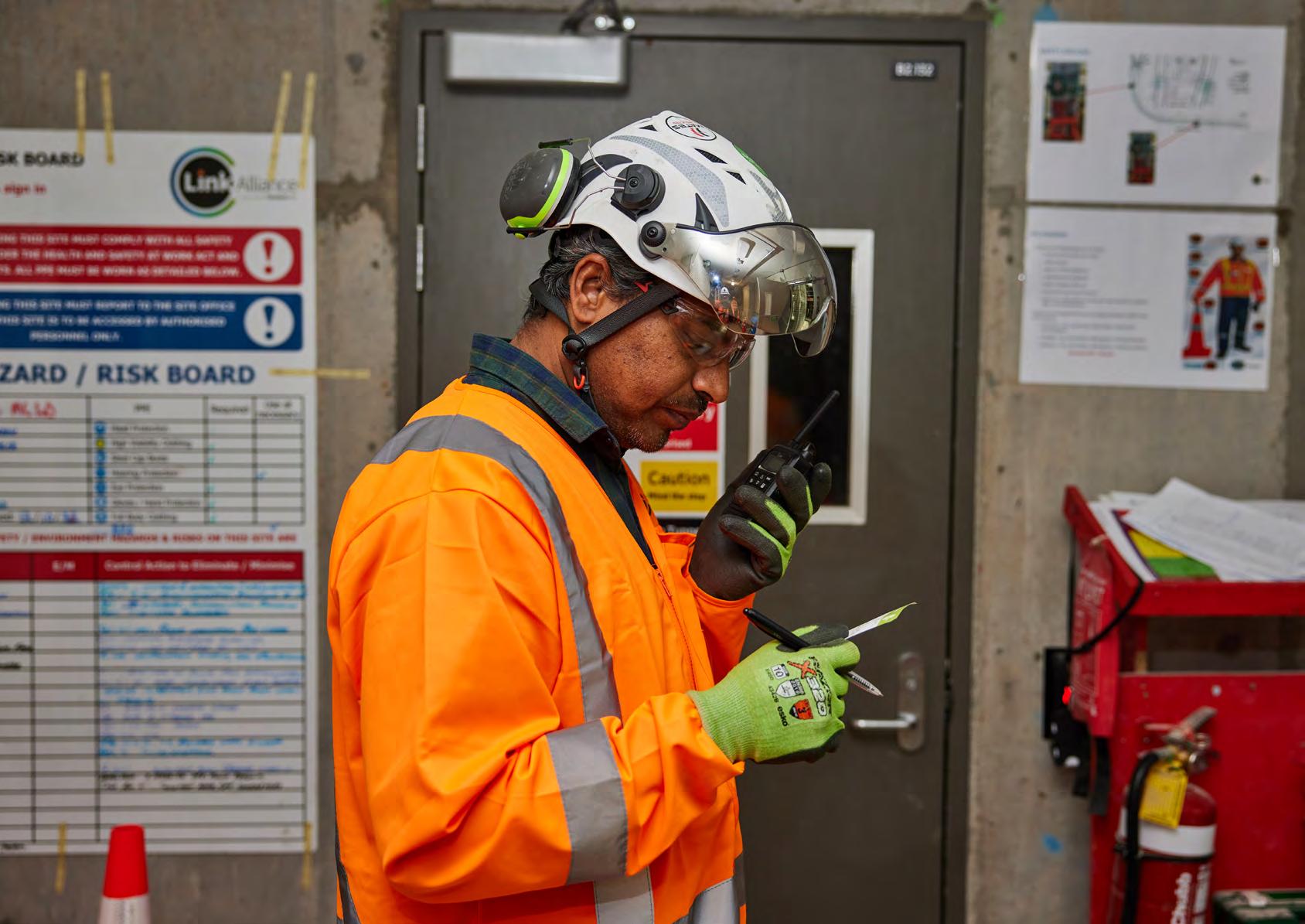 Worker checks his radio before heading underground
Worker checks his radio before heading underground

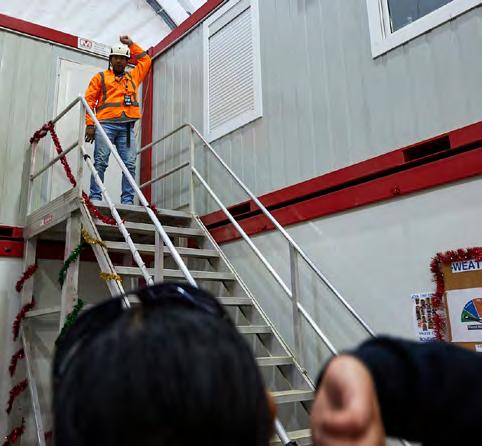
Support and embed safer working behaviours
During 2022, Link Alliance developed and implemented a revised project induction safety training module which is delivered to all workers inducted onto the CRL project.
The training course, entitled ‘Mata Whānui ti Tirohanga – to look beyond’, describes the five H&S Principles to keep our worksites safe:
• We all take responsibility for safety
• We make sure we understand the plan
• If the work changes, we stop, regroup, and make a new plan
• We look out for ourselves and each other, and stop any work that is unsafe
• We are always fit for work and free from drugs and alcohol.
The project H&S representatives were central to the work to design these H&S Principles and to create a training course with impact, relevance and meaning for those working on site. This training intervention was shortlisted in the National Safeguard H&S Awards under the ‘worker engagement’ category for the leading role the H&S representatives had in its design.
The principles have been further embedded on the project through recognition of workers commitment to the principles through weekly safety awards and an annual H&S Champion Award at each site.
Establish improved health and safety performance measurements
Health and safety performance index
CRL Ltd monitors 26 individual H&S performance indicators which cover all activities from design through to commissioning that are critical for the project to effectively manage potential H&S risks.
Proactive or 'leading' indicators, such as heavy goods vehicle safety checks, are also recorded along with reactive or 'lagging' measures including near misses. Monitoring creates a detailed and accurate picture of the project's H&S performance.
To manage the large amounts of H&S data and identify key trends, CRL Ltd developed a H&S Performance Index (HSPI). The HSPI categorises each indicator against the H&S management system and assigns weighting based on how critical that activity is for the management of risk. A score is then produced that illustrates how well the project has performed against pre-determined targets.
The HSPI has produced an accurate picture of H&S performance which can be easily communicated to stakeholders as well as to workers and site team leaders. The Link Alliance has not always met the monthly performance target index of 80 during the year with an average score of 73 for 2022. Link Alliance continue to review their safety management programme to drive continuous improvement in the management of H&S. The indicators used to monitor H&S performance will be reviewed in 2023.
CRL Ltd also tracks injury frequency rates such as the Total Recordable Injury Frequency Rate (TRIFR) for external benchmarking purposes.
CASE STUDY
Safety leadership training
In 2022 an integral part of Link Alliance H&S continuous improvement programme was the start of an industry-leading H&S training programme to 150 frontline Link Alliance leaders and supervisors.
Frontline managers have a critical role in ensuring a safe work area and leading the team on the safe delivery of work. Given the size and scale of the project, not all frontline leaders have had previous formal supervisor training, and some have recently been promoted into positions of responsibility.
Working closely with Construction Health and Safety NZ, which undertook an in-depth assessment of the different safety courses available for front line leaders, Link Alliance participated in a trial in late 2021 to decide which training course delivered the maximum benefit to Link Alliance leaders.
Safety Futures, an international safety training consultancy which works worldwide across high hazard industries, was chosen as a Link Alliance partner. A programme providing comprehensive and practical training specifically targeted at supervisors and was highly relevant for the complex activities and environments found on the CRL project was selected.
The content is delivered through a series of online lectures with an accompanying weekly ‘mission’ for the workers to apply to the work site over a 12-week period. Progressive learning builds over the three months, and is in a flexible format. Lectures are recorded to allow workers to watch in their own time if they cannot dial into the module live. Individuals are supported through the programme, with help accessing the material online and time away from their day-to-day duties.
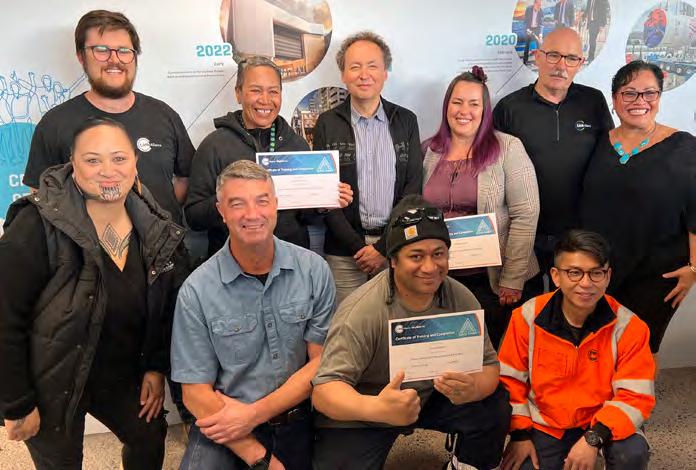
The programme extends to suppliers and subcontractors. Link Alliance recognises that we will only achieve industry leading standards of H&S if everyone works together and invests in all workers. He waka eke noa – we are one team. Frontline supervisors will take this knowledge with them, thereby contributing towards a positive legacy for the construction industry in New Zealand.
CASE STUDY
‘Alive on Site’ training
In September 2022, ‘Alive on Site’ behavioural safety training was rolled out within Link Alliance to more than 650 workers over a 3-week period. Designed by Vinci and successfully delivered globally, this innovative programme was introduced at CRL for the first time. This project is the largest application of the programme that has been delivered to date.
Work was filmed on site using a go-pro, covering all areas and all sites. This footage was edited into a short 10-minute film and is an example of a hands-on, practical training programme that is beneficial for overcoming language barriers between workers on site.
Each site provides a small team of 10-15 people to review the footage and analyse good and not-so-good practices, identifying opportunities to work in a safer way. In these groups, the learnings were discussed and prioritised. This provides a common platform to identify safe and unsafe conditions and practices in a consistent and memorable way. The training received positive feedback and workers enjoyed the training.
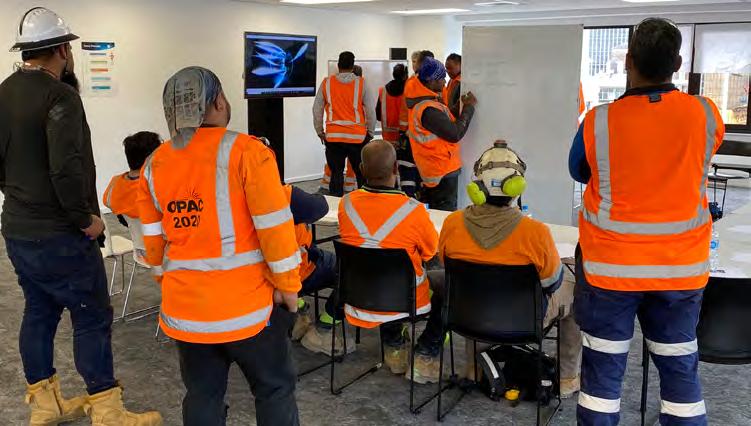
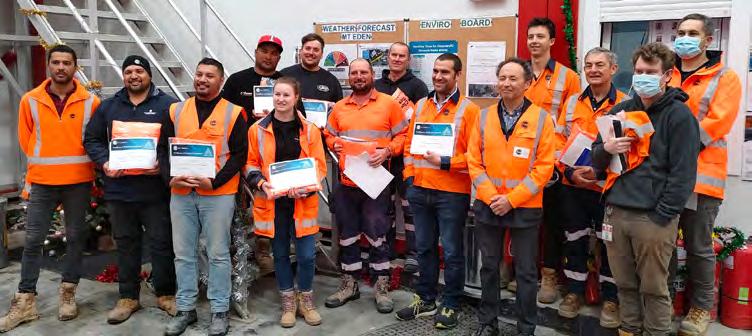

CASE STUDY
Critical risk reviews
Critical risk reviews are part of a suite of monitoring for H&S on a weekly basis. The purpose is to ensure that the management system controls and protections in place are present and working for the higher risk activities that are occurring across each site. Each week across all sites the construction superintendent, engineering team and the H&S team look at what work is underway and identify any critical risks.
Critical risks are any hazards that have the potential to seriously injure anyone on site. The team pull out the construction work pack and Job Safety & Environmental Analysis (JSEA), identify the hazards and controls
needed to be put in place and, as a group, observe the work happening in a specific area and talk to workers to ensure those controls are present and working effectively. If any issues are raised, new controls are put in place and if that’s not possible discussions with the supervisor about alternatives are held.
This process assists supervisors into a H&S mindset, which is reinforced with the Frontline Leadership Programme for supervisors. The results show a greater ownership and awareness of critical risk controls by frontline delivery teams.
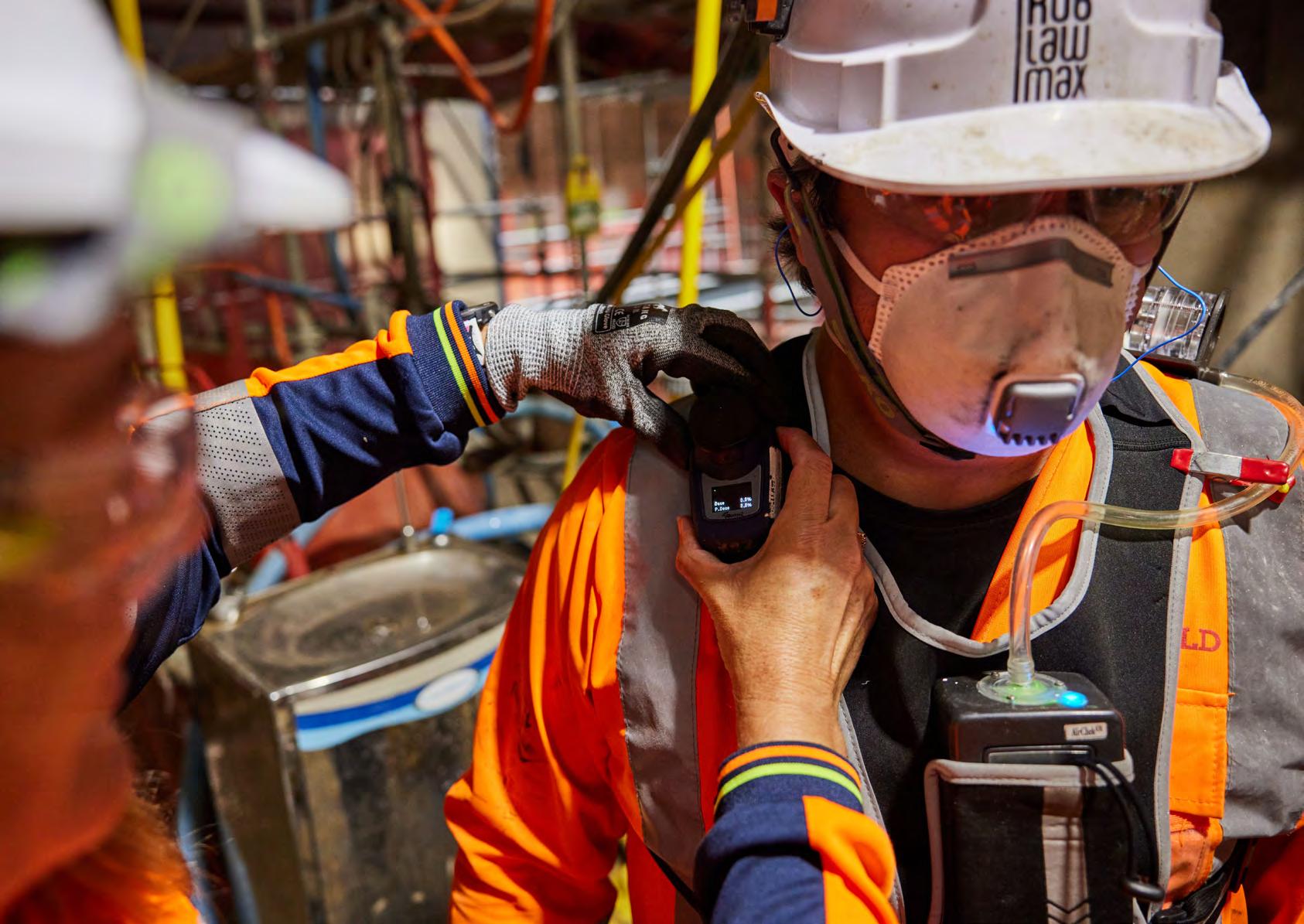

CASE STUDY
Annual health monitoring
Link Alliance manages a programme of occupational health monitoring. The purpose of this is to monitor workers’ potential exposure to harmful hazardous substances. A confidential health monitoring programme is offered to all team members at the various sites. This is for those team members whose employer has not already provided the health monitoring.
Link Alliance recognises the importance of a safe and healthy workplace and understands there are both short and long-term health hazards involved with working in construction. Long term health hazards include exposure to noise, vibration, silica, dust, fumes, and other hazardous substances.
Link Alliance has engaged an Occupational Hygienist who works collaboratively at each site to design a programme of regular exposure monitoring. This is based on the work being conducted and by identifying the most significant hazards at each site – e.g. noise and presence of harmful dust. The data is compared with industry best practice and workplace exposure standards set by WorkSafe. Controls are constantly reviewed and improved upon to minimise the risk of exposure.
Environment in numbers 2022*
2,569 ground and building movement monitoring points installed
400 environmental site inspections completed
25 noise and vibration monitors installed
66 environmental management plans approved
>31 stormwater catch pits protected
7 water treatment plants installed
104 piezometers installed
9 air quality monitors installed
*Data for January to December 2022

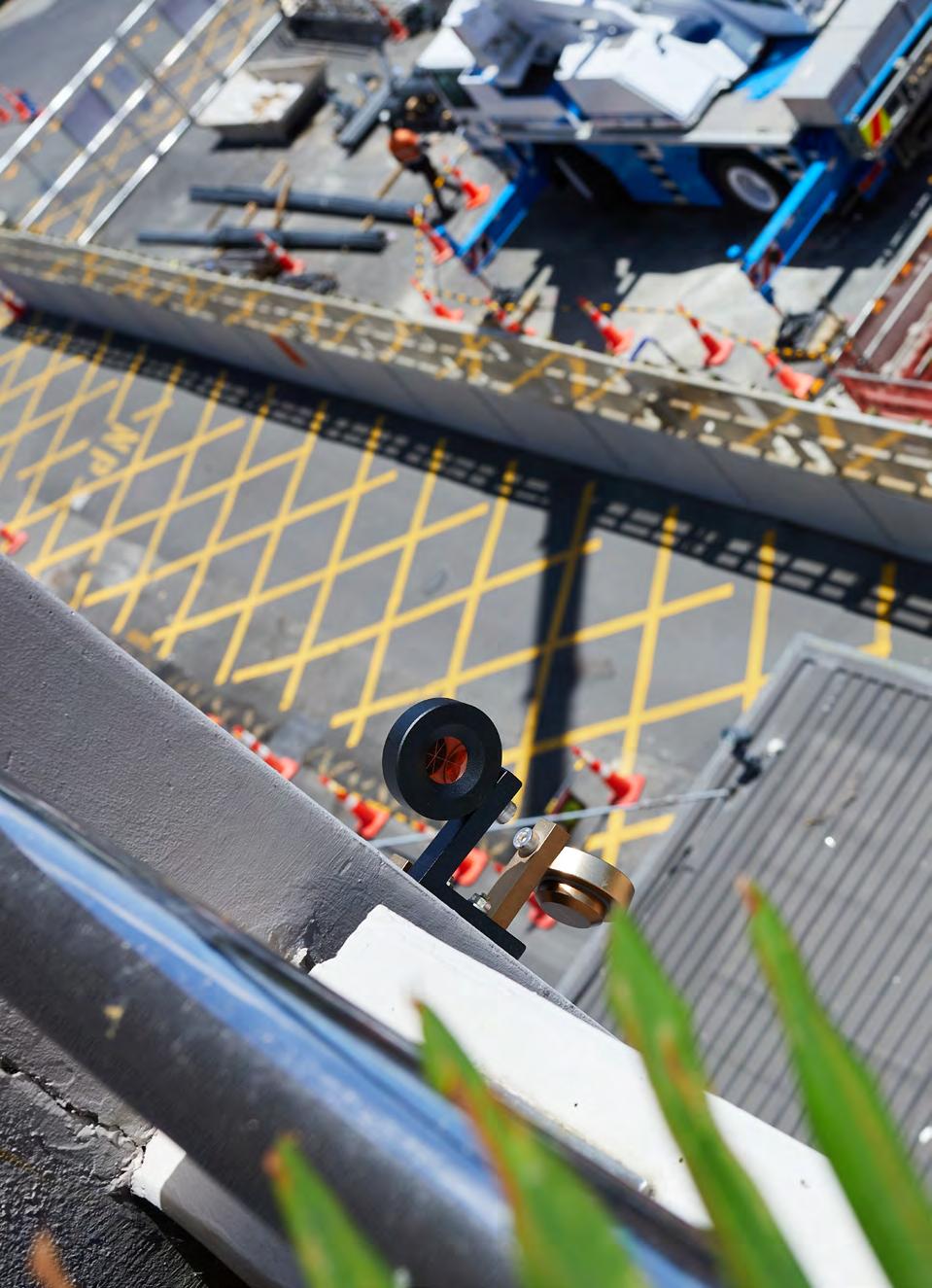
Environment
There are thousands of fixed monitors in place around CRL construction sites to measure air and water quality, noise, vibration, ground settlement and groundwater levels in real time 24 hours a day, seven days a week.
The monitoring network is complemented with targeted site or activity-based inspections that occur daily, weekly and monthly. If the project exceeds limits, changes to practices and procedures are made as quickly as practicable.
CRL Ltd and its construction partners work to comply with more than 500 separate conditions relating to eight designations and numerous resource consents from Auckland Council. It must also comply with archaeological authorities obtained from Heritage New Zealand.
These conditions provide the parameters and limits of effects that CRL construction and operation can have on the project's surrounding environment and communities.
Management plans continue to govern the actions the project takes to meet requirements and achieve environmental compliance. As the project progresses the environmental team is becoming more adept at implementation of these measures, learning from their experience working on a project of such scale.
Management plans provide detail on the practices and procedures to be followed and provide a comprehensive framework to manage adverse effects on the environment including:
• Noise and vibration
• Traffic access and parking
• Social impacts and business disruption
• Discharges to air, land and water.
 Link Alliance members put in earplugs and lay noise dampening mats
Link Alliance members put in earplugs and lay noise dampening mats
Noise and vibration
Link Alliance’s Noise and Vibration Management Plan provides detail on the noise and vibration monitoring and management practices and procedures to be followed. This is a working plan that is revised each year to ensure our project activities continue to meet requirements and achieve environmental compliance.
The project monitors noise and vibration in real time 24 hours a day, seven days a week. There are 25 noise monitors and vibration monitors across the project. Project works have the potential to exceed construction noise and vibration limits at the closest monitors. Appropriate mitigation methods and measures are utilised to avoid or minimise exceedances. Methods to achieve best practicable options for mitigating adverse effects during the construction work include:
• Staff training
• Selecting plant and equipment with low noise and vibration emission levels
• Turning off plant and equipment or throttling them down to a minimum when not in use
• Selecting appropriately sized equipment for the task
• Using noise barriers or enclosures in areas where the noise limits are predicted to be exceeded, and where they provide effective mitigation.
Scheduling of construction activities is a key tool for managing construction noise and vibration effects. The time of day and the duration of the construction activities can be adjusted after consultation, where possible, to avoid particularly sensitive times for people impacted. Good stakeholder communication practices are a key component for the management of noise disruption from construction activities. If there are noise or vibration exceedances, changes to practices and procedures are made to maintain compliance.
Supporting our communities
CRL Ltd and its contractors continued their focus on proactive management of construction effects throughout 2022 to minimise impacts on nearby neighbours.
Following a successful pilot programme in 2021, the Small Business Support Programme (SBSP) returned in 2022. Business owners took advantage of independent business advice and a microgrant to innovate and adapt their business to the construction environment.
In response to feedback received during the pilot, the value of the micro-grant was increased from $2,000 to $3,000 per business. The six categories of support remained the same as 2021 - digital marketing, outdoor dining, business adaptation, activations/events, marketing and collateral and wellbeing.
Approximately 50 businesses took advantage of the SBSP in 2022, an increase of 25% on the pilot year. Installation of strategic rebranding to attract new customers and the development of haircare products for a barbershop are just a few of the successful SBSP applications.
Maungawhau Station’s stakeholder wellbeing programme relaunched in 2022 and the offering was expanded to Karanga-a-Hape Station residents. The programme provided a quiet space for residents and wellbeing activities such as yoga, mindfulness and meditation.
However, in the changing climate with many residents and neighbours returning to work, uptake was low and the programme was discontinued.
A range of other initiatives were offered to Maungawhau residents, with a focus on the most disruptive Christmas/New Year BOL programme, including local restaurant vouchers, free ice-cream, temporary respite and movies at the CRL Visitor Centre in Te Manawa over the holidays for the younger members of the family.
Within the Karanga-a-Hape Station precinct, the easing of Covid-19 restrictions facilitated a comprehensive programme of events at the Pocket Park on the corner of Karangahape Road and Pitt Street.
These events, delivered in partnership with the Karangahape Business Association, included the hugely popular First Thursday market and ‘Fab It
Up’ (a day of pampering for street whānau on World Homeless Day).
Heavy civil works continued throughout the year and therefore many solid hoardings remained in place. However, some hoarding artwork was updated across the sites and lighting added where needed to ensure safety, security and amenity around the site perimeters. Where possible, solid hoardings were repurposed or repositioned prior to the commissioning of new artwork. Neon lighting features were added in the Te Waihorotiu Station and Karanga-a-Hape Station precincts, with a huge ‘Support Local’ neon sign installed on Victoria Street to entice customers from Queen Street, welcomed by the local business association.
Te Waihorotiu Station started a ‘support local and win’ campaign whereby customers spent $5 or more at a participating business to go into a monthly draw to win $100 to spend at a local midtown business. A grand prize of an underground station tour was offered quarterly. The easing of Covid-19 restrictions enabled many impacted neighbours to visit City Rail Link sites, providing an insight into the construction happening beneath their businesses.
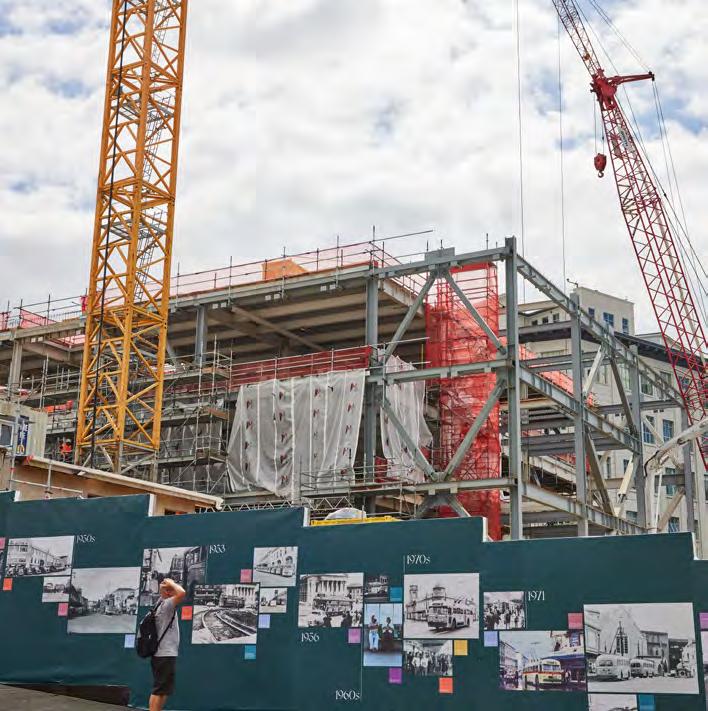
Large-scale activations in 2022 included Branch Out in the Maungawhau Station area, a spring celebration involving businesses along Normanby and Enfield streets, who had been affected by the closure of the Normanby Road Bridge necessary for construction. Similar to Aroha in Uptown, Branch Out is intended to become an annual spring event.
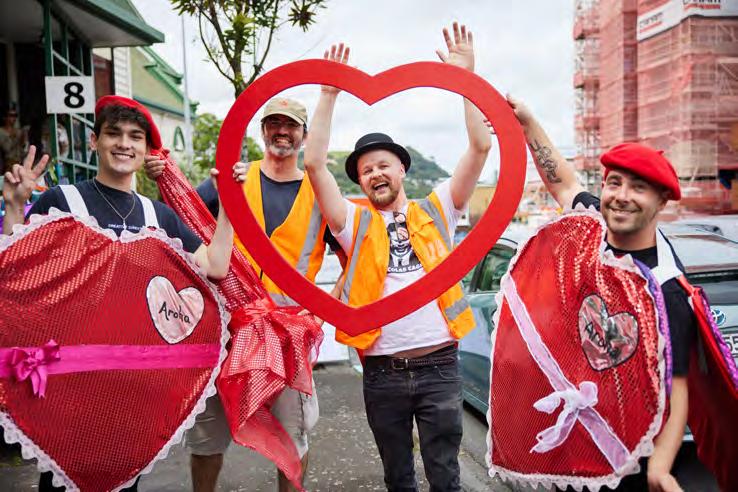
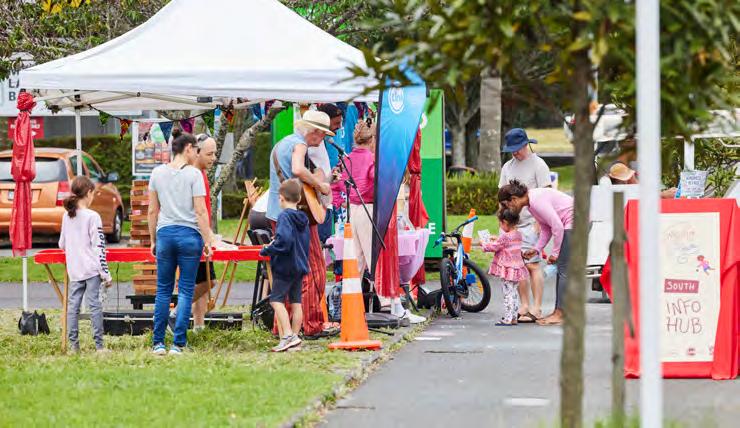
Small Business Support Programme
The SBSP is a targeted, individualised support programme for small businesses in the Te Waihorotiu Station and Karanga-a-Hape Station communities. Both communities are experiencing disruption from the construction of the CRL.
SBSP objectives include offering practical and immediate ways to support businesses during construction, encouraging businesses to build resilience and capacity, by providing independent advice and incentives to adapt and helping to build positive relationships between the business community and Link Alliance.
The SBSP was developed with the input and support of the area’s two business associations – Heart of the City and Karangahape Road Business Association and is designed to support and enhance existing financial support programmes offered by local and central government organisations.
Barber – 27 Victoria St West
Belgar Barbers opened in May 2022 on Victoria Street immediately adjacent to the station construction site. Significant excavation was taking place with trucks regularly entering and exiting the site, as well as structural construction nearby. The business is located near fencing covered with noise mats and scrim, which at times obstructs natural lighting and pedestrian sight lines.

The Belgar Barbers used the SBSP support and microgrant to enhance the shop front façade, with a new logo and a large neon sign and wall of greenery on the rear wall that can also be used for client selfies. The balance of the microgrant was used for a new hair and cosmetic product range, new digital content, branding, and shop front imagery across web and social media.
Owner Hani (Adam) Alabboodi says “The SBSP funds helped me grow the company, especially as I was doing this business on my own. I was a new migrant to New Zealand and was not very familiar with operating a business here but support from the independent business connector enabled me to succeed and do everything according to correct legal business processes and within New Zealand hairdressing industry standards.”
The neon sign and the new product range was a fast and effective way to boost business turnover and build its reputation, despite nearby construction. The SBSP support and funding has contributed to a tripling
of Belgar Barbers client base by boosting its physical and online presence to attract new customers. These include guests from the President Hotel next door, as well as pedestrians, and many Link Alliance workers now getting their hair cut here too. This success has resulted in staff increasing from two full time barbers to six barbers (three full-time and three part-time).
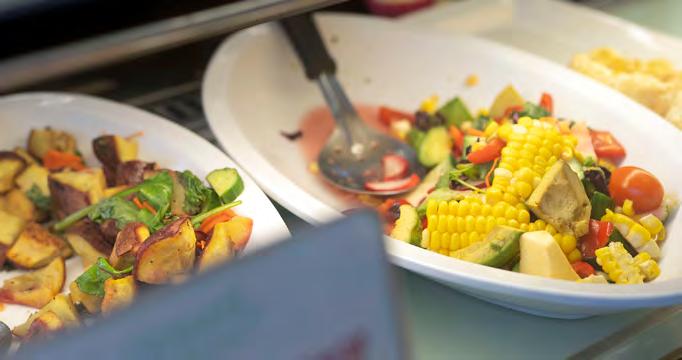
Peppers Café - 99 Albert Street
Peppers is a small café offering a variety of well-priced takeaway café food, coffee and beverage staples with fast service, operating from early morning to mid-afternoon, with four small outdoor dining tables.
Peppers opened in 2008 on Albert Street before construction began. During station construction, the cafe experienced several pedestrian and traffic diversions and temporarily lost access to a nearby loading zone. Ongoing noise from trucks and machinery during excavation outside their business was also an issue. Sometimes, fencing and noise mats have impacted sight lines and natural light, while a busy bus stop had been temporarily moved away from the cafe.
The SBSP was used to upgrade to a new chiller unit allowing the cafe to expand its food range to include more Asian food options. This new offering made the shop more appealing to new customers and helped the business adapt to an increase in construction workers in the area, many of whom love Asian food. The new chiller also keeps food fresh for longer, reducing wastage and sunk costs.
Owner Sam Shum says “The SBSP was crucial in helping my business maintain profitability despite ongoing construction. The improved chiller unit has greatly helped me and my wife as we knew the food would stay fresh till closing, and we are very encouraged by the large increase in compliments received from new and existing customers. The SBSP has been awesome in supporting us during this difficult season of construction impacts. The SBSP independent business consultant has been very helpful in giving encouraging business advice, as well as taking care of the application process from start to finish. The process meant that I felt confident in my decisions going forward in my business.”
The chiller upgrade was a quick and effective business resilience and capability booster - despite construction, new customers were attracted to visit and return to the cafe. The SBSP offering also improved the relationship between Link Alliance and the business owner – especially since many construction workers are cafe patrons.
Despite the challenges of construction and Covid-19 participation in the SBSP has helped Peppers Café improve business turnover, with new customers doubling in numbers since implementation, enabling Peppers to remain open in uncertain times.
Air quality
Construction and Air Quality
Emissions to air from construction activities predominantly involve dust and particulate matter from land preparation (e.g. demolition, land clearing and earth moving) and construction. Dust emissions vary substantially both spatially and temporally, depending on the nature and scale of construction operations and activities being undertaken as well as weather conditions. A large proportion of the emissions often result from site plant and road vehicles moving over temporary haul roads and open ground, particularly unsealed surfaces. Construction-related air quality impacts often relate to the impacts of visible dust plumes or dust deposition.
Why Measure Air Quality?
Continuous, real-time air quality monitors are used around all our construction sites to ensure the mitigation measures, such as dust suppression, are working effectively. Additional mitigation measures are put in place if dust concentrations become too high. Daily and weekly visual inspections are also carried out at each site to check there are no visible dust plumes.
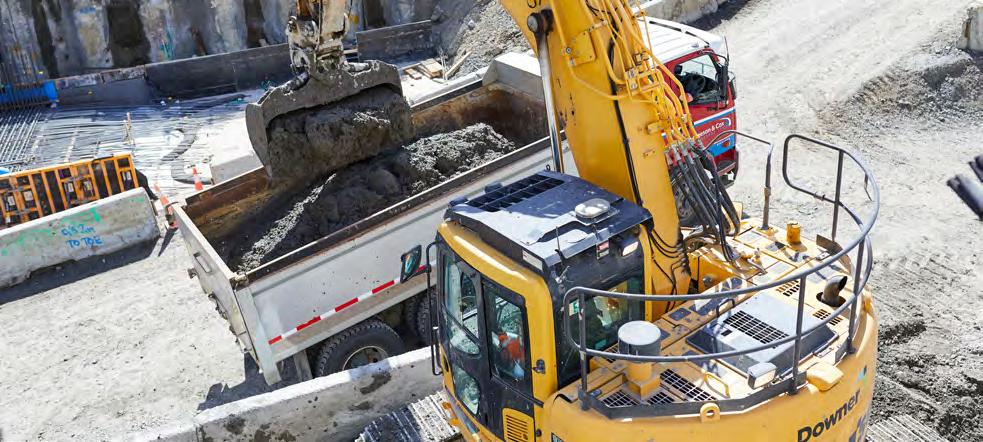
Why Measure Wind and Rain?
Measuring wind speed and wind direction helps to identify emission source locations and provides a better overall picture of how air pollutants disperse and where potential impacts might occur. Measuring rainfall, in addition to wind speed, helps identify dry and windy conditions, which are often associated with higher dust emissions. This allows for better decision-making to protect human health and the environment.
Why Predict Dust Risk?
A numerical weather prediction model is run at the start of each workday to calculate the dust risk at the sites. This ensures appropriate dust mitigation measures are in place and reduces potential impacts in the community. A higher level of dust mitigation is required to be implemented on days when a high dust risk is predicted, ensuring air quality impacts due to our activities do not occur.
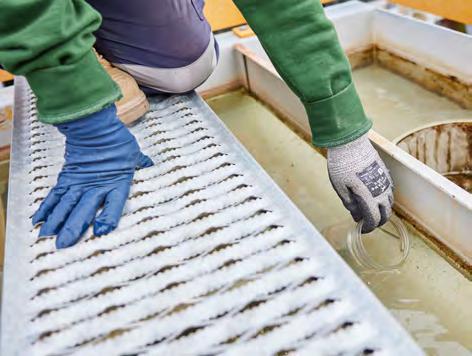
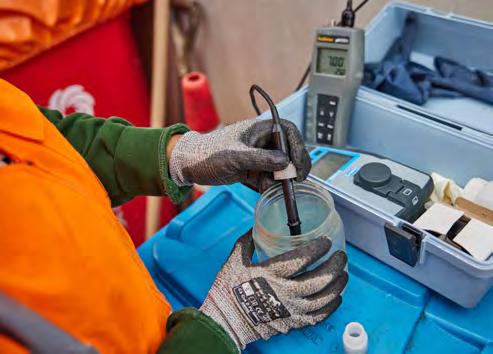
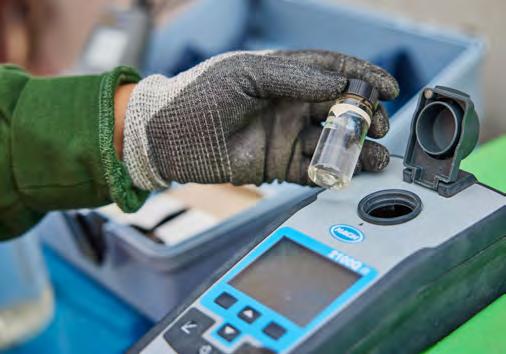
Erosion and sediment control
Each Link Alliance site has a site-specific Construction Erosion and Sediment Control Plan (CESCP). These plans set out erosion and sediment controls for implementation that help to reduce the risk of discharging dirty water into the stormwater system, thereby protecting the environment.
Controls include diversion bunds, water treatment plants (WTP's) and stormwater catch-pit protection:
• Diversion bunds are installed around the perimeter of all sites. They direct clean water runoff around the site, while at the same time ensuring dirty water runoff from the disturbed areas of the site is retained onsite, where it is directed to the water treatment plant for treatment. Some areas have bunds made with asphalt, and others use silt socks (3m long and 30cm diameter socks typically made from
polypropylene fabric and filled with a range of mediums such as sand, gravel, or wood chips).
• WTPs are the primary systems to treat water before being discharged into the stormwater system. These plants reduce the sediment load and treat water for high pH (due to concrete works). Across the stations, there are six WTPs; two of which are specifically designed to treat mined water (Karanga-a-Hape Station WTP and Maungawhau Station WTP). The WTPs are monitored constantly to ensure they are working
correctly and any discharge complies with resource consent requirements.
• Stormwater catchpit protection is installed as a secondary control measure to reduce contaminants entering the stormwater system. For this, filter pods, a prefabricated drop-in catchpit filter made from geotextile, are installed into existing catchpits. The filter pod allows water to pass through, filtering and trapping sediment in the bag. The bags are replaced frequently, in some sites, every 3-4 weeks.
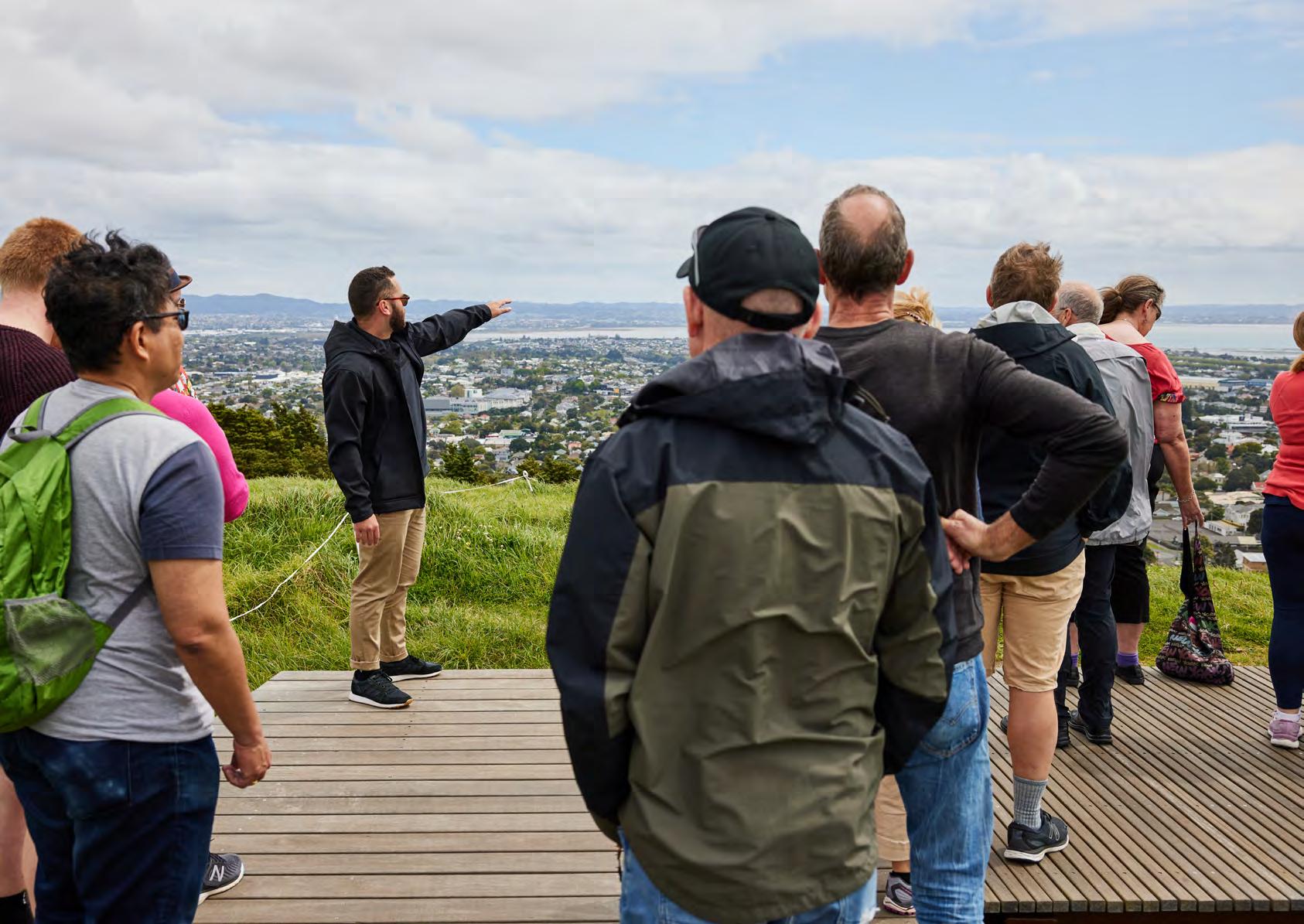 Heritage and archaeology tour at Maungawhau
Heritage and archaeology tour at Maungawhau
Heritage and archaeology
The project continued its commitment to preserving and protecting culture, heritage, and local character while the City Rail Link is built. With tunnel-boring completed in 2022, there were no additional archaeological discoveries.
An Archaeological Authority has been granted by Heritage NZ for works across all three stations. All archaeological evidence previously encountered during works has been investigated, recorded and analysed.
In 2022, our focus turned to celebrating the heritage of CRL sites as part of the Auckland Heritage Festival in October, which explored the topography, taonga (treasures) and trailblazers of Tāmaki Makaurau.
This included:
• A heritage walk through Eden Terrace, exploring the past, present and future of Maungawhau Station. The event was organised in partnership with mana whenua and featured important stories and milestones that were significant to the formation of Tāmaki Makaurau
• A guided walk with historian Edward Bennett to find out about some of Auckland’s earliest key figures at Te Waihorotiu Station. Attendees heard about the visits to Auckland by Sarah Bernhardt, Pavlova and Gauguin, about the fire which destroyed the Auckland Opera House and the theft of the White Marble Polar Bear
• A discovery session looking at Tāmaki Makaurau’s unique topography gleaned from 127 core samples taken as part of CRL ground investigations
• A tour along and around Karangahape Road, moving through the history and architecture of a vibrant precinct which has transformed throughout the decades.
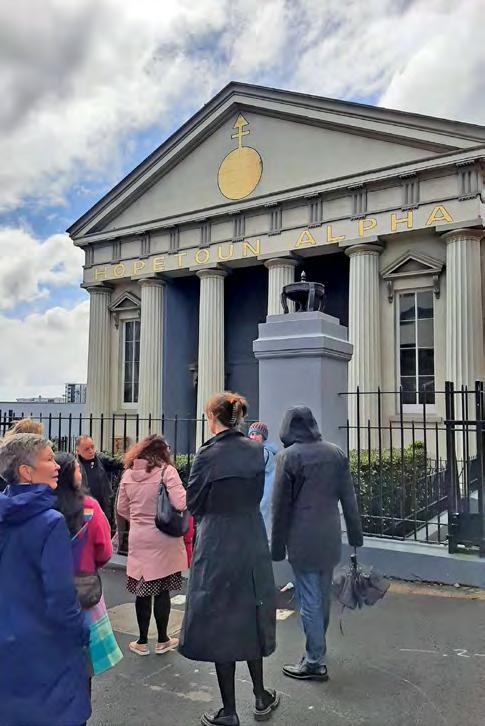
Sustainability in numbers
2022*
57,802 tonnes of waste diverted from landfillº
7%
5,262m3 of water captured and reused on site
29 rangatahi graduated the Progressive Employment Programme
completed the Sisterhood work experience programme of Link Alliance spend to Māori & Pasifika-owned sub-contractors & suppliers
8,170 truckloads of concrete effectively removed from the project's carbon footprint by replacing cement with fly-ash
6,508 tonnes of waste reused
8 students high school wāhine
300
toured CRL as part of the Link Alliance Education Engagement Programme
*Cumulative data for C3
ºexcludes 1,087,678 tonnes of spoil also diverted from municipal landfill
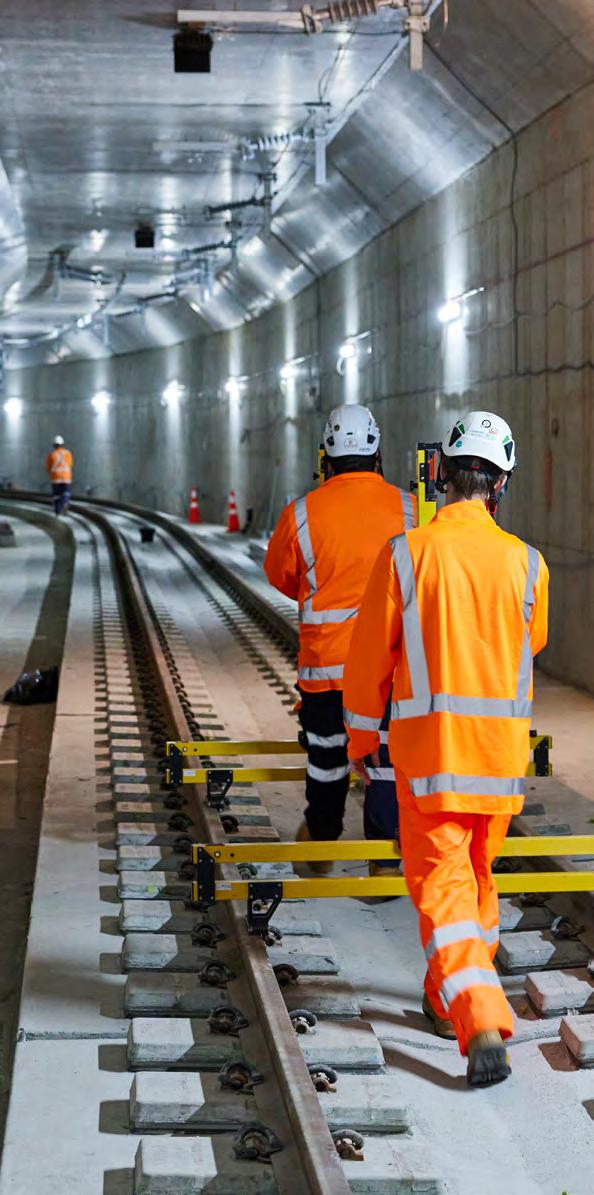
Sustainability
Reducing our carbon footprint, avoiding waste and leaving a positive social and cultural legacy for Tāmaki Makaurau are the key elements of City Rail Link’s aims for sustainability excellence. These aims inform all aspects of the project, from design, through construction and operation.
The project's sustainability performance is externally verified with the ISC, using their Infrastructure Sustainability rating tool, which has been adapted in partnership with mana whenua to respond to Aotearoa's unique cultural context.
In 2022, Link Alliance submitted an application with ISC for a Design rating verification of the main contract (C3), including the tunnel, three stations and western line connections. CRL Ltd was awarded a 'Leading' As Built rating - the highest rating achievable - for C1 works at Waitematā Station (Britomart) at the lower end of Queen Street. The C1 rating recognised the hard work and commitment of C1 contractor Downer Soletanche Bachy Joint Venture.
CRL Ltd’s Sustainability Strategy has five key focus areas:
• Reducing resource consumption
• Zero waste to landfill
• Social outcomes
• Mana whenua outcomes
• Governance and reporting.
A summary of progress across each of these areas is provided, using examples to illustrate how the project is working to create a new paradigm for delivering infrastructure sustainably.
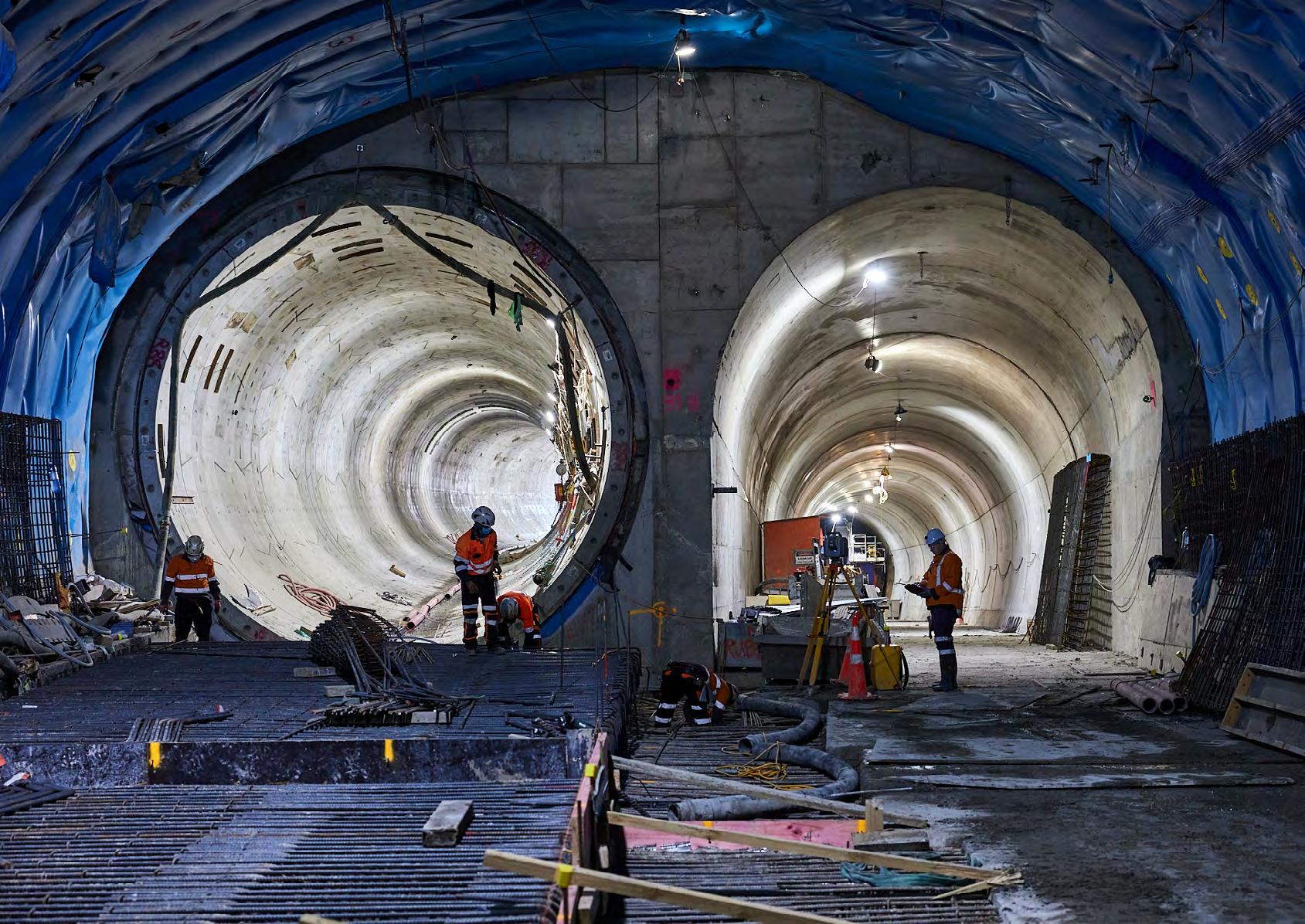 Entrance to tunnels at Maungawhau Station
Entrance to tunnels at Maungawhau Station
Reducing resource consumption: energy, materials and water
Building the CRL comes with a significant up-front carbon 'cost', both in energy-related greenhouse gas (GHG) emissions and the embodied carbon of the materials used during construction. Water is also required, both during construction and operation of the CRL.
The project aims to use the least amount of resources possible during construction and over the infrastructure's 100-year lifespan through efficient design and construction methodologies.
To track the project's success, an estimate called a Base Case has been created for each construction package. This measures the total amount of energy, materials and water that would be used to build and operate the CRL if business-as-usual occurred without sustainability interventions.
A Detailed Design, which includes initiatives to reduce resource consumption, is then developed. Comparison between the Detailed Design and the Base Case then enables the project to quantify improvements in resource use.
Contract 1 (C1) and Contract 2 (C2) have been completed with significant savings achieved and Contract 3 (C3) is on track for significant resource savings.
• C1 was awarded an Infrastructure Sustainability 'Leading' As Built rating – the highest possible.
• C2 was awarded an Infrastructure Sustainability 'Excellent' As Built rating.
Construction is well underway for C3 where the Link Alliance sustainability team have finalised Base Cases and Detailed Designs for each element, with an Infrastructure Sustainability 'Leading' Design rating currently being verified. Link Alliance continues to identify, implement, and measure progress to minimise resource use.
CASE STUDY
IS Design Rating
The ISC rating tool is being used to ensure sustainability is integrated into CRL construction. A two-step process is used; first assessing how well sustainability has been integrated into the project’s design and construction planning (the 'Design' Rating), and secondly assessing its success in delivering this at construction completion (the 'As Built' Rating).
In December 2022, Contract 3 (C3) received an independently verified Design Rating score of 93 from the ISC, corresponding to a 'Leading' Rating, the highest possible rating in the scheme.
Some key highlights from the Project’s IS Design Rating include:
Decision-making
Incorporating sustainability into decision-making has a big impact on final outcomes and was an important “credit” achieved in C3’s IS Design Rating. Sustainability has been incorporated into all levels of decision- making, including:
• Incorporating sustainability criteria into the multi-criteria analysis used for significant decisions
• Using a carbon price of $140/tCO2e (twice the current market level) to quantify the carbon footprint in decisions where a financial whole-of-life cost model was used
• Providing sustainability analysis for all formal design or construction changes (there have been over 1,000 of these since the start of the project)
• A 10% sustainability weighting when procuring materials or services that are likely to have a substantial impact on sustainability outcomes.
Climate Change assessment and adaptation
The CRL has a 100-year design life, so ensuring climate change was properly assessed and accounted for was a critical task addressed early in the design and recognised in the IS Rating. A key climate risk identified is the inundation of the tunnels from floodwater at Maungawhau Station, so the flood defences are designed to withstand a one-in-2,500 year event, as well as account for increased rainfall associated with climate change during the design life.
Carbon footprint
The scale of CRL means it has a significant up-front carbon footprint, despite contributing to Auckland’s carbon reduction efforts once operational. The IS Rating verified that a projected 60,500 tCO2e reduction in total carbon footprint over the CRL’s 100-year design lifespan was achieved during design, representing a 19% reduction and reducing the expected carbon payback time once the CRL is operational to under six years.
Decarbonisation measures that have contributed to this reduction include:
• Replacing cement in concrete with fly-ash – a waste product from coalfired power plants. The Project is on track to replace 22% of cement with fly-ash, reducing Link Alliance’s concrete emissions footprint by 18%
• Changing the mined tunnel designs to reduce excavation by 45% at Maungawhau Station and 11% at Karanga-a-Hape Station
• Using self-adjusting ‘smart’ lighting and ventilation systems to reduce station operational footprints by 7.6% and 9.8% respectively.
Social Outcomes
The IS Rating includes social as well as environmental criteria and awarded full points for the work undertaken to leave a lasting social legacy for those marginalised in the workforce, with a specific focus on mana whenua, Māori, Pasifika, and youth. Initiatives undertaken include:
• The Progressive Employment Programme (PEP) targeting Māori and Pasifika rangatahi who already possess entry-level skills, to acquire workready skills and sustainable employment
• Implementing career development, mentoring, training and pastoral care, leading to improved career pathways
• Facilitating opportunities for Māori and Pasifika businesses, social enterprises and socially innovative businesses to tender and win Link Alliance sub-contracts.
Innovation
The IS Rating awards 10 'bonus' points for innovations that lead to improved sustainability outcomes. Link Alliance was awarded full points for:
• Collaboration with mana whenua on the cultural narratives and designs of the stations, as well as embedding mana whenua cultural values across the IS rating framework itself
• Use of the 3D digital model to track the materials footprint as the design progressed
• Piloting battery-powered multi-service vehicles with regenerative braking to supply the tunnel boring machine instead of diesel machines, saving over 200tCO2e.

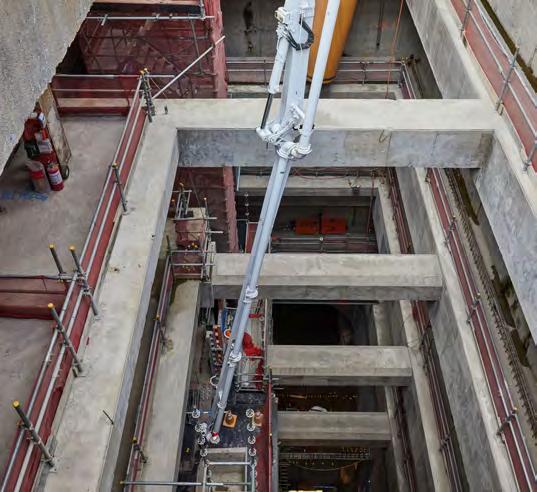
Energy
Whole-of-Life footprint
CRL’s energy footprint is comprised mainly of the diesel and electricity needed to construct, and then operate, the stations and tunnels throughout their 100-year design life. Link Alliance has a target of reducing the energy carbon footprint associated with these two phases by 25% compared to a business-as-usual Base Case.
Last year’s report outlined some of the initiatives taken to reduce the CRL’s energy footprint and the savings expected to be achieved. This projection has now been audited by greenhouse gas auditors Toitū and verified by the Infrastructure Sustainability
Council. As shown in the chart, the project expects to achieve a saving of just over 36,000 tCO2e of greenhouse gas emissions. This is a 21.4% saving and around 80% of this is expected to be achieved during the 100-year operational phase.
The total saving (construction and operation) is equivalent to just over 42,000 economy class flights between Auckland and London. The chart shows how these savings are expected to be achieved.
CRL Whole-of-Life Energy Savings
Energy-Related Greenhouse Gas Emissions
Tracking energy-related construction emissions to date shows the project doing slightly better than projected at this stage, with just over 30% savings compared to the Base case. However, some of these savings may be due to changes in programme as a result of Covid-19 and are therefore likely to reduce by construction completion. It is notable that to date almost half the emissions have been
a result of transporting the very large quantities of spoil excavated, while electricity emissions are comparatively small. This is due to Aotearoa's largely renewable energy supply, despite being used to power the tunnel boring machine.
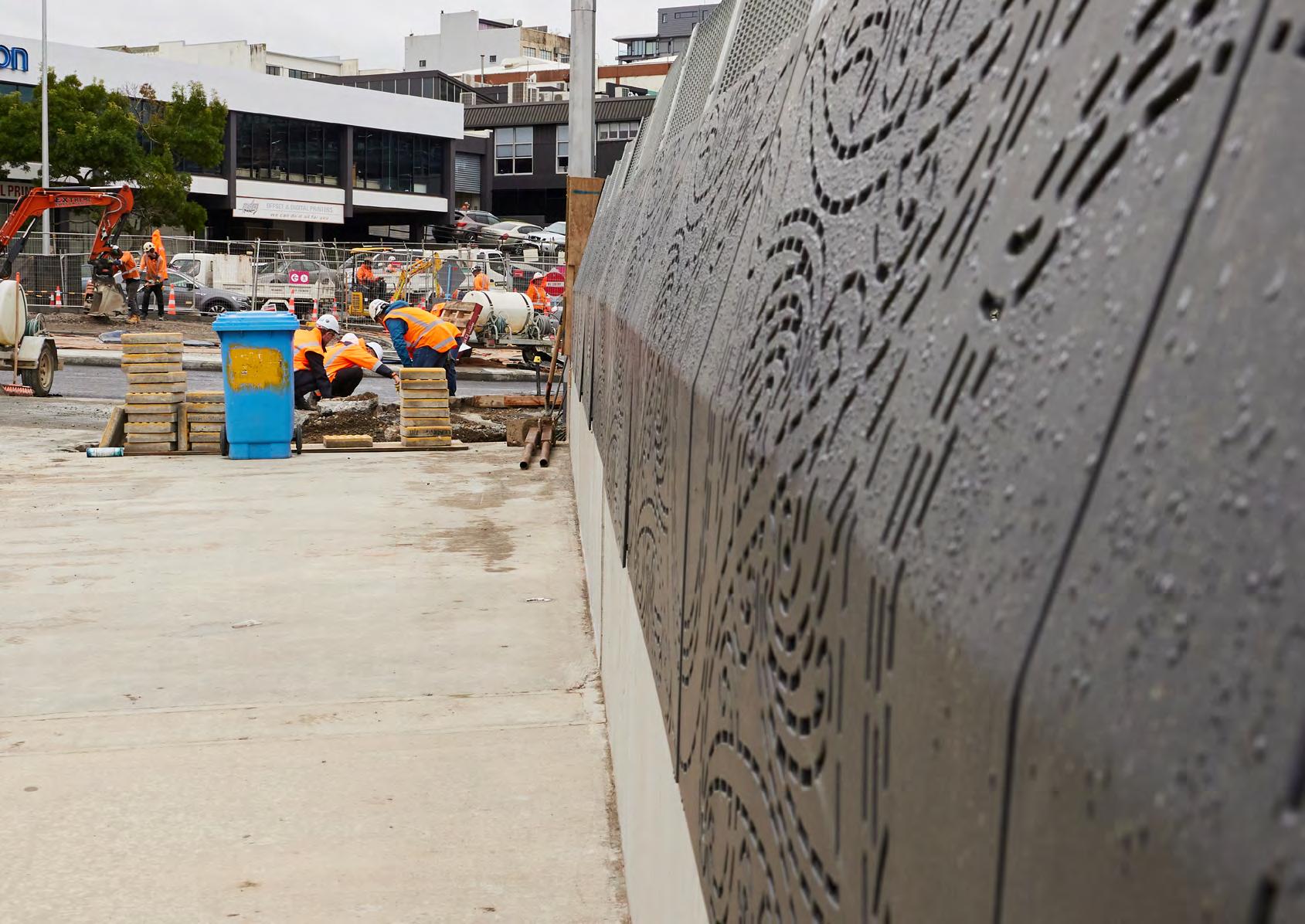
With last year’s report outlining the main initiatives undertaken, this year we look at the details of some of the specific initiatives that have contributed to the reduced construction footprint.
Installation of tactile pavers at Normanby Bridge Road crossing for the visually impaired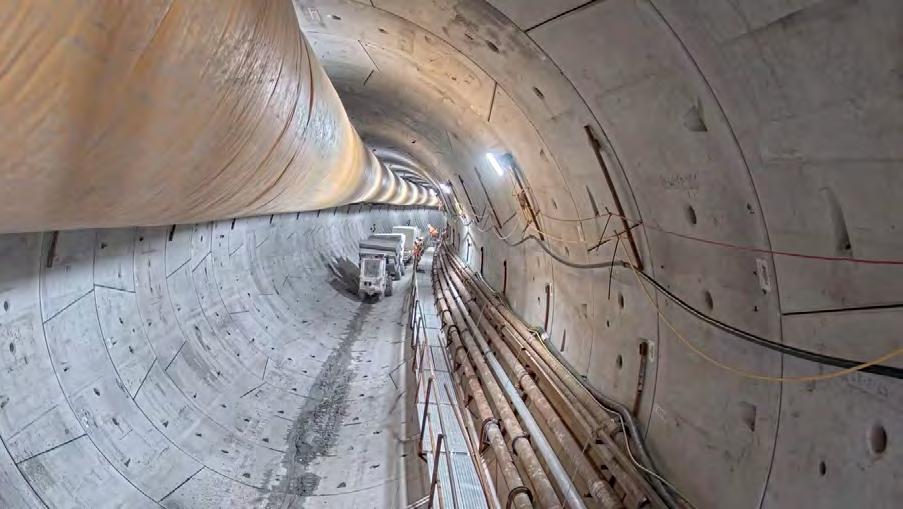
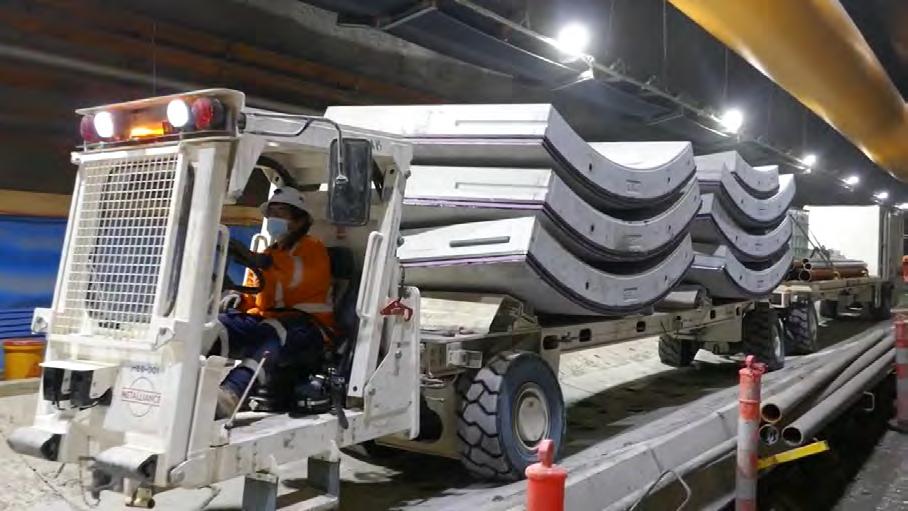
Electric Multi-Service Vehicles (MSVs)
Reductions in emissions of over 80% are achieved when a diesel-powered machine is replaced by a grid-connected electric one. One innovation implemented to leverage this on the CRL was specifying three of the five MSVs on the project to be electric with regenerative braking rather than the standard diesel. These machines were used to deliver tunnel segments, other equipment and people to the tunnel boring machine. The CRL tunnels were ideal for trying out this new technology, being relatively short and configured so that the vehicles were typically travelling downhill loaded (with 20 tonnes of segments) and uphill empty, thereby utilising regenerative braking for on-the-go charging.
It had been hoped to use the electric MSVs much more than the diesel ones, however like any new technology they faced teething problems with batteries sometimes overheating, some mechanical failures and at times they were unable to recharge quickly enough to keep up with the tunnel boring machine’s rapid progress. Nonetheless, by the end of the tunnel boring operations the three electric MSVs had undertaken around half of the total MSV workload and saved the project over 200 tCO2e in emissions. With tunnelling completed the machines have now been sent back to French manufacturer Metalliance for use on other projects along with our feedback on their performance for ongoing improvements.
Electric excavator
With over 1.5 million tonnes of spoil to be excavated, CRL has needed a lot of large excavators, for which there are currently very few low-emission alternatives. However, some smaller electric excavators are now available in New Zealand, so Link Alliance trialled them at two sites.
What?
JCB’s 1.9 tonne fully electric excavator.
Pros Zero onsite GHG emissions and 80% emissions reduction overall; lower operating costs; fewer daily checks; 80% quieter; same power but better torque; reduced fire risk in underground situations so fewer regulatory requirements to be met; zero exhaust fumes, also beneficial underground.
Cons 4-hour runtime before recharging required, which takes 2-hrs to reach full charge; additional hire cost.
The numbers
Verdict
Danny Tau, Logistics Coordinator:
“It’s good and easy to use and much quieter than the diesel plant. It came with all the different attachments and a charging point that we could lower underground to connect it back up when it ran low on battery. It must be popular as we were told by the hiring company that they were in short supply. We could use the plant in small areas underground where diesel could not be used. Would use it again.”

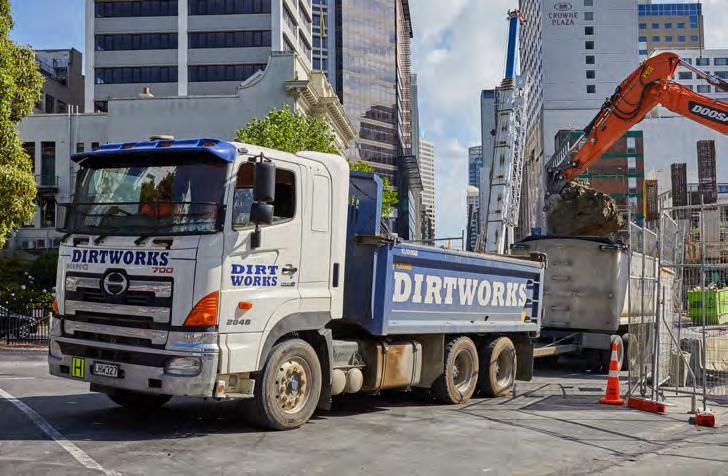
Driver training
Transporting the spoil from CRL construction sites to suitable disposal sites has been an enormous task with over 1.5 million tonnes transported and almost 3 million kilometres travelled. To date, this has been responsible for nearly half the total construction-related emissions. To minimise this, the project has sought to optimise load and vehicle size as well as haulage distance.
CRL has also worked with its hauliers to reduce emissions through driver training programmes such as the Safe and Fuel Efficient Driving programme (SAFED NZ) which teaches drivers how to operate their trucks more safely and efficiently.
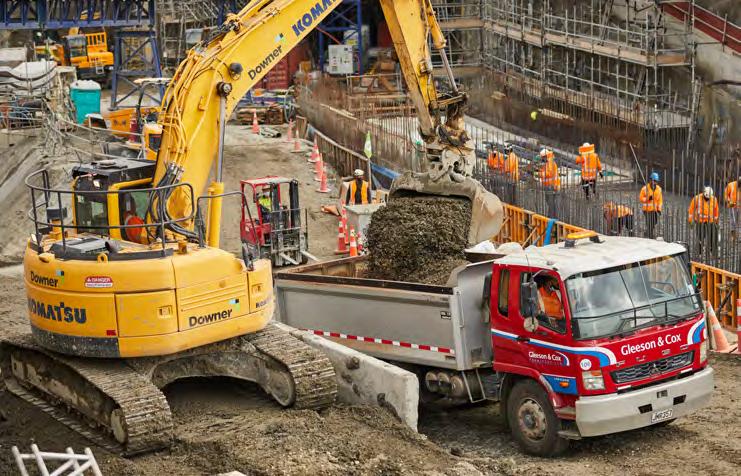
Two of the project’s major hauliers have implemented the training with Gleeson and Cox integrating it into their driver training since being first introduced to it on the earlier Contract 2 (C2) works. Dirtworks has more recently adopted the driver training programme as part of their work on the Te Waihorotiu Station.
According to Jason Thornley, Dirtworks Transport Manager, his drivers “are more aware of how many gear changes they make in a day and when to change gears accelerating and slowing down. All these little changes save fuel.”
Be it road safety awareness, or improved fuel efficiency, Dirtworks has been pleased with the course and its outcomes. “I personally think it’s a great course,” Thornley adds, “and if all drivers can take something away with them at the end of it, that’s a great start for a more positive outcome moving forward.”
In May, Link Alliance also partnered with Dirtworks at their site to plant 450 mānuka trees aimed at improving the natural environment and partially offsetting haulage emissions.
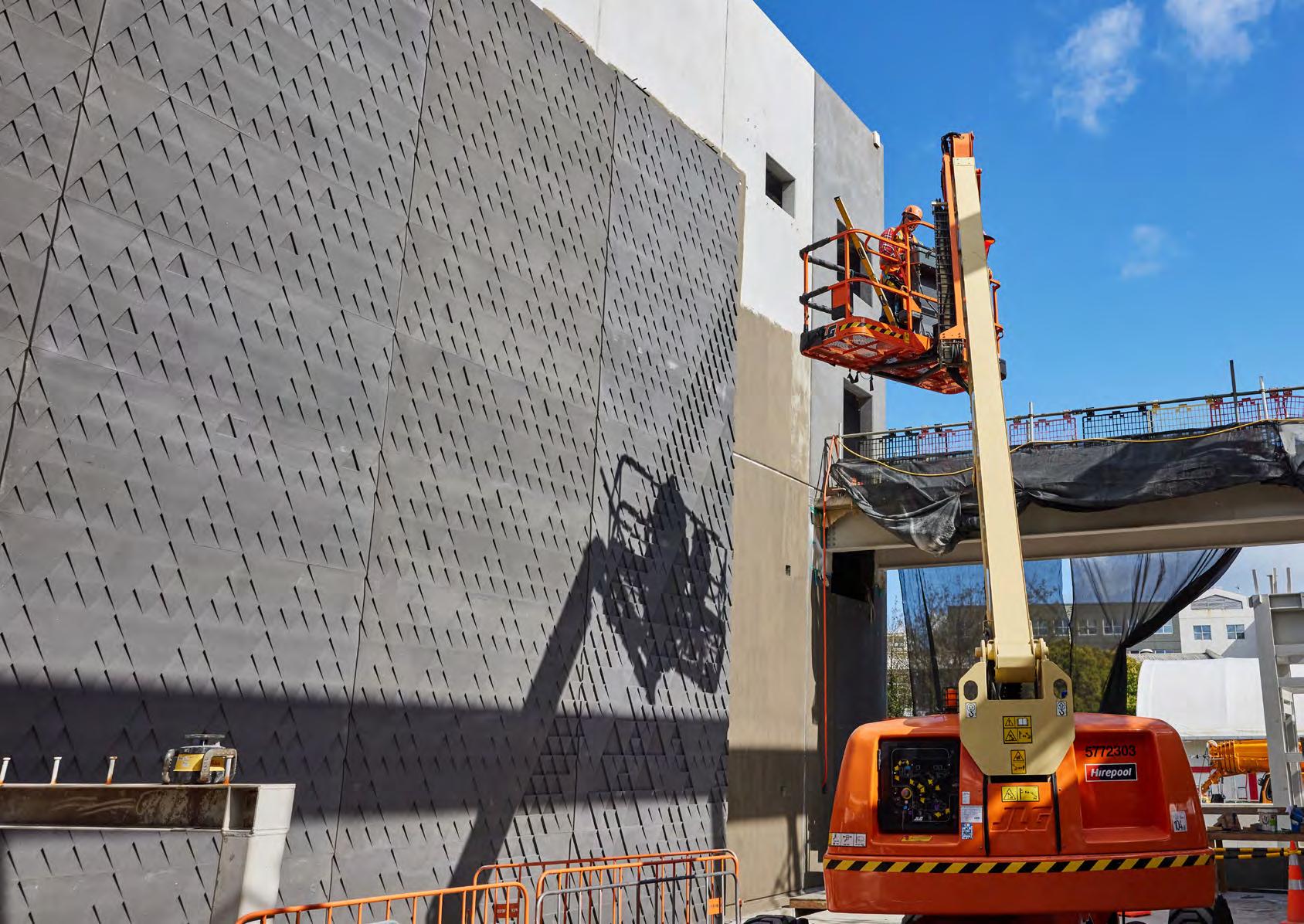 Installation of precast concrete panels at Maungawhau Station, designed by artist Tessa Harris in collaboration with the architectural team
Installation of precast concrete panels at Maungawhau Station, designed by artist Tessa Harris in collaboration with the architectural team

Staff Travel Initiative
With up to 2,000 staff working on the project at any one time, staff travel is a source of GHG emissions. To tackle this, during June and July 2022 the Development & Response and Sustainability teams worked together to launch the Alternative Transport Campaign across the two Maungawhau Station sites. The goal was to encourage people to move away from their car where possible and use alternative modes of transport such as shared shuttles and public transport.
The campaign included initiatives such as an Alternative Transport Competition where $3,250 worth of prizes and vouchers were awarded to staff demonstrating low-carbon travel. Link Alliance also worked with Auckland Transport to promote their ‘Give it a Go’ programme that allows people to trial public transport use for free for two weeks, with 188 Hop Cards provided to Link Alliance workers.
CASE STUDY
Mined versus Bored tunnels
Given City Rail Link uses a variety of tunnelling techniques it provides an opportunity to compare carbon footprints. It is well understood that using a TBM is a quick and cost-effective method of tunnelling but it is also worth noting that it is also a more sustainable method for long tunnels.
The embodied carbon of the materials used is 71% less per metre of tunnel than mined tunnelling, which uses shotcrete temporary lining and then cast-in-situ permanent linings.
Embodied carbon is the emissions associated with manufacturing and transporting the materials, the fibre-reinforced segments, cementbased grout around the outside of the segment and Stage 1 concrete to provide a flat floor to lay the tracks upon.
Likewise, the construction energy footprint is 44% lower because TBM operations mainly use electricity sourced from Aotearoa’s largely renewable electricity grid, as opposed to the predominance of diesel machines used in the Maungawhau Station mined tunnels, (although at Karanga-a-Hape Station electric road-headers were used which reduced the construction energy emissions).
Bored tunnelling also tends to produce less waste, with segments produced in a controlled precast factory, meaning only minimal concrete wastage and moulds can be reused hundreds of times. Whereas mined tunnels require shotcreting which results in significant concrete wastage. Waste created by the bored tunnelling will also mostly be recycled or reused.
One resource that bored tunnelling uses more of is water. To reduce the impact of this the team have overcome a number of challenges to implement water reuse from the TBM’s large water treatment plant for part of the second drive. This enabled just under 2.5 million litres of water to be reused on site.
 Installation of railway tracks for testing underground
Installation of railway tracks for testing underground
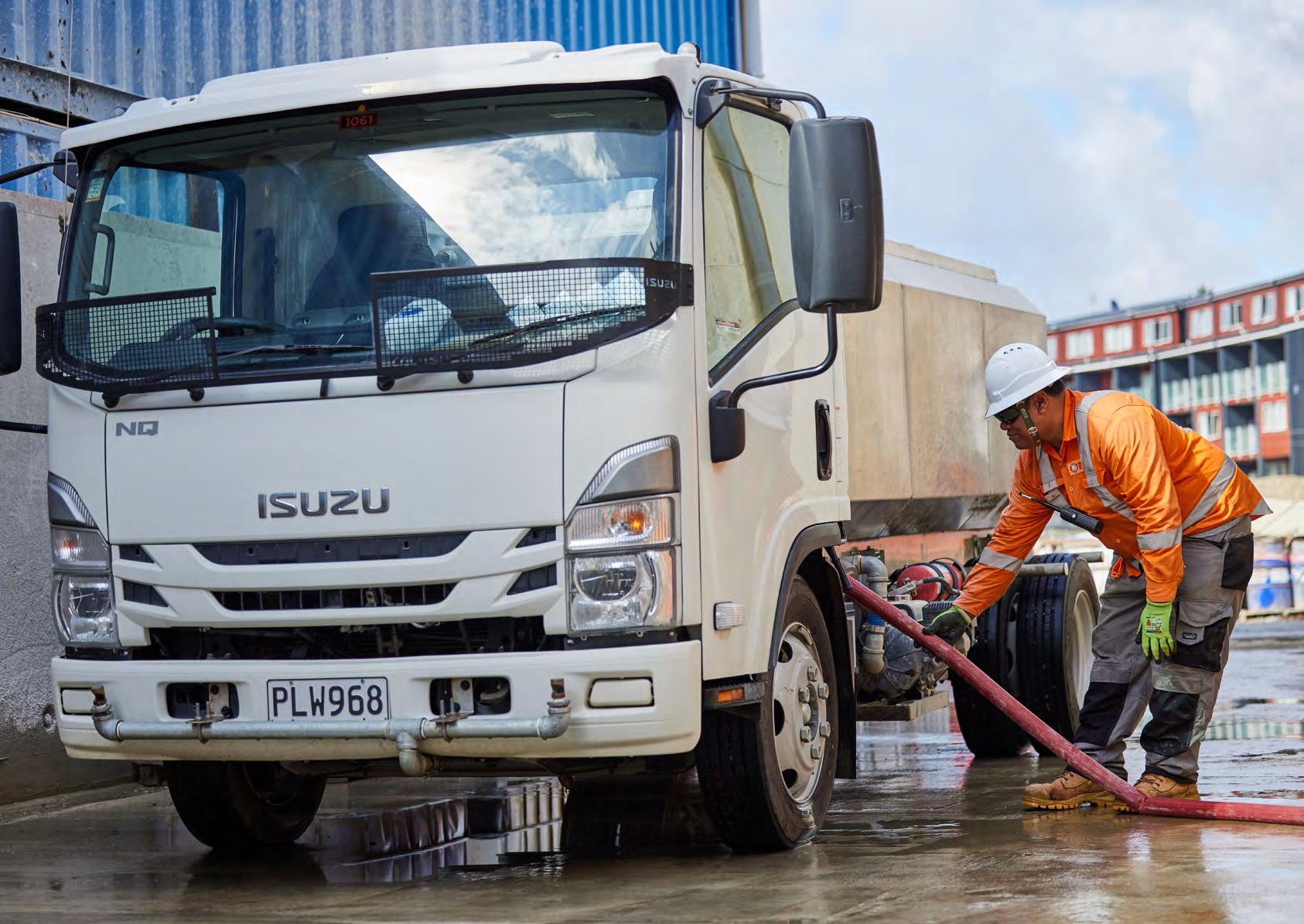 Tanker truck collects water from water treatment plant for reuse
Tanker truck collects water from water treatment plant for reuse
Water
Link Alliance developed projections of water use for both construction and operation of the CRL, with a target of reducing water use by at least 5% compared to a business-as-usual approach.
Although the majority (82%) of the water used on CRL will be during its operation, construction is still expected to use more than 340 million litres. Therefore, as well as designing the stations to be water efficient when operational, a lot of effort has gone into reducing potable water use during construction. A key approach has been to utilise non-potable water (water that is not of drinking quality) where possible.
The water treatment plants located on all CRL sites process all water collected on site and ensure it can be safely discharged into the stormwater network. These plants are a key non-potable water source, as is rainwater collected from roofs. Instead of discharging this water off site it has been used for washing the wheels of trucks before they leave site, for other site cleaning and for refilling the water carts that spray water on the ground to prevent dust being generated around the site.
The TBM has been one of the largest consumers of water on the project. It had been hoped to be able to use recycled water in the machine itself. However, testing of the water showed that despite it being of good enough quality to use in other applications, there was a risk that using it on the TBM might cause maintenance issues resulting in machine stoppages. As a result, the water recycling efforts for the TBM were focused on using the water in the support area for general cleaning of the conveyor belt, chute point and washing box.
Although total water use is tracking 14% below the original projection, the project has not been able to achieve the 5% water recycling hoped for at this stage, with 3.2% of all water used on site being from non-potable sources. Nonetheless, this is still over 8,598,000 litres sourced from non-potable sources, equivalent to 38 households’ annual water use.
Water use
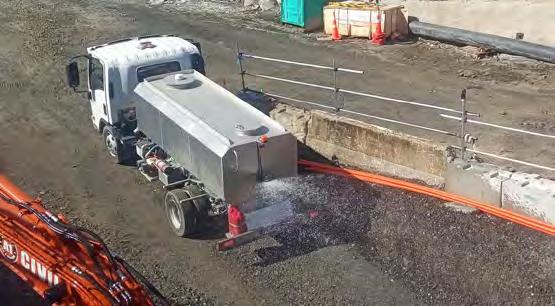
Materials
Link Alliance’s target is to reduce embodied carbon by 15% against the Base Case from materials used to build the project.
The embodied carbon of materials makes up half of the total carbon footprint over the project’s 100-year design life.
With the Detailed Design now completed, a 15.8% reduction is projected. The project is currently on-track to achieve that reduction, with the actual emissions tracking just below the detailed design projection for this stage of the project. Approximately 55% of the footprint to date is due to concrete use, 31% from steel, 8% from cement for grouting and ground improvements and the remainder from aggregate, piping and asphalt and the transportation of materials to site.
As discussed in previous reports, several initiatives have contributed to the projected reduction:
• Maximisation of cement replacement in the project’s concrete mix designs
• Redesign of the Karanga-a-Hape Station to remove the central mined walkway
• Reduction in the amount of materials-intensive mined tunnels at Maungawhau Station
• Change from piles to diaphragm walls (D-walls) across large parts of the project
• Change from bottom-up to top-down construction across the project, reducing the need for temporary steel propping
• Optimisation of the large retaining walls needed at the North Auckland Line connection.

Cement replacement
A key construction-phase initiative has been the minimisation of cement use in concrete. Cement has an embodied carbon footprint of almost one tonne for every tonne used. Since construction started the team has maximised cement replacement with fly-ash, a waste product from coal-fired power stations with a much lower embodied carbon even when shipped from overseas. To date this process has allowed Link Alliance to eliminate 18,444 tCO2e, a 21.4% reduction. However, the Covid-19 impacts to the supply chain, especially international shipping, have made sourcing fly-ash more difficult, therefore Link Alliance has had to ration its use, meaning the 26% reduction in footprint that was hoped for at the start of construction, which is regularly achieved in the United Kingdom and Australia, may not be met.
The cement replacement rate achieved to date is more than 10 times higher than the average for New Zealand of around 2%, helping encourage the local concrete supply chain to increase the use of materials that can replace cement. To address this, a Link Alliance supplier is planning to bring blast furnace slag, a by-product from iron production which is another cement replacement material, into New Zealand in 2023. Although this will be too late for use on the CRL project, it will allow even higher rates of cement replacement for future projects than currently achieved.
Platform backfill
One area of the project that has been affected by the scarcity of fly-ash is the 'back-filling' of the spaces under the platforms at Te Waihorotiu Station and Karanga-a-Hape Station. Because craning-in and placing aggregates for this is logistically difficult in these very busy and restricted underground locations, it was decided to fill them with low cement, low-strength concrete, termed 'flowable fill'. This can easily be pumped in and doesn’t require compacting with the approach expected to save weeks of construction time and reduce the amount of high-strength reinforced concrete needed in the platform. It does mean that additional cement is required for the flowable fill when it had been hoped that much of this additional cement would be replaced by fly-ash. However, fly-ash supply constraints meant this was not possible in the second half of 2022, resulting in a likely increase of the footprint of 200-300 tCO2e.
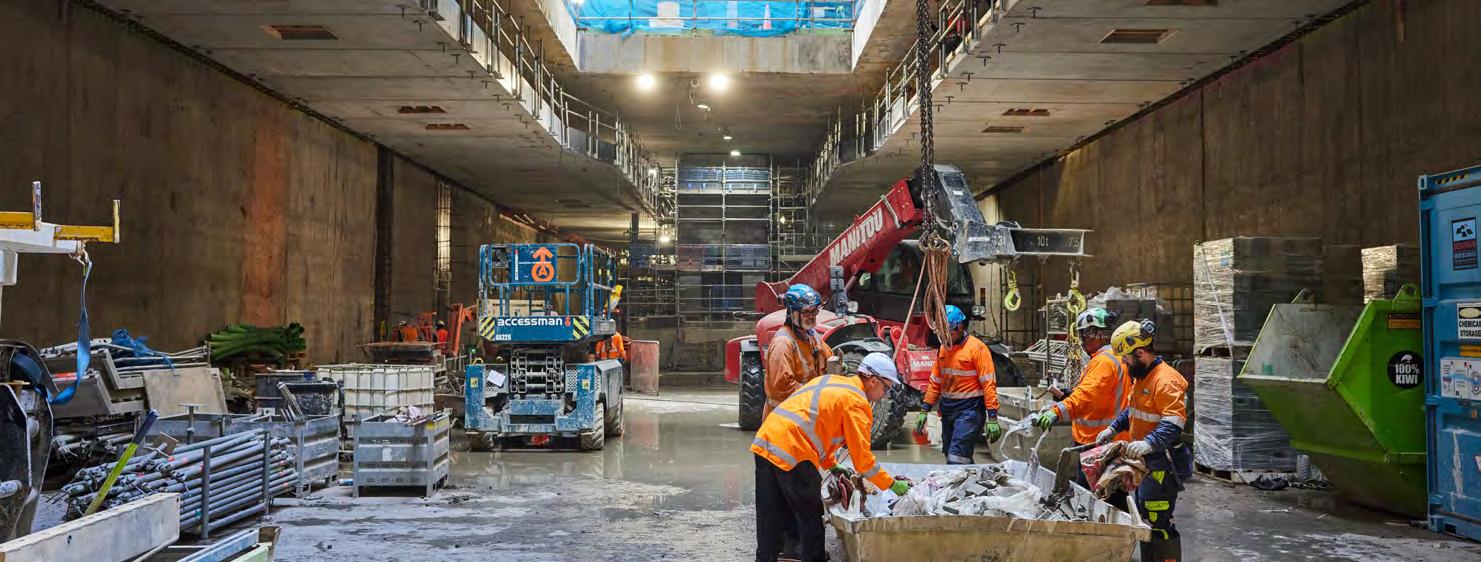
Zero waste to landfill
Half of New Zealand's total waste to landfill is made up of construction and demolition waste. From the outset CRL set an aspirational goal of zero waste to landfill to help shift the dial on best practice within the sector.
Building out waste
CRL Ltd and Link Alliance have already diverted a massive 96% of all construction and demolition (C&D) waste from landfill – 99% when spoil is included.
Careful planning has been undertaken to predict the types and volumes of waste generated on site at every stage of the project. The waste hierarchy has
been put into practice to recover as much material as possible with a strong culture of avoiding, reducing, and reusing waste, and ensuring there are suitable places in which to divert clean fill and recycling.
Waste types generated on CRL sites
With the TBM run now complete, the amount of spoil being removed from site has decreased dramatically. Spoil has accounted for over 90% of waste leaving sites.
Construction and demolition waste as well waste from project offices and lunchrooms, continues to be a strong focus. Ongoing education, engagement and having passionate advocates on site ensures teams remain determined to maximise waste diversion.
96.4%
57,802 tonnes of C&D waste diverted
64%
193 tonnes of office waste diverted
100%
1,644,165* tonnes of spoil diverted
Cumulative data for Contract 3
* Excludes contaminated spoil (49,015)
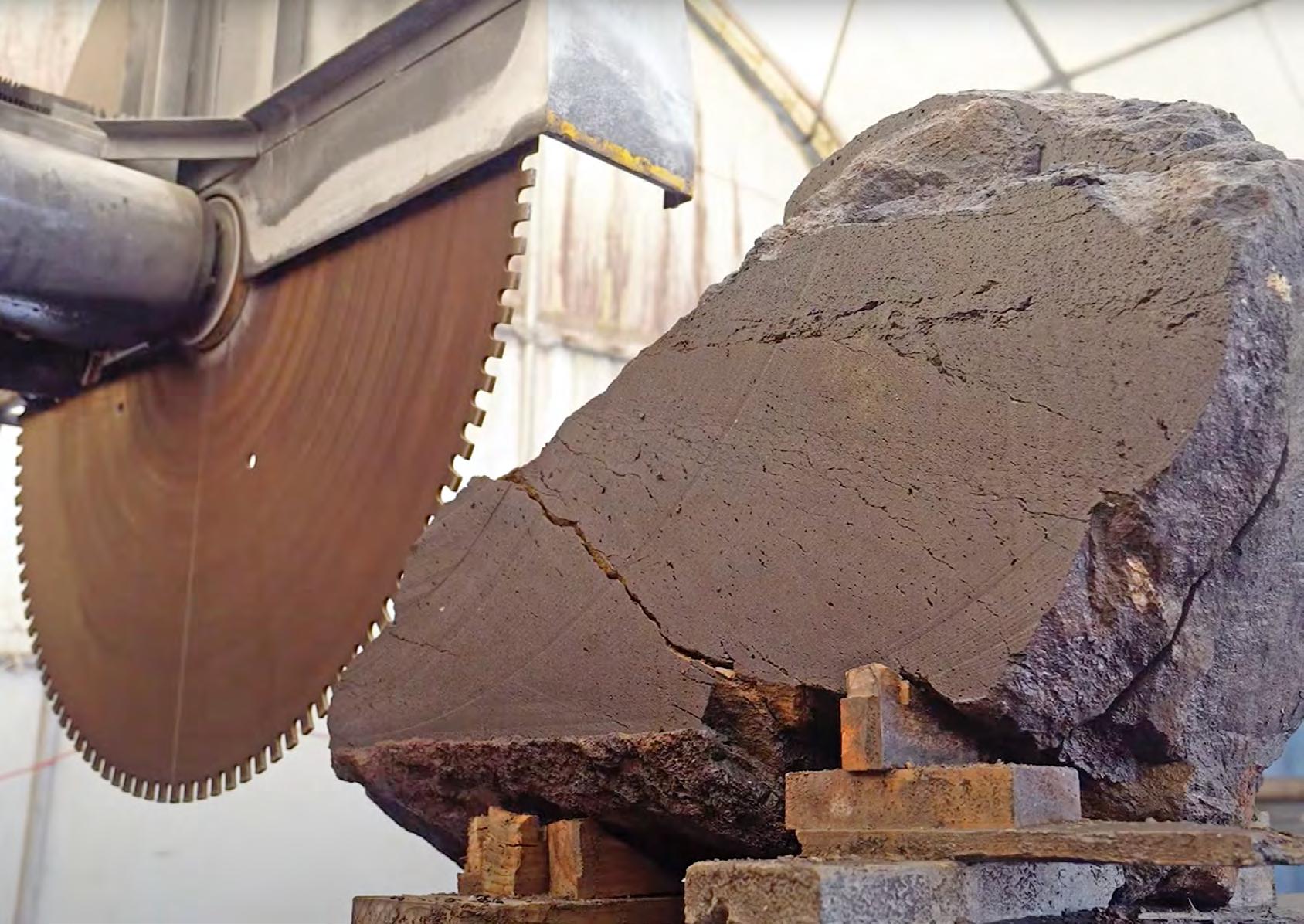 Basalt boulder excavated from site is cut and shaped into pavers
Basalt boulder excavated from site is cut and shaped into pavers
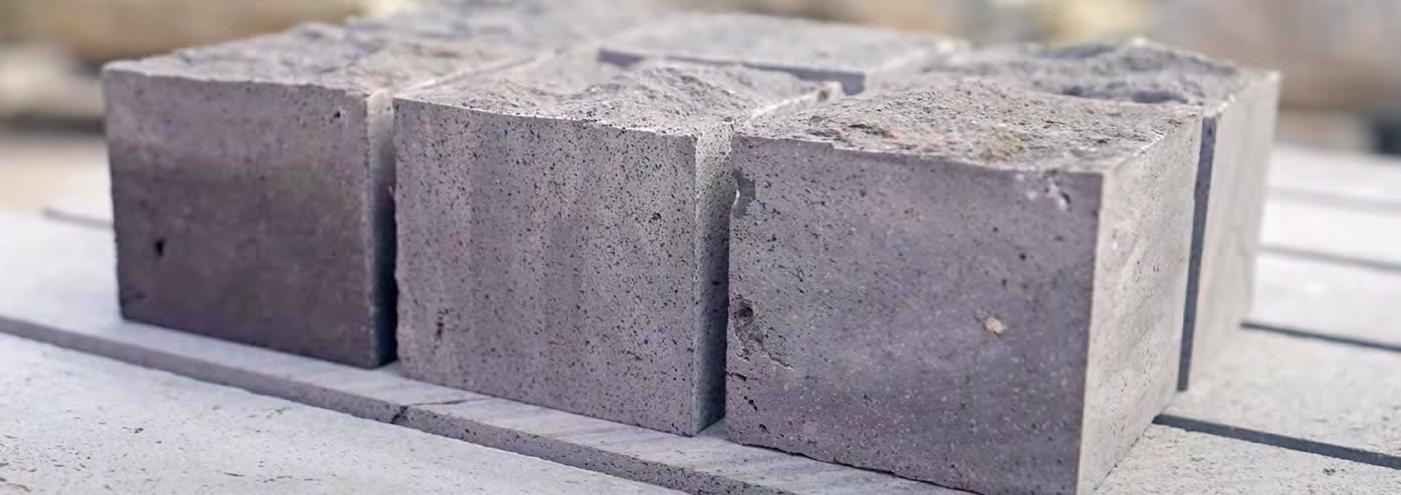
CASE STUDY
Basalt pavers
The design for the reinstatement of Fenton Street, next to the NAL rail corridor, includes basalt 'bluestone' paving. Typically, this type of paving is sourced from China. Because a large number of basalt boulders had been dug up as part of the excavation works, Link Alliance decided to investigate whether this material could be turned into pavers locally. As a result, 60 tonnes of basalt boulders have been cut and shaped to provide pavers for 120m2 of streetscape at a similar cost to importing from China. Taking this approach has had multiple benefits: it provided commercial opportunities
for a local business, reused what would otherwise be waste material, saved 6.6 tCO2e of greenhouse gas emissions associated with transportation, used the material in the same place it was excavated, thereby maintaining a connection between the past and the future, and reduced the supply chain risk associated with global shipping delays that have resulted from Covid-19.
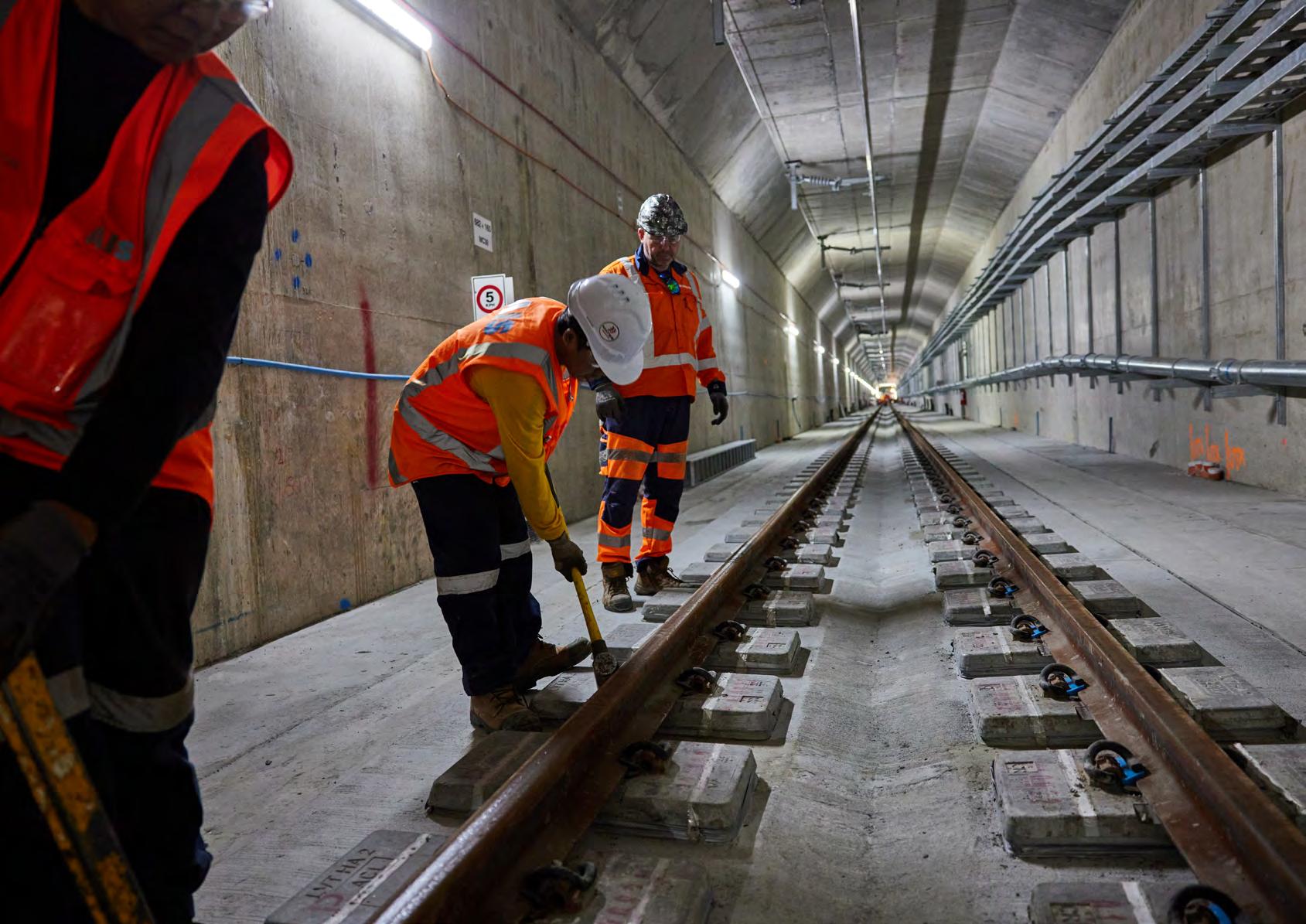 Rail installation at Waitematā
Rail installation at Waitematā
CASE STUDY
Propping steel at NAL
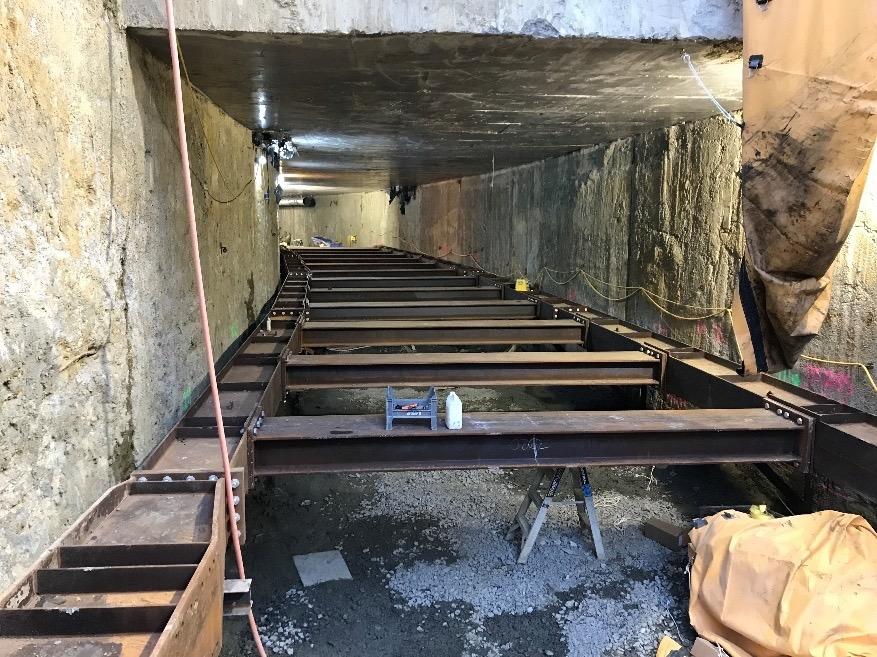
Link Alliance has extensively used ‘top-down’ construction on City Rail Link. This involves underground structures constructed by building the walls and roof structure in the ground first and then excavating down to the final depth and building the floor last. This means the walls are prevented from deforming inwards by the roof as excavation is undertaken, avoiding the need for temporary steel props. In some instances, however, steel
propping has still been needed due to the depth of the excavation, such as at the Eastern Grade Separation tunnel under Mt Eden Road. To avoid the 82-tonnes of steel being cut up and recycled as scrap, Link Alliance has removed them whole and sold them to Egmont Industrial Supply, who will sell them to other projects for reuse, avoiding the emissions associated with steel recycling.
CASE STUDY
Tunnel Boring Machine 'false' segments
The TBM is designed to move forward on the curved tunnel ‘invert’ it has just laid. However, at the start of a tunnel, and when it is passing through previously constructed caverns such as at Karanga-a-Hape Station, temporary or ‘false’ segments need to be installed. The project needed almost 350 false segments, which are 4m wide, 1.1m deep, 5-tonne pieces of concrete reinforced with steel. However, once the tunnel boring was complete these false segments became redundant.
Unable to find a reuse option for them and to prevent them from ending up in landfill, Link Alliance sought a way to recycle these. The solution was found by engaging recycling suppler, Green Vision Recycling, which specialises in recycling and repurposing materials for use in construction and infrastructure projects.
Green Vision crushed the segments, extracted the steel for recycling and graded the crushed concrete to be used as a replacement for virgin aggregate, which may well be supplied back to the CRL as backfill for the tunnels. Green Vision have undertaken an Environmental Product Declaration (EPD), which shows that recycled crushed concrete supplied by them reduces the carbon footprint by around 75% in comparison to using quarried aggregate, with the reduction in trucking distances a particularly important factor.
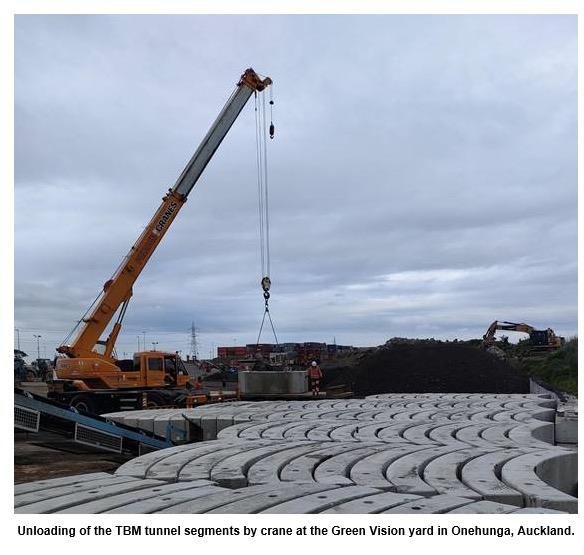

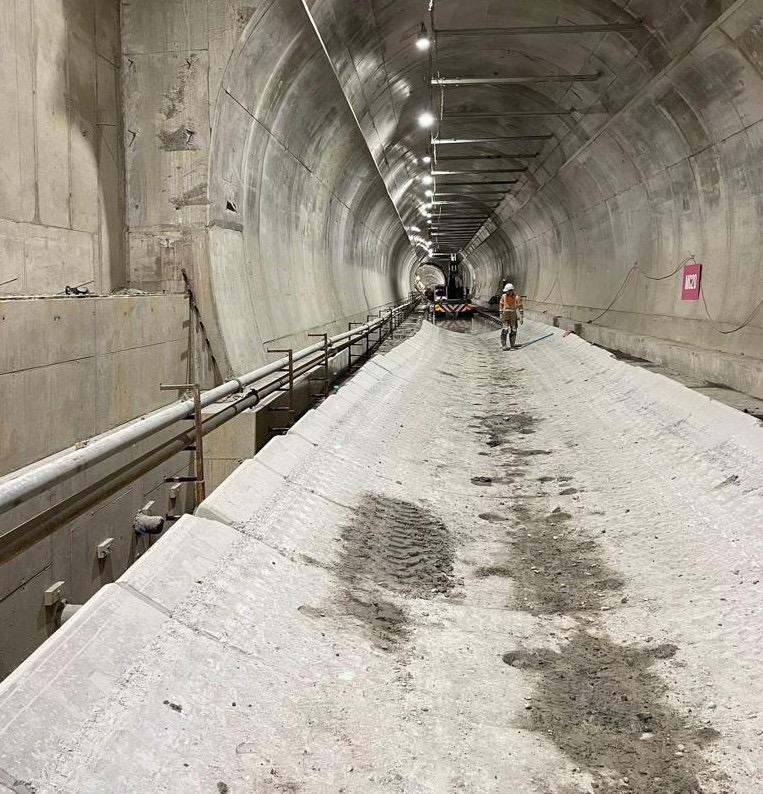
 Worker inspects concrete pipes at underground site
Worker inspects concrete pipes at underground site
CASE STUDY
Contract 8: Sustainability Case Study
Contract 8 is delivering wider network improvements at The Strand, Ōtāhuhu and Newmarket to support City Rail Link operation. Ōtāhuhu works were completed in 2020, Newmarket works are now 80% completed and The Strand will shortly have upgrades to pedestrian mobility access and walkways in time for December 2023.
The main contractor Libbet has made a commitment to supplier diversity and social outcomes. With a diverse team continuously involved on this project, 25% of their workforce identifies as Māori or Pasifika.
These include Tohiora Te Ahuru who joined the team as a Person In Charge (PIC) for works completed over summer, where he played an integral role delivering a complex scope within tight timeframes; two carpenters working on their apprenticeships and a junior quantity surveyor was also actively involved with this project assisting with progress claims, attending work scope meetings and taking part in the reviews.
Battery powered tools and equipment that do not rely on fossil fuels are also being used on site, with the triple benefit of lower carbon emissions, less noise and no harmful odours normally associated with gas-powered alternatives. Libbet is using an Appenate™ app to monitor fuel use and the Toitū Envirocare Travel Calculator to calculate and track travel and transport emissions (kg CO2e).
Other resource efficiency initiatives include a single more energy efficient generator and re-use of existing subgrade and formation material. Following testing and sign off from site engineers, 60-tonnes of existing subgrade/ formation material were diverted from landfill, eliminating the need for 60-tonnes of imported virgin aggregate materials. Soakage pits have also been used to allow water produced from core drilling to safely and slowly soak into the ground rather than removing water from site.
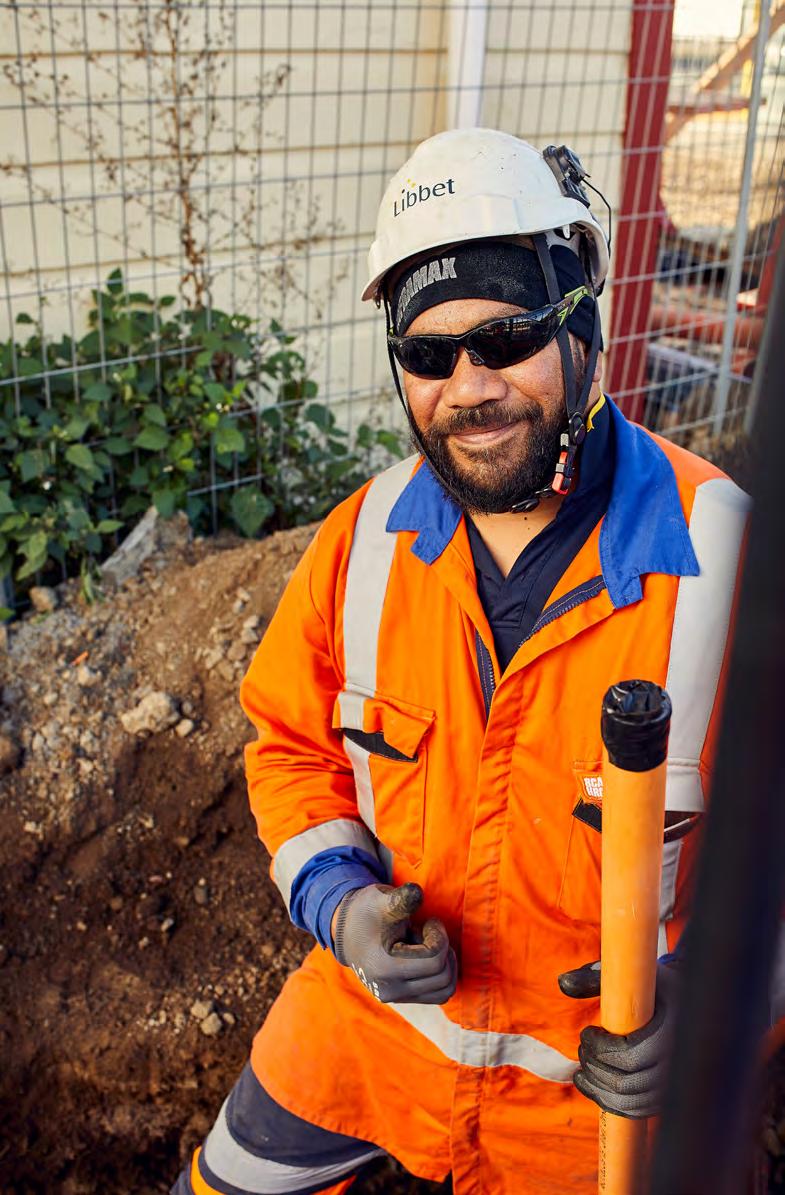
Libbet has worked to find innovative ways to trim carbon emissions, partnering with their Personal Protective Equipment (PPE) supplier to divert 100% of staff uniforms and most PPE from landfill.
For every kilogramme of used uniform/PPE diverted from landfill, 3–4kg of CO2 emissions are eliminated. In December alone, 17kg of uniform and PPE was diverted from landfill, removing around 68kg of CO2 from the environment.
Most clothing and PPE no longer suitable for use has been shredded and repurposed as fibre that is used for insulation and wadding materials in Auckland, replacing virgin plastic use.
Libbet has been able to divert 0.5 tonnes of mixed recyclables from landfill over the course of the project.
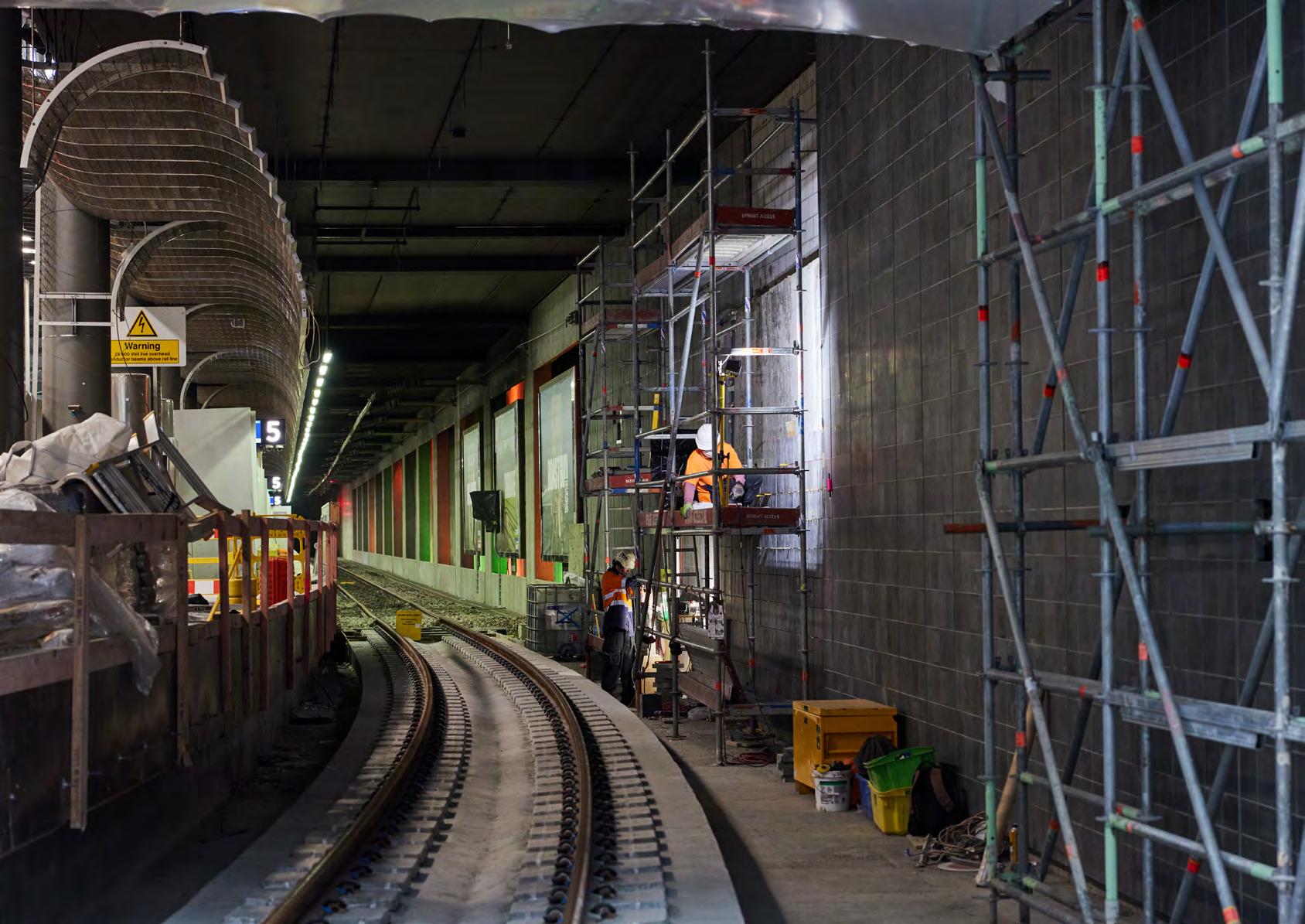 Martinus contractors work on scaffolding at Waitematā Station (Britomart) platform
Martinus contractors work on scaffolding at Waitematā Station (Britomart) platform
Contract 9: Sustainability Case Study
Contract 9 (C9) provides the additional connections, platform widening and track modification at the eastern end of Waitematā Station (Britomart) needed to operate the CRL. Early works were completed by KiwiRail in 2020 and 2021. Rail specialist Martinus Rail was contracted in 2022 to deliver structural strengthening, pedestrian walkways and track works at Waitematā Station (Britomart).
Carbon Savings
Resource efficiency and reducing carbon emissions were essential ingredients of these works in 2022. Above ground energy saving measures included planning work for daylight hours, preventing the need for a heavy generator by setting up an office on the work site and allowing plug in mains power for the majority of work. Plant use was further reduced by erecting scaffolding with the davit system for access and emergency. This process for reducing carbon emissions was mirrored below ground in the structures tunnel work where the team used the station’s mains power and Martinus Rail worked with staff to use the station’s ventilation system. This meant additional generator power wasn’t required for running fans or extraction systems. In the tunnel scaffold access was used for approximately 80% of the works with electric scissor lifts used when necessary behind the south wall.
Track side, the team utilised work platforms and hybrid Elevated Work Platforms (EWPs). To streamline the delivery process and reduce the total amount of plant movements required between Quay Park and the tunnel worksite, Martinus Rail used specially designed rail trailers, low loaders and a Zephir with wagon, which more than doubled the number of items that could be transported in one movement. The work programme was also planned, as far as possible, to always have the trailers travelling full with every delivery paired with a removal.
Challenges
Opportunities to sustainably dispose of stormwater, spoil and ballast from the site were explored. Unfortunately the chemical parameters of the surplus water, spoil and ballast in 2022 were not suitable for stormwater network discharge or later ballast, soil or fill reuse. High hydrocarbon and zinc levels prevented the ballast from being reused.
Material Reuse
By using coated ply, 90% of ply used was able to be removed for reuse (1.67 tonnes). Ordering pre-cut and shaped sections to match the design detail also reduced steel wastage (< 0.5% of total ordered). All left over steel reinforcing was removed for reuse on other construction projects (0.06 tonnes). Reusable metal shutters and props also minimised the use of virgin materials.
Surplus rail, sleepers and Overhead Line Equipment (HLE) materials were returned to KiwiRail for use on other projects. For the temporary track sets required for access to the slab works, Martinus Rail utilised recycled plastic sleepers, or reused previously removed wooden sleepers from the tunnel and other projects. Once the temporary access was removed, these items were returned to Quay Park for reuse in the next stages of construction for the same purpose.
Minimising Waste
All construction waste is being sorted and segregated to maximise recovery and reuse, with a significant proportion of all waste diverted from landfill in 2022.
Careful planning and management of concrete pours, including constructing the wall and outdoor sections, reduced waste and resulted in fewer pours. Concrete waste was mainly from cleaning the hopper and line. This was discharged directly into skips and taken back to the Firth distribution plant for recycling. This equated to only 1.2% (3 tonnes) of the total concrete supplied for both the surface and tunnel pours requiring recycling.
Over Christmas 1-2 tonne block sections were removed from the existing south wall, as part of demolition and were sent for crushing and recycling.

C9 Waste to Landfill
Landfill 334.38t
C9
Waste Diversion1
Spoil 85.04t
Managed fill 300t contaminated ballast2 Sludge 19.44t
Concrete & hardfill 47.05t
Wood 7.22t
Steel 4.25t
Plasterboard 0.5t
Greenwaste 2.81t
1 Excludes block sections
2 Christmas 2022-2023 figures are not yet available.
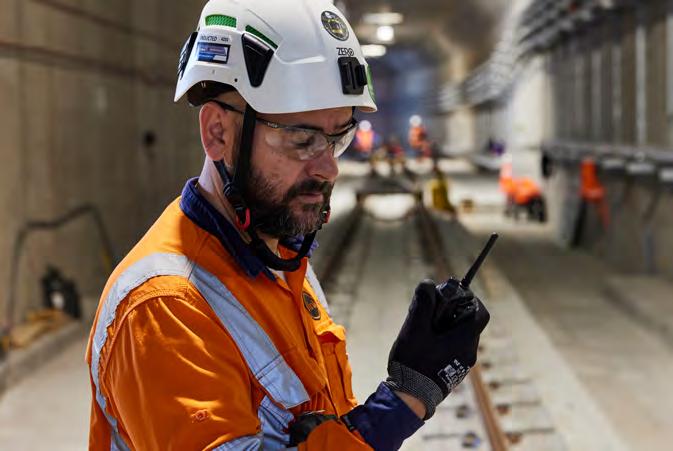
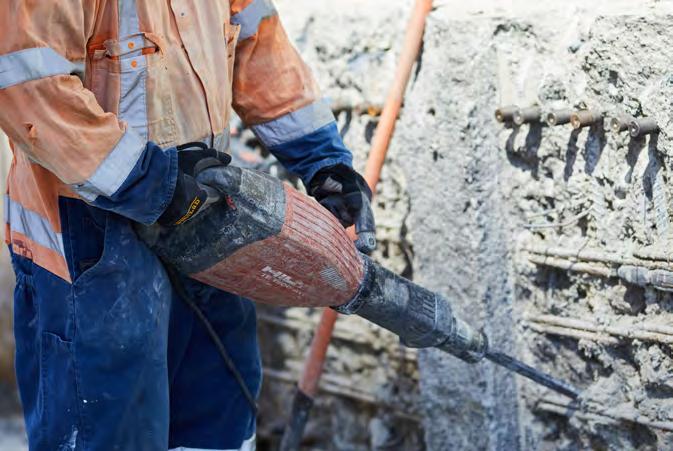
Environment
By recycling the water used for dust suppression in areas such as the core drilling, total water use and wastewater generation was reduced.
Erosion and sediment control plans are being implemented on the site across Scene Lane and Quay Park environments. Measures include:
• Drills and core drills using vacuum cones
• Concrete saws with integrated water suppression
• Core drills recycling the water used for dust management to minimise slurry production requiring disposal and
• A suction method for fixing drills to the wall is used to eliminate dust generation altogether.
Noise and vibration monitoring was conducted throughout construction. Using mains power and scaffold access over plant has reduced plant noise. Noise mats around the work area and focused sections, such as the generator when it’s on site, are installed for noise mitigation.
Sediment is controlled through a whole series of measures including drain protection, perimeter protection with sediment socks and management of trucks prior to leaving site.
The remaining C9 works will be completed in 2023.
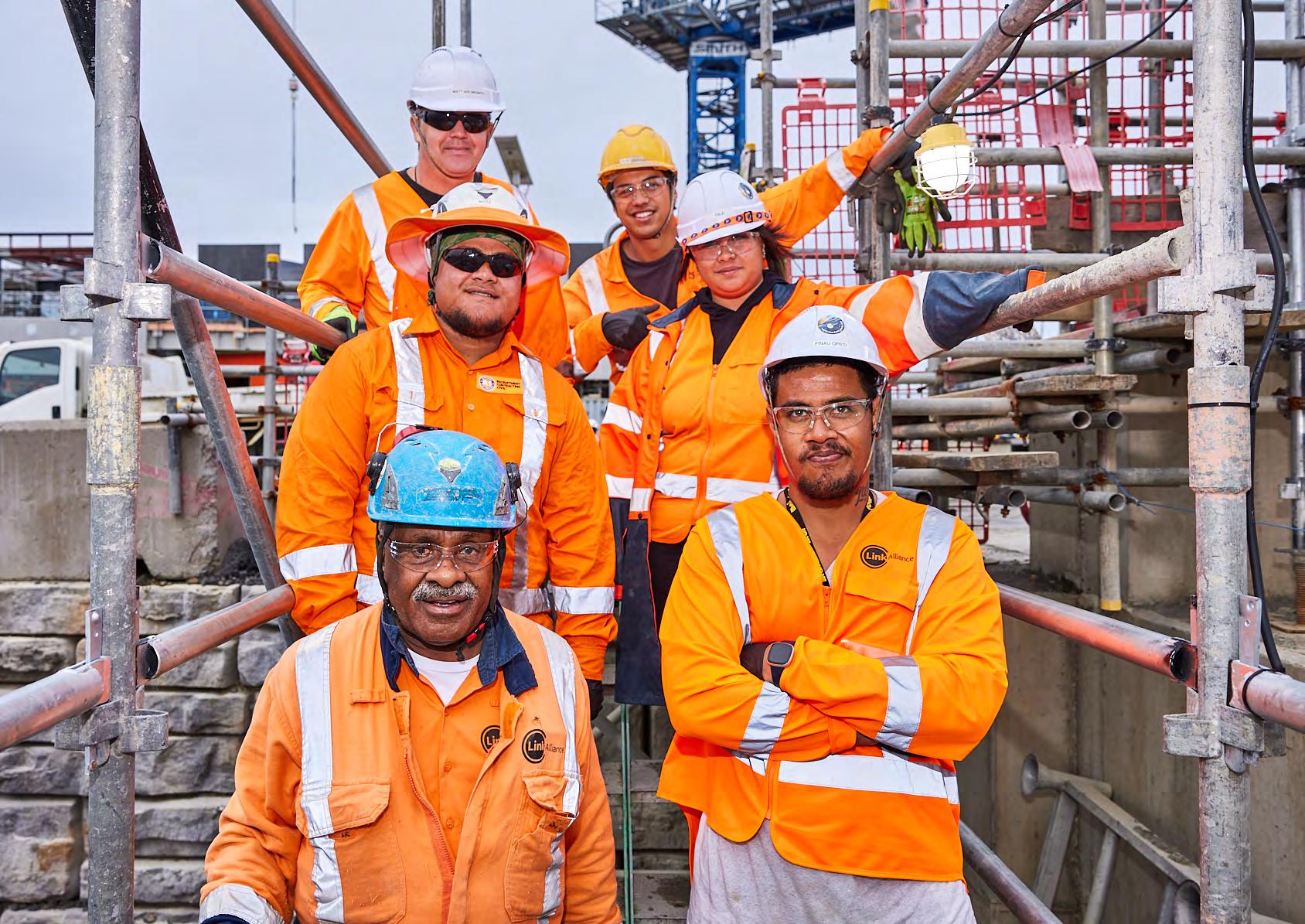 Link Alliance crew pose in their gear on site
Link Alliance crew pose in their gear on site
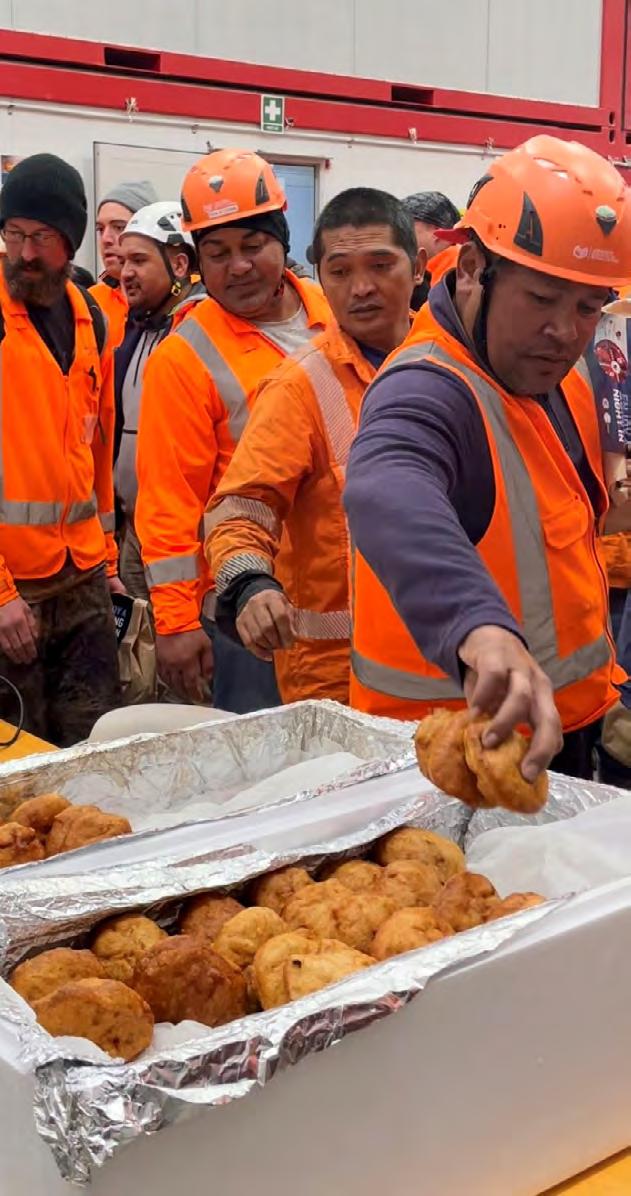
Social outcomes
Link Alliance has been delivering on CRL Ltd’s Social Outcomes Strategy for three years. This year Link Alliance reviewed Objective 7 - Social outcomes that make a positive difference to the lives of others - to ensure the objective was focused and relevant.
Targets relating to employment, training, social procurement and supporting the future workforce are the backbone of the Social Outcomes Strategy and stand alongside the inclusion to “promote a broader understanding of Māori culture and values through Link Alliance”.
Three years also means growth and development. What was once a single Social Outcomes team has now been broadened to include four teams: People and Culture, Human Resources, Procurement, and Training. CRL Ltd is also creating opportunities to contribute to the community through the project delivery phase by maximising training and employment opportunities, creating
greater diversity in the supply chain and upskilling the workforce.
Like anything new, there have been adjustments and the reality is that as social outcomes becomes more embedded, people in key roles become social outcomes supporters or, better yet, social outcomes champions. As always it is people that sit at the heart of social outcomes.
City Rail Link’s social outcomes initiatives were recognised in 2022 at the Infrastructure Sustainability Council Awards with a highly commended award for Excellence in Social Outcomes.
He tāngata, he tāngata, he tāngata.
What is the greatest thing in the world?
It is people, it is people, it is people.
 Transformation Station - Te Waihorotiu Station works in progress
Transformation Station - Te Waihorotiu Station works in progress
Training
CRL Ltd and Link Alliance are continuing to work to maximise the training and employment opportunities for those experiencing barriers or disadvantage, with a focus on mana whenua, Māori, Pasifika and rangatahi.
More than half of Link Alliance focus group employees had Career Development Plans in place by the end of 2022, a significant milestone for the project. Completing these plans helped identify strategic areas for targeted training, while 89% of focus group members undertook training in 2022, more than double the proportion of 2021.
A new training management system has been introduced to allow Link Alliance’s Training and Development team to better manage, monitor and report on focus group career progression and training. A recent audit completed by CRL Ltd's Social Outcomes Advisory Group highlighted the importance of having these systems in place right from the beginning of a project.
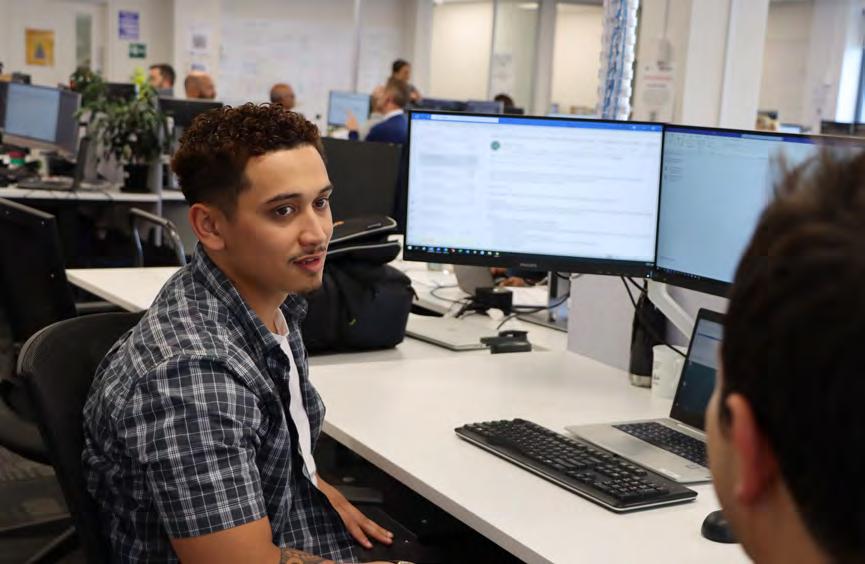
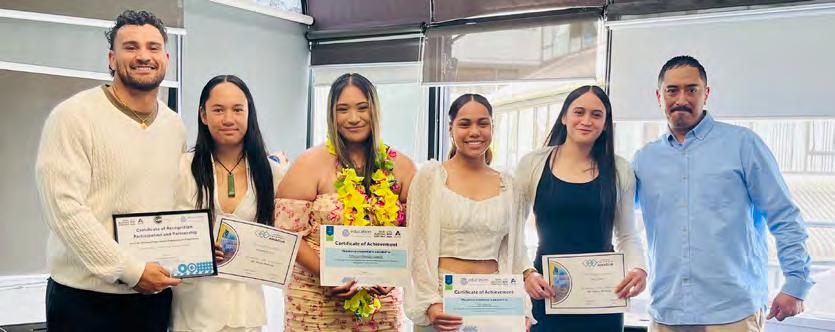
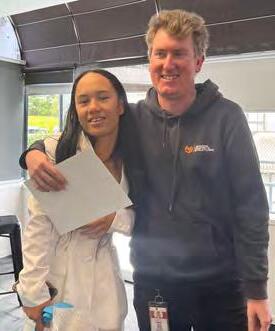
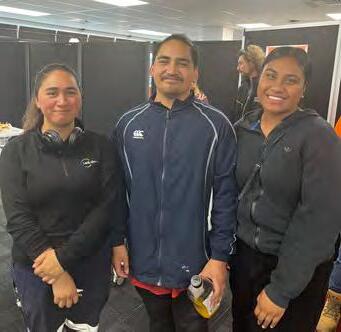
Employment
The Progressive Employment Programme (PEP) is one of City Rail Link’s flagship social outcome employment initiatives. The goal of the programme (a 16-week training course) is to help bypass barriers preventing rangatahi from getting to the employment starting line.
In March 2022, six rangatahi joined the PEP and through the programme gained practical experience and micro credentials. All six interns were offered full time positions with Downer, and labour hire companies (Freestyla and Auckland Formwork). Five interns accepted the offers, with one choosing to pursue another industry after realising Construction wasn’t for him.
• A second cohort of six interns began in August. Four rangatahi are on track to receive full time employment. Two left the Programme after realising Construction wasn’t for them
• Recruitment is now underway for a further 12 PEP interns for 2023.
Summary to date
Number of rangatahi graduated from the programme
Number of graduates employed after the programme
Number of graduates employed > 12 months
Praise for the programme has been high. Pastoral care providers who partner in delivery of the programme believe there is a real need for other employers to take a similar wrap around approach to working with rangatahi.
29
24
13

Brandi Harrison
PEP Cohort November 2020
PEP Role Traffic Control Assistant / Spotter
Pastoral Care Organisation Te Whānau o Waipareira
Current Role Executive Assistant & Programme Coordinator, Education Unlimited
What did you find rewarding about the PEP?
“I came from a hospitality background, so just being around such brilliant and educated minds and people who were passionate and progressive in their roles was a really different experience for me, which I believe really helped me to grow professionally, plus working and seeing my peers also hit the ground running in their own new roles”.
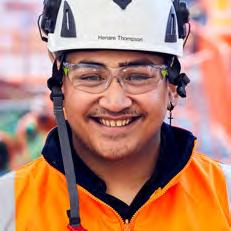
Henare Thompson
PEP Cohort 2019
PEP Role Traffic Control Assistant / Spotter
Pastoral Care Organisation Te Whānau o Waipareira
Current Role Health and Safety Assistant, Link Alliance
What did you find rewarding about the PEP?
“I experienced and learned how construction operates, how it all comes together. I got educated in multiple unit standards that caught my interest in the health and safety career I've chosen to walk. On-Site experience was the most beneficial as I learn better practically. I had a great mentor that helped me in my journey too, and I still catch up with him when we can.”
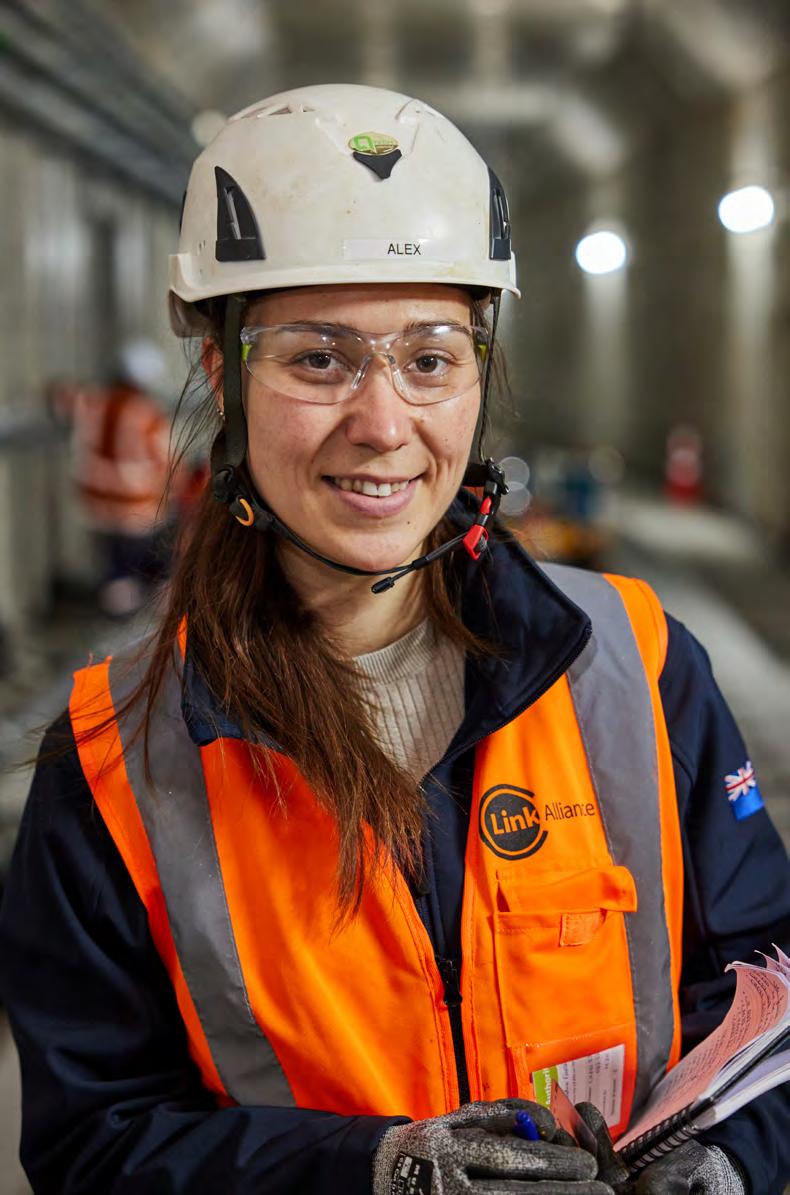
$79m Link Alliance spend with Māori and Pasifika owned sub-contractors and suppliers
41 contracts worth $79m invested
$188,000 spent with mana whenua (8 City Rail Link Mana Whenua)
39 engagements with socially innovative businesses
Link Alliance’s Formula for Social Procurement
Supplier Diversity
While constructing the largest transport infrastructure project in New Zealand, CRL Ltd has the opportunity to effect positive change in the lives of Aucklanders.
CRL Ltd and the project’s contractor, Link Alliance, seek social outcomes during the delivery phase of the project that have lasting positive effects on the communities of Tāmaki Makaurau, Auckland. This means seeking out opportunities that will benefit communities and the people that live in them. The practice promotes a culture of equity, inclusion and diversity.
Link Alliance has a strong focus on supporting supply chain opportunities for Māori and Pasifika businesses and socially innovative businesses.
1
2
Social outcomes and procurement teams identify and connect with Māori and Pasifika businesses, with the potential for tender participation through Amotai and Mana Whenua
Maximising opportunities for participation by alerting these organisations of potential tenders and supply opportunities, with detailed supplier briefings for bigger packages
3
4
Suppliers tendering for packages with high social outcomes opportunities are required to provide details of their social outcomes’ initiatives and a social outcome weighting is applied to the evaluation of those tenders
5
Providing feedback on unsuccessful tenders to support future success
Building whanaungatanga (kinship) with contracted businesses
Link Alliance Māori and Pasifika Supplier Survey Results
In 2022 all Māori and Pasifika Link Alliance suppliers were invited to participate in an online suppliers survey2.
The survey was designed to see how Link Alliance’s approach was working for the businesses that had been contracted. Examining whether the CRL Ltd requirement to engage and support Māori small and medium enterprises, and Pasifika small and medium enterprises, was being met and whether the businesses contracted have experienced positive flow-on effects, such as providing quality employment, gaining training and career development, supporting their local communities, building their capacity and contributing to the New Zealand economy.
2 As part of an audit conducted by the CRL Ltd Social Outcomes Advisory Group, 32 current suppliers were contacted and 24 questions were asked, with 14 respondents and a survey response rate of 44%.
Positive Outcomes Identified by Businesses
The businesses surveyed identified upskilling staff, employing experienced people within their businesses, growing brand reputation by being part of the project and being better placed for future opportunities as some of the positive impacts of holding a contract. Some businesses noted business growth, with 36% expanding their teams and the provision of employment directly benefitting workers.
Businesses also gained a better understanding of the commercial sector and how things work, including the experience of excellent workmanship across work performance, discipline and Health and Safety.
Businesses reported positive experiences with administration, training, social outcomes, and design teams, while connecting with management was valued. The collaborative approach taken by the Link Alliance team, with the building of relationships, mutual respect and whanaungatanga among teams, was also of value. Businesses training, induction, and brand profile expectations were the criteria most often met.
The five issues identified as most important to these businesses were:
Financial performance
45% felt tikanga was being practiced and 55% felt it was being practiced sometimes
Social Procurement
City Rail Link is a member of Amotai, Aotearoa's supplier diversity intermediary tasked with connecting Māori and Pasifika-owned businesses with buyers wanting to purchase goods, services and works. Amotai is the swell in the tide, a tide that can carry all waka to new horizons.
Amotai verifies Māori and Pasifika-owned businesses and holds a national database of Māori and Pasifika-owned businesses that are ready for work and provides practical advice and support to CRL Ltd and Link Alliance so both parties can successfully engage with more Māori and Pasifika-owned businesses. This practice, commonly known as supplier diversity and development, is a dynamic and evolving discipline.
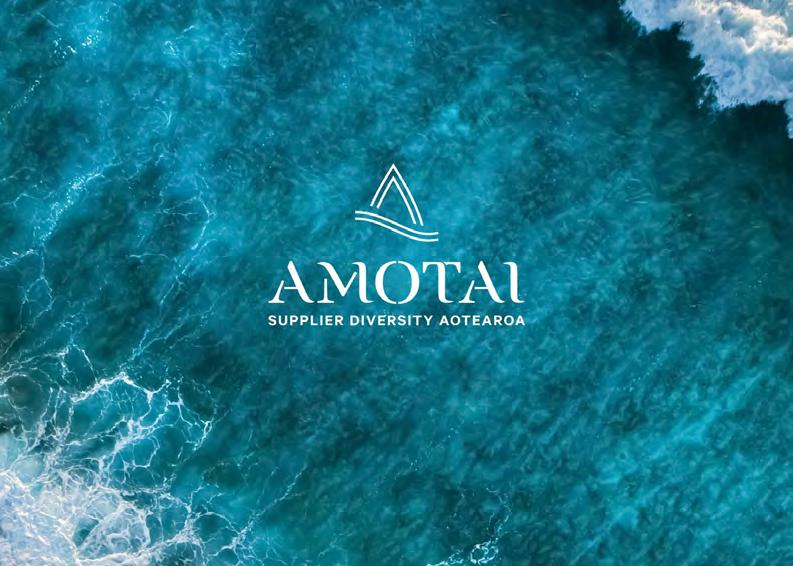
2.5 star rating for Link Alliance commitment to working with Amotai businesses
86% registered with Amotai
36% were referred by Amotai to Link Alliance

Contractors
Improving the Supplier Experience for Māori and Pasifika businesses
Our survey asked contracted Māori and Pasifika businesses about the challenges of their experience working on the project.
The top challenges were identified as:
• Planning (50%)
• Securing a contract prior to starting work (40%)
• Insufficient timing to resource (40%)
• Relationships (40%)
• Resourcing (30%) and managing conflicts (30%)
Getting started, meeting the procurement criteria, and working on site was difficult or very difficult for some businesses.
Key issues raised included understanding contract requirements, establishing pricing, consistent changes in the programme and start dates, issues with accuracy and timeliness of payment, labour and supply decisions which did not reflect supplier briefs, issues with management style, poor communication and a need for more information where contracts are terminated or no further work is offered.
Future Business Development and Support
Businesses also indicated that to gain contracts in future further support was required:
• Environment and sustainability (38%)
• Diversity and social impacts (38%)
• Career development planning (25%)
• Understanding language in contracts, pricing methodologies and more accessible procurement processes.

How can we address these challenges?
With another two years remaining on the project, and 90% of procurement now complete, some key ways to address these challenges and share the lessons learnt beyond the project have been identified
1. Raising awareness about why and how social procurement is needed
2. Cultural competency training
3. Supplier briefings with clear explanations of procurement processes, including:
• information on weightings
• the ability to ask questions
• support to ensure that risks inherent in planning issues are built into pricing as part of a wider cultural change within contract management
4. Ensuring the project has sufficient resources to implement social procurement, as team resources outside procurement directly impact on the relationship with Māori and Pasifika businesses, including:
• Better whanaungatanga – ensuring regular contact and timely responses to queries and issues arising
• The importance of up-to-date Procurement Registers and Workforce Plans to provide sufficient time to identify and support potential and existing suppliers and
• Identifying ongoing opportunities for suppliers and the areas of capacity, training and development required to align with project and industry wide forecasting.
5. Ensuring exit interviews are provided on contract termination to provide clarity and learnings for the businesses’ ongoing development.

Future Workforce
Link Alliance's Future Workforce programmes continue to be popular in engaging, informing, and inspiring students about the diverse career opportunities available in the construction and infrastructure industry. This year the Link Alliance Education Engagement Programme (LEEP) hosted more than 100 students from ten different schools and in excess of 1,000 students were engaged through Link Alliance’s presence at youth, career, and STEM (Science, Technology, Engineering, Mathematic) information events.
Leveraging off this success in response to stakeholder demand saw two new programmes launched this year: the Scaffolding Through Sisterhood work experience programme and Career pathways: stories that inspire video vignette series.
Scaffolding Through Sisterhood provided wāhine from different high schools the opportunity to experience and explore different careers on the project. The one-week experience provided eight
wāhine with new knowledge about the diverse careers and showed what it was like to be an employee in the industry.
Wāhine were also the focus of the video vignette series Career pathways. The series showcases four wāhine Māori and Pacific engineers on the project. The authentic voices and journeys of the wāhine informed, inspired, and resonated with its target audience. It has been widely shared with schools, education providers, community groups and industry partners and can be viewed at www.cityraillink.co.nz/social-outcomes.
The selfless contribution of the Link Alliance workforce to these programmes is its greatest resource. Students have made career pathway choices based on what they have heard and seen at one of the future work programmes.

Scaffolding Through Sisterhood
A key driver for the launch of the Scaffolding Through Sisterhood work experience programme was the desire to increase participation of Māori and Pacific wāhine in the construction and infrastructure industry.
During the April and July school holidays, eight wāhine joined the Link Alliance whanau for the five-day programme. The programme focused on increasing their awareness and knowledge of the diverse career pathways into the industry.
The wāhine belonged to six different high schools:
Auckland Girls Grammar School, Papakura High School, Manurewa High School, Auckland Seventh Day Adventist School, Avondale College and Glenfield College. Sourcing students from so many different schools was made seamless with the support of the Ara Education Charitable Trust (AECT) and Jobs and Skills Hub.
Both organisations partner with industry, and Auckland high schools to create employment and training opportunities for their respective students.
The benefit of working in this type of partnership is
the established relationships, pastoral, and wraparound support already in place for the students they refer. While on the project they are also paired with a Link Alliance mentor.
Scaffolding Through Sisterhood has activated the aspirations of many young wāhine to work in the industry and for others course has made them reassess and reset. One student who joined the programme in April was ready to leave school. She recently shared that she had just completed her NCEA Level 3 qualification.
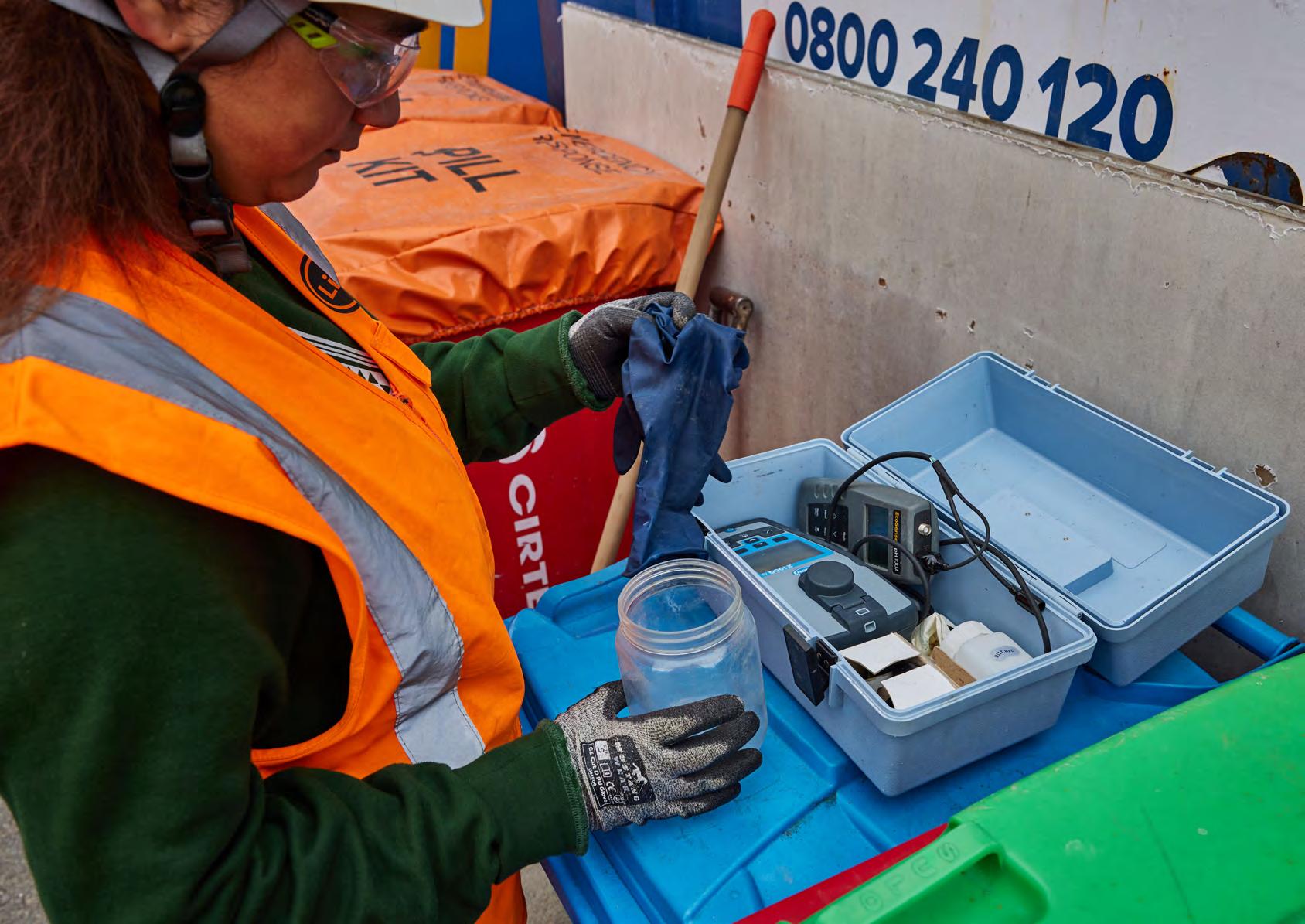 Atarangi Thompson carrying out water testing
Atarangi Thompson carrying out water testing
CASE STUDY
Atarangi Thompson
For Link Alliance, sustainable employment means investment in its people. When Atarangi Thompson began her journey on City Rail Link in 2019, she never imagined she would find her career pathway and be studying part time at the University of Auckland.
The turning point came, when fresh out of high school, and undecided about her future career pathway, the then 19-year-old was presented with the opportunity to be part of the Progressive Employment Programme (PEP). Here she would get her first taste of what a career in environment entailed.
Fast forward to 2022, and you will find Atarangi at Te Waihorotiu Station and Karanga-a-Hape Station sites fulfilling her role as Environmental Administrator. Her main function is to support the environmental advisors, who monitor and manage the impact of the project’s activities on the surrounding environments.
From the start, Atarangi has taken every opportunity presented to develop herself and progress her career. While still a PEP intern she passed an examination set by The Infrastructure Sustainability Council of Australia (ISCA) to
qualify as an Infrastructure Sustainability Accredited Professional (ISAP). This provided her with an understanding of Infrastructure Sustainability (IS), as well as the critical factors involved in implementing an IS rating. Atarangi has just completed her first semester at the University of Auckland, where she is now studying a Bachelor of Science, majoring in Environmental Science part-time.
Atarangi has also taken part in the Downer Te Ara Whanake leadership programme for wāhine. “The leadership programme is for Māori, led by Māori, in a marae setting with a focus on Māori embracing their heritage, being proud of who they are, where they come from and stepping into the leadership space.” Her greatest take away, was remembering to push herself beyond her comfort zone and to give things a go!
Atarangi has taken all she has learned and gives back in many ways, such as sharing her career journey. She has been popular with students, as a presenter for the Link Alliance Education Engagement Programme (LEEP) and at external community events.
Next year, Atarangi’s home organisation Downer has offered further support via a cadetship, allowing Atarangi to focus on completing her studies and not her university tuition!
CASE STUDY
Education Unlimited
Tina Rose, the founder of Education Unlimited (EU), has provided training for the Progressive Employment Programme interns (PEP) since inception in 2019.
Education Unlimited deliver tailor made workplace training with clear outcomes but with the agility to adapt to an individual or cohort’s specific needs.
Tina said what she loved was that “the PEP is about individuals and growing the capability and confidence of the rangatahi to get a career and a real opportunity to try something they had never heard of before, and maybe would never have had the opportunity, if not for the PEP”.
The first workshop delivered was Understanding Your Contract to ensure rangatahi knew what they were signing. Tina said “the words in contracts are legal words, not words we use in our everyday lives. Remuneration for example means pay but you never hear it as remuneration, except in your contract”.
The PEP interns reviewed their contracts and understood what they were signing, including what was expected of them, particularly the health and safety requirements. They even spent a bit of time looking at the Health and Safety at Work Act. They also looked at examples of payslips and were shocked to discover how much money went out in PAYE and what all the acronyms meant.
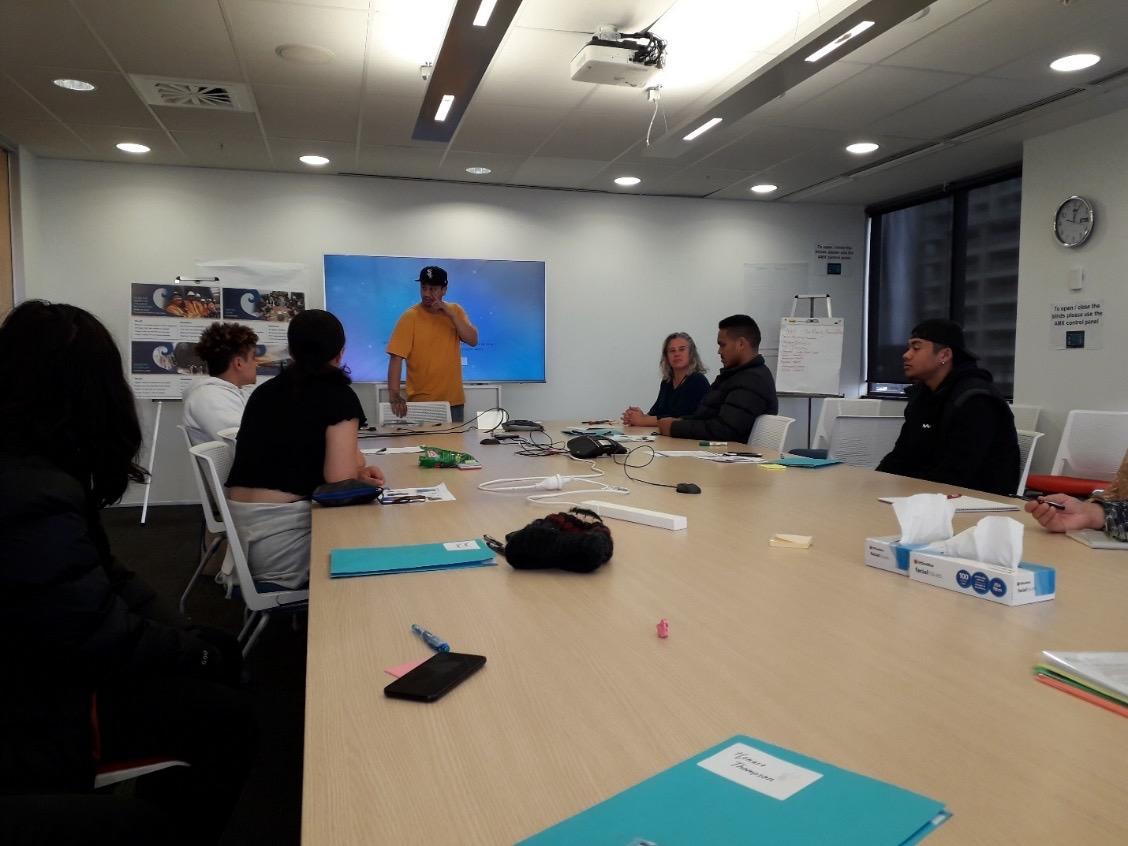
offered to the interns as a micro credential in collaboration with Otago Polytechnic. The learning needed to gain the formal recognition meant the interns owned the responsibility for their own health and safety and that of their workmates.
Workplace numeracy training was also provided, with the aim to empower rangatahi to ask appropriate questions and be able to find the answers. Tina remembers one of the PEP reviewing her payslip and her employment contract and identifying that the amount on her payslip was less than the amount stated in her contract, providing a ‘live example’ for the interns. Discussions about assertiveness rather than aggressiveness followed. Tina wanted to ensure rangatahi had the opportunity to learn how to communicate effectively. She identifies ‘soft skills’ as critical skills and states “they are the skills that enable us to be the best we can be”.
Education Unlimited designed Write Up, Speak Up, Be Safe to help people understand Health and Safety requirements onsite, such as completing an incident report and building their confidence to speak up. This was
Education Unlimited’s whakatauki “Mā te mahitahi, ka tipu te mātauranga, mā te mātauranga ka tipu hei tāngata” (Through working as one, there is growth in knowledge, from that knowledge people grow) is visible across CRL Ltd, Link Alliance, Education Unlimited and especially the PEP rangatahi.
CASE STUDY
Ian Howe Concrete Pumps Ltd
Concrete pumps have revolutionised the traditional concrete pour. Ian Howe, the owner of Ian Howe Concrete Pumps Ltd, has been working with concrete for four decades, with much of the last six years spent working on City Rail Link. Ian pumped concrete into the Chief Post Office building when the first works at Contract 1 were happening.
Ian Howe Concrete Pumps now has up to 26 staff working across three sites at City Rail Link: Maungawhau Station, Te Waihorotiu Station and Waitematā Station (Britomart). Prerequisites for joining the team include a driver’s license, a good attitude and flexibility. Pumping concrete is not a standard 9-to-5 job. Workers often need to be onsite by 6am and once concrete pouring starts stay until the job is done.
“What concrete pumps give to the industry is the ability to move huge amounts of concrete really fast to designated areas you can't access with a truck. It makes it easier to place concrete because we can get it level as we move the boom around and we can pour the concrete exactly where they want it,” says Ian.
Workers experience all facets of concrete pumping, starting off as hose hands before progressing to line pumps, trailer pumps and then smaller domestic trucks. Skill development is important and staff need to be experienced before transitioning to the boom pumps, which are used on City Rail Link.
Ian and wife Harriet are a part of a working group that are looking at setting up a New Zealand concrete pumping qualification.
“At the moment any Joe Bloggs can go out and buy a concrete pump and start operating. No training, no ticket, puts everyone at risk,” explains Ian, who is a member of the American Concrete Pumping Association (ACPA).
ACPA have training modules that Ian’s team has or are completing, providing workers with an international qualification.
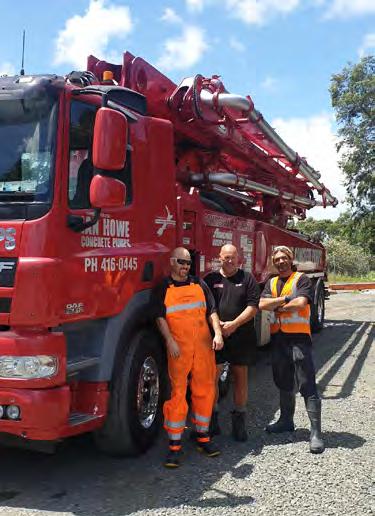
City Rail Link sites are constantly evolving and changing and this is also true of the people working on site. Building a good working relationship with each site foreman is critical, especially as the project is now moving into a very technical stage where distances have increased and access is diminished: “Getting from point A to point B is not a straight forward manoeuvre; this is a challenge and also an awesome learning opportunity” says Ian.
The team from Ian Howe Concrete Pumps Ltd
To meet the technical demands of working underground, within tunnels and at the scale required for the project, five innovative new machines have been purchased that have never before been used in Aotearoa. The technical and practical knowledge gained on this project will flow on to provide benefits to other contracts.
CASE STUDY
Martinus Rail
In late 2020 Martinus Rail was awarded the supply, installation and commissioning of track and overhead wiring contract for City Rail Link. Martinus Rail has a reputation as the go-to company for complex track and overhead wiring solutions, special trackwork and signaling solutions.
Martinus Rail’s focus on complex rail infrastructure construction projects and City Rail Link has enabled them to introduce a couple of innovative measures: The use of a Zephir (shunting machine) and TLPS (track laying points system), as well as developing a programme with KiwiRail and CRL Ltd to reconfigure the Waitematā Station (Britomart) tunnel within tight time constraints.
As part of the works, Martinus Rail will supply and install all the rail, slab track, ballasted track, rigid overhead conductor bar and overhead line equipment works between Waitematā and Maungawhau Stations.
The Martinus Rail team working on the CRL will at its peak include more than 250 workers and General Manager Murray Simon says that approximately 67% of their workforce are Māori or Pasifika.
Martinus Rail is working to build a reputation as a company that cares for people. When Martinus Rail put forward a tender bid to CRL Ltd, they also submitted a draft Social Impact Management Plan outlining how they would be creating positive change for the local people.
Implementation of this plan has included:
• A commitment to First Foundation - signing up to support three rangatahi through their tertiary journey, including payment of fees, providing a mentor, as well as work over the summer holidays
• Connecting with Tupu Toa to source summer interns
• Working to improve NZ apprenticeship qualifications so that they are more relevant and recognisable on a world scale
• Using their awareness of the power of social procurement to engage several Māori or Pasifika owned businesses to help deliver the works.
CRL Ltd and Link Alliance have four social impact target areas: employment, training, social procurement, and future workforce. Martinus are delivering on each of these.
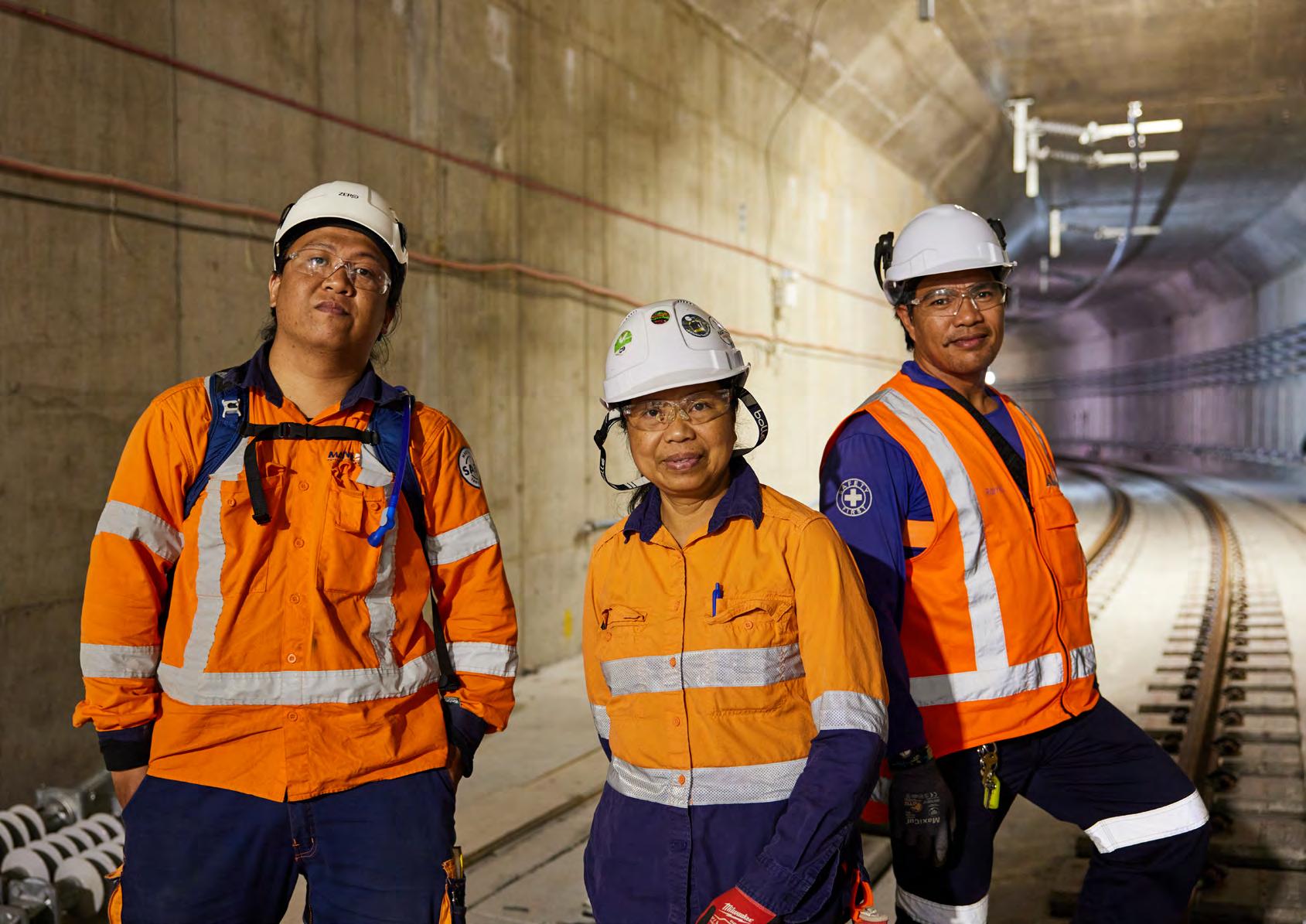 The team from Martinus Rail
The team from Martinus Rail
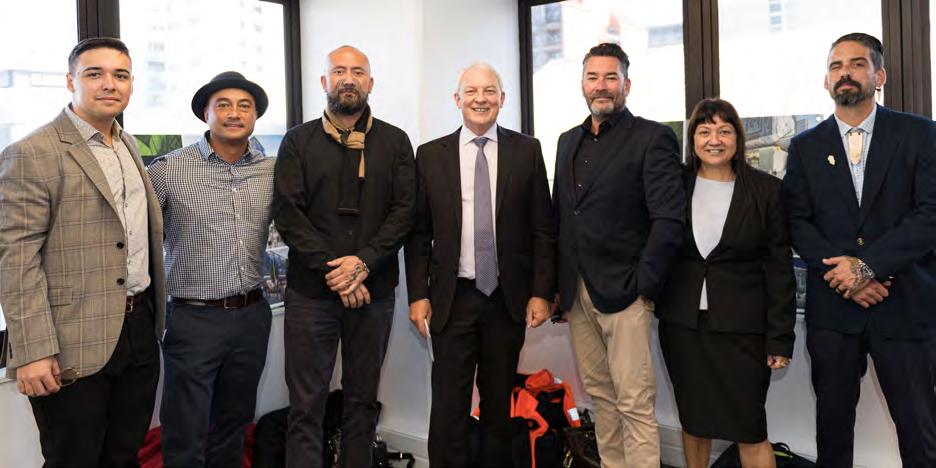



Mana whenua
2022 was an important year for CRL Ltd’s Mana Whenua Forum, a year that saw the principles of Tiriti o Waitangi (Treaty of Waitangi) put into action and which will help shape the future of public transport in Tāmaki Makaurau.
The Forum’s contributions to Aotearoa’s most important transport infrastructure project, City Rail Link, included significant collaboration and oversight of on-site wellbeing and sustainable construction practices.
It is also contributing more widely to cultural vibrancy through the striking designs for the new stations and other elements of the CRL, which
acknowledge Tāmaki Makaurau’s storied past, while also presenting Auckland as an international city with a state-of-the-art futuristic image.
The partnership between CRL Ltd and Auckland iwi began ten years ago with the establishment of the CRL Mana Whenua Forum. Since then the contribution of Māori mātauranga (cultural values) from mana whenua has been significant and
benefited the project in substantial and measurable ways.
Eight Tāmaki Makaurau iwi make up the Forum, which provides the structure to give shape to the partnership. Contributing Matauranga Māori (Māori knowledge) and sharing cultural values continues to deliver better sustainability, environmental, design, health, and safety outcomes.

Five Pou of Mana Whenua Forum
There are five pou – the pillars or principles – that the Mana Whenua Forum developed to clarify the outcomes it would like to see for iwi from the project. The five pou are Rangatiratanga, Whakapapa, Te Taiao, Oranga and Whai Rawa.
Each pou is equally important, and mana whenua aspirations can only be achieved when project activity is integrated across the five pou. There was discussion on a sixth pou (Wairua/Spiritual – mana whenua and the people of Tāmaki Makaurau are spiritually sustained and nourished) as wairua is intrinsically linked to all five pou.
Listed below are some of the key outcomes achieved by the Mana Whenua Forum under each of the five pou.

1. Rangatiratanga (Governance)
The CRL-Mana Whenua Forum partnership is a developing co-governance model for public and private engagement with iwi and other Māori representative bodies. The CRL Mana Whenua Forum Terms of Reference is the founding document of the partnership, which includes iwi visibility and input into the decision-making process at executive level. The relationship is one based on mutual respect and trust and has delivered significant outcomes in line with iwi expectations.
2. Whakapapa (Culture & Identity)
The designs for the new stations and precincts were shaped by narratives set by mana whenua artists and leaders in collaboration with CRL Ltd. The Forum has and continues to oversee development of the art and design elements (see below for more detail). The selected mana whenua artists had freedom to interpret the design briefs and have created place-specific narratives to create a unique and authentic design for each station. The cultural wellbeing of the project and workers has been an important activity, with karakia performed to bless workplaces and completed areas of works before they are given back to the community.
Gifting of te reo Māori station names
The Forum gifted te reo Māori names for the four CRL stations. The names align with the Forum’s role in helping develop the overarching themes influencing the final designs for three of the stations, which share the Māori creation story.
In May 2022, a joint proposal from CRL Ltd and Auckland Transport was submitted to the New Zealand Geographic Board Ngā Pou Taunaha o Aotearoa to officially adopt the following te reo Māori names:
• Maungawhau Station
• Karanga-a-Hape Station
• Te Waihorotiu Station
• Waitematā Station (Britomart)
The final designs relate to the new Maungawhau Station, Karanga-a-Hape Station and Te Waihorotiu Station.
Waitematā Station (Britomart) reopened in 2021. The Te Komititanga public space in front of the station’s main entrance incorporates traditional designs and weaving patterns.
The names and the designs highlighted the successful collaboration that exists between the Mana Whenua Forum and the project.
Station Design
During the year, the Forum continued to oversee development of collaborative art and design elements for the stations and their precincts.
The station designs were shaped by narratives set by mana whenua and they also led the briefs for the collaborative elements. Selected mana whenua artists were free to interpret the briefs and come back with their ideas for review and discussion. The collaborative approach, within functional and material constraints, drove the process and shaped the final designs.
Artists interpreted the Māori creation kōrero and other place-specific narratives to create a distinctive design for each station. Façade designs have been developed in a way that is unique and authentic to the station locations and to Aotearoa.
The artists, design and fabrication teams have developed entrance threshold treatments for each station, along with other elements throughout the stations and their immediate precinct, to provide another layer to the narrative.
All these elements have been led by four amazing mana whenua artists working with Link Alliance design teams: Graham Tipene (Ngāti Whātua Ōrākei, Ngāti Manu, Ngāti Hine and Ngāti Hauā) on Te Waihorotiu Station; Reuben Kirkwood (Ngāi Tai ki Tāmaki) on Karanga-a-Hape Station ; Tessa Harris (Ngāi Tai ki Tāmaki) on Maungawhau Station ; Dr Johnson Witehira (Ngāpuhi, Ngai Tū-te-auru, Tamahaki and Ngāti Hinekura) on the Kingston Street vent.
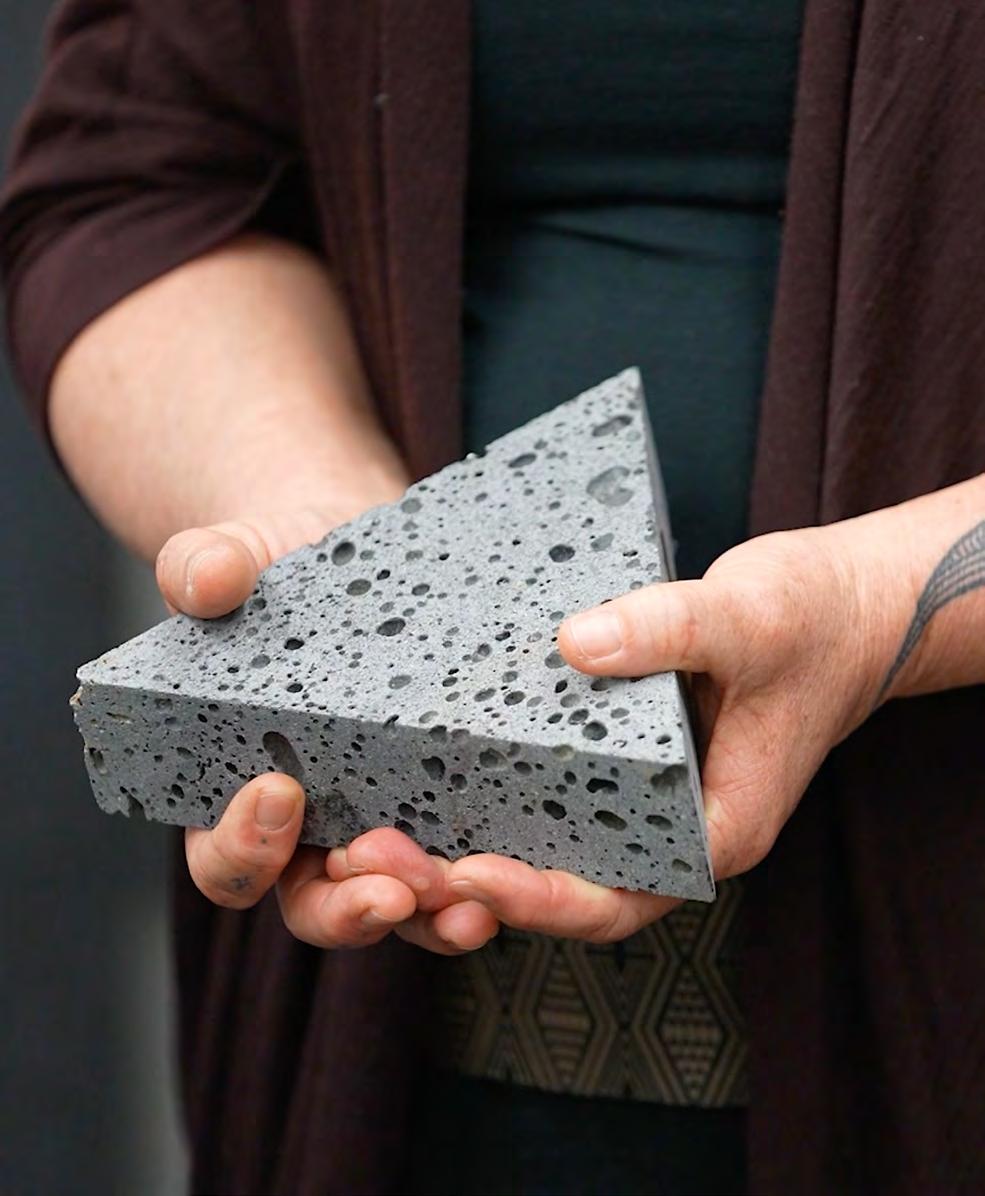 Basalt triangle, a featured element of the Maungawhau Station façade, designed by Tessa Harris
Basalt triangle, a featured element of the Maungawhau Station façade, designed by Tessa Harris
Meet the CRL Stations

Maungawhau Station
The name acknowledges the te reo translation for the most significant geographic feature in proximity to the station, the volcano Maungawhau (Mount Eden). Maungawhau – or the ‘mountain of the whau’ – is named for the whau tree (Entelea arborescens) that grows on its slopes. Whau is endemic to the area and was an important resource for Māori because of its light, cork-like properties.
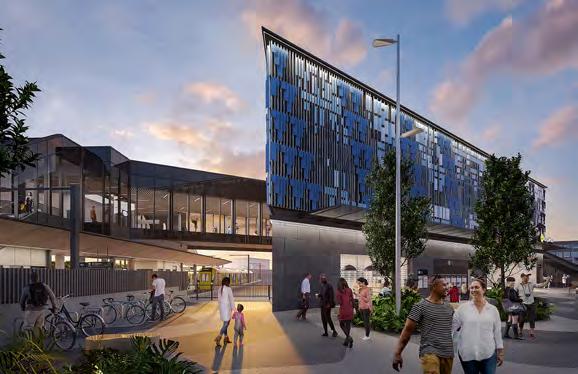
Karanga-a-Hape Station
Karanga-a-Hape can be translated to ‘The Call of Hape’ and is a grammatical correction of the name ‘Karangahape’. Hape was a significant Tainui ancestor who had been denied passage on the Tainui waka travelling from Hawaiki to Aotearoa. He called his kaitiaki, a stingray, and journeyed on the stingray’s back to Aotearoa ahead of the Tainui waka. The name Karanga-a-Hape, celebrates Hape’s call to welcome his own relatives who had denied him passage.

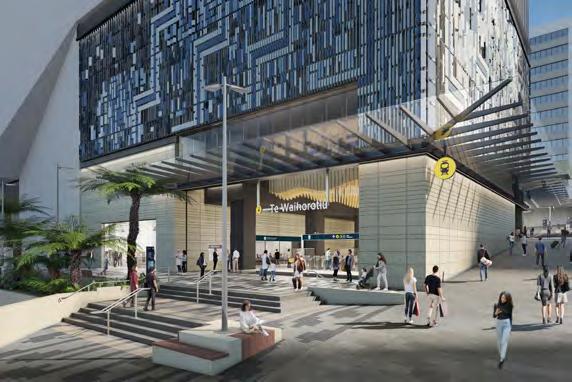
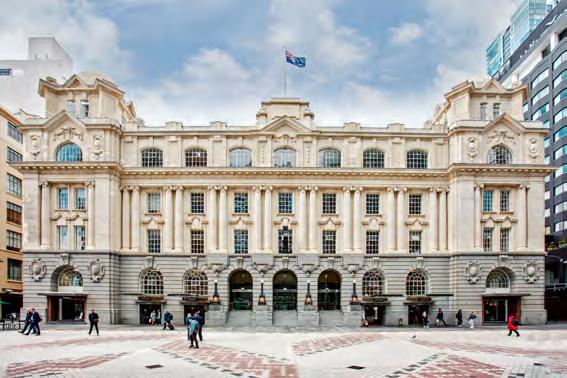
Te Waihorotiu Station
This name is given for the station area’s most significant geographic feature, the stream named Waihorotiu that flows underneath Queen Street. It provided water for locals and their crops. Waihorotiu is an important symbol of mana for iwi and hapū.
Waitematā Station (Britomart)
The proposed name for this station is associated with nearby Waitematā Harbour. It acknowledges that the station currently sits on land reclaimed from the harbour. There are two interpretations for this name, both of which are accepted by mana whenua. The first, ‘wai te matā’, can be translated to ‘obsidian waters’, a reference to the way that the harbour’s glassy waters resemble volcanic obsidian rock. The second reflects a visit from a Te Arawa ancestor who placed an obsidian stone as a mauri (talisman) beside the harbour.
3. Te Taiao (Natural Environment)
The Forum brings a holistic approach to its oversight of the CRL to ensure the best practical environmental, sustainability, social and cultural outcomes are achieved. This has resulted in a wide range of positive outcomes, including innovative solutions to the treatment and discharge of construction water, exceptional re-use and recycling of construction materials and a significant reduction in waste being sent to landfills.
Forum leadership of the environmental aspects of the project has resulted in international recognition of the outstanding outcomes achieved by the CRL and Link Alliance teams, including the ‘Leading' As Built rating for C1, an independent verification of the project’s outstanding sustainability outcomes, from the Australian-based Infrastructure Sustainability Council. The achievement follows the 'Excellent' As Built and ‘Leading' Design ratings awarded earlier for CRL works at the lower end of Albert St, as well as a wide range of honours for innovation, sustainability, engineering and circular economy practices bestowed upon the project.
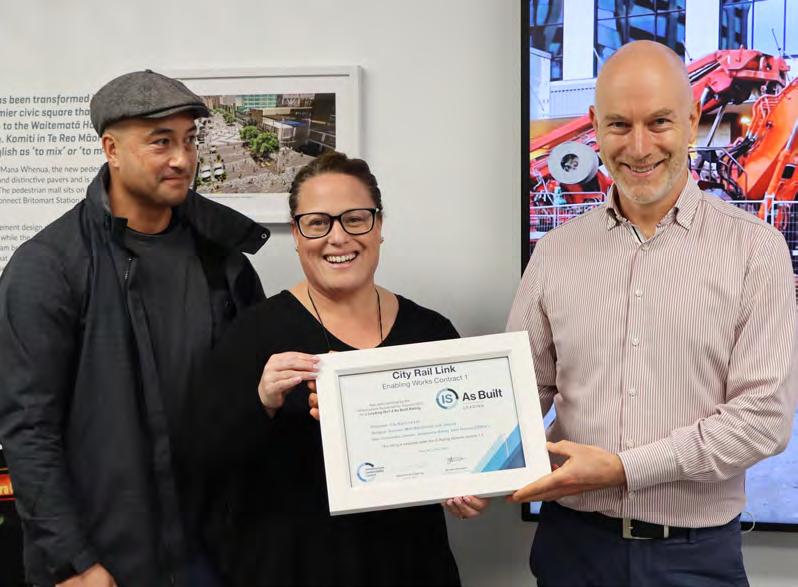
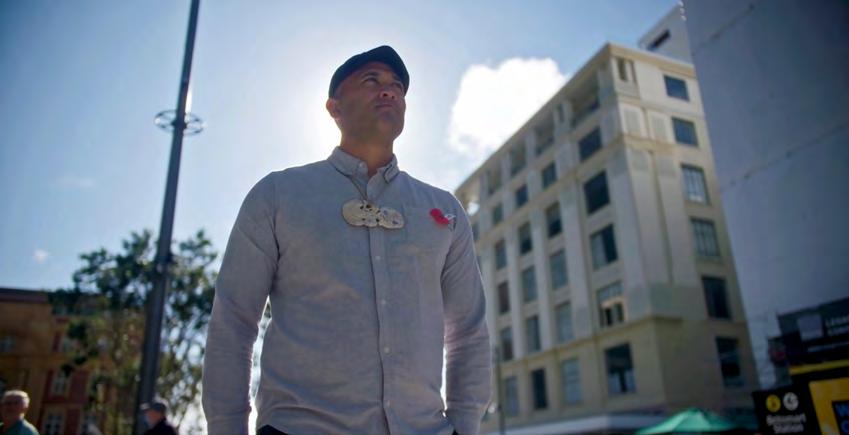
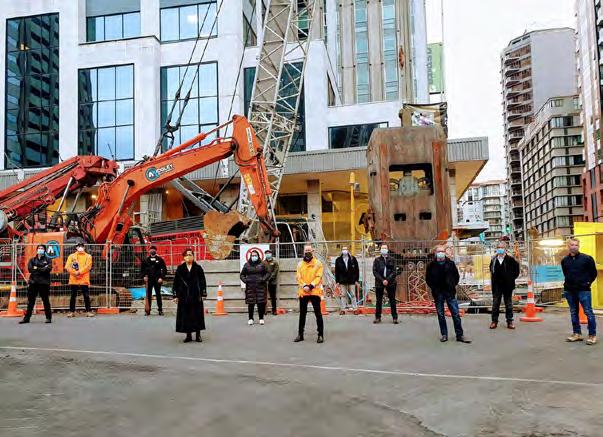
4. Oranga (Wellbeing)
Wellbeing underpins the work of all parties involved in the CRL project and is a particular focus of the Mana Whenua Forum.
The Forum’s vision is based on a Māori proverb, credited to Tu Puea Hērangi, that asks us all to consider who benefits from doing the mahi. The project, and the society it serves, cannot reap those rewards if people cannot work safely, if people do not protect the environment and if we don’t protect ourselves and our colleagues.
This ethos informs the Forum and why the CRL has recast its health and safety strategy as the health, safety and wellbeing strategy in order broaden the focus beyond physical health to include mental wellbeing and recognise the wide range of factors that impact people’s mental health.
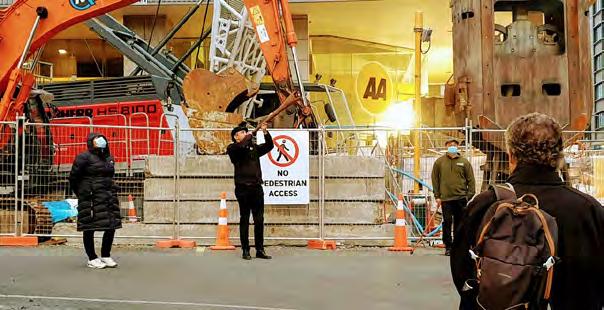
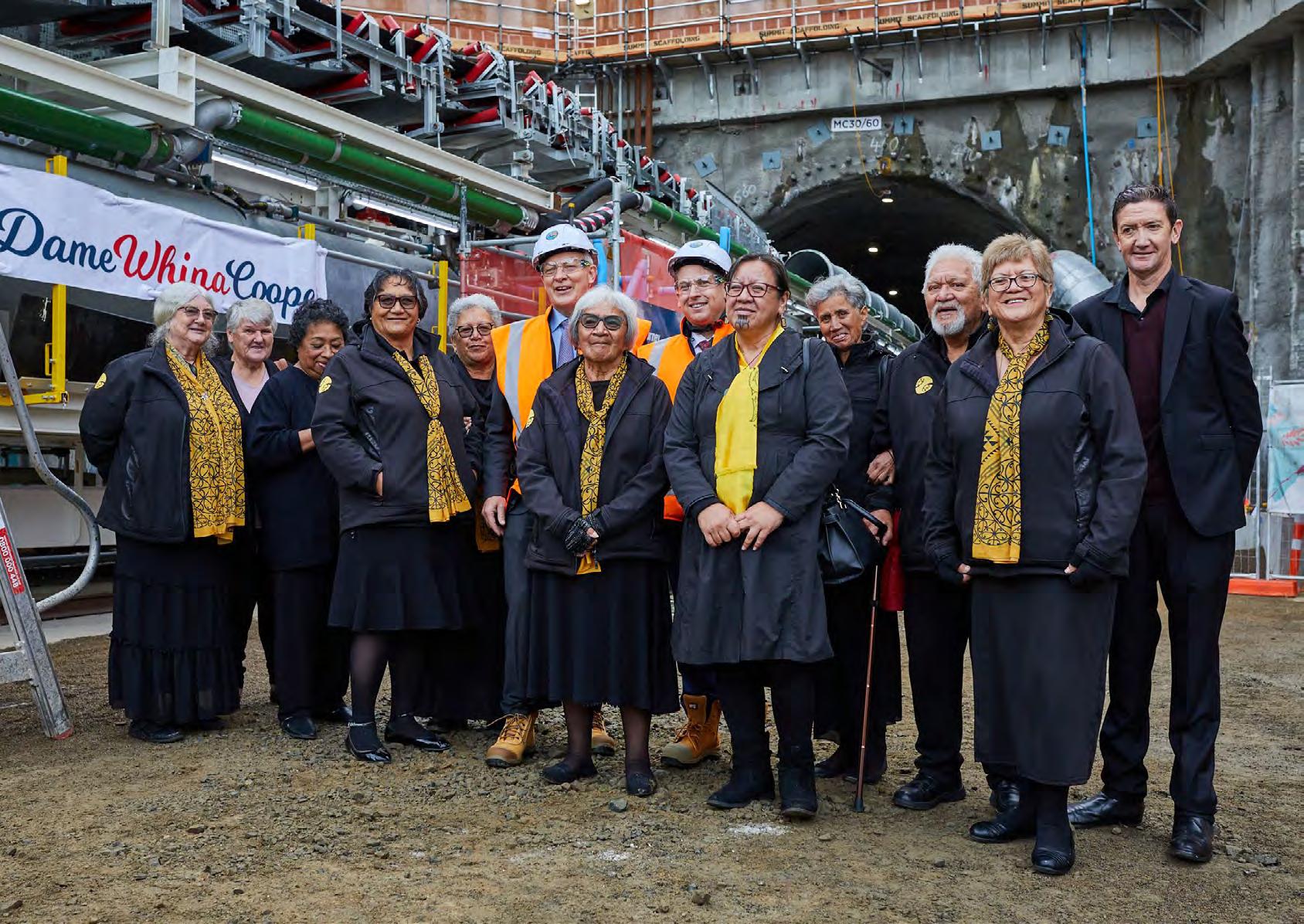 Ngāti Whātua Ōrākei with former Mayor Phil Goff and Minster of Transport, Michael Wood at the Maungawhau site
Ngāti Whātua Ōrākei with former Mayor Phil Goff and Minster of Transport, Michael Wood at the Maungawhau site
Wellbeing of the whenua
The Mana Whenua Forum played an influential role in protecting CRL workers and their family and friends against Covid-19. Strong backing for Health and Safety initiatives, including the use of Ngāti Whātua Ōrākei’s vaccination bus, were instrumental in achieving the project’s target to have 100% of the workforce protected against the virus.
Importantly, The Forum’s backing contributed to CRL’s quick return to construction momentum.
CRL Ltd and its contractors continue to look to mana whenua to inform the project when karakia should take place. This included the start of works at Basque Park in Eden Terrace. Ngāti Whātua Ōrākei and Ngāti Te Ata Waiohua led a karanga and karakia at the Te Waihorotiu Station site to bless the safe restart of construction work when lockdown restrictions were eased in September 2021. More recently, karakia was conducted to mark the opening of the Normanby Bridge in December 2022 and the final breakthrough of the tunnel boring machine in September 2022.
The Forum’s impact is visible across CRL work sites with a formalised cultural induction process, blessings on site before work starts and karakia before Link Alliance team meetings. Cultural inductions on site with workers are used to educate them about the significance of the land. Increasing knowledge of whakapapa, the histories, the names of the sites worked on and the significance of the project in creating more sustainable transport.
The Health, Safety & Wellbeing vision has been suggested by mana whenua and it is a Māori proverb credited to Tu Puea Hērangi - ‘Mahia te mahi, hei painga hei oranga mo tātou katoa,’ which means ‘To do the work, for the good of everyone’ and this has become a crucial foundation of the strategy.
The health and safety strategy has some high-level objectives and then underlying behaviours the Forum holds itself to. The Forum’s collaboration on the strategy created the environment for a healthy working relationship. The vision asks us all to consider who benefits from doing the work. At a personal level, it is ourselves, our colleagues, our
families, our communities. It is also the built and natural environment upon which we work. And the city of Auckland, its people and its prosperous and sustainable future. Collectively, we cannot reap these rewards if we do not work safely, if we don’t protect ourselves and our colleagues and if we don’t protect the environment and the land on which we work. The vision, therefore, speaks to each individual to consider how working safely benefits others.
Recent engagement with mana whenua has been framed around wellbeing. CRL Ltd has recast the strategy as a health, safety, and wellbeing strategy because of feedback from the Mana Whenua Forum that identified that protecting the physical health of our people is not enough and mental wellbeing is just as important. The Forum’s view was that wellbeing is as much of a priority as making sure people aren’t harmed physically through traditional hazards on site.
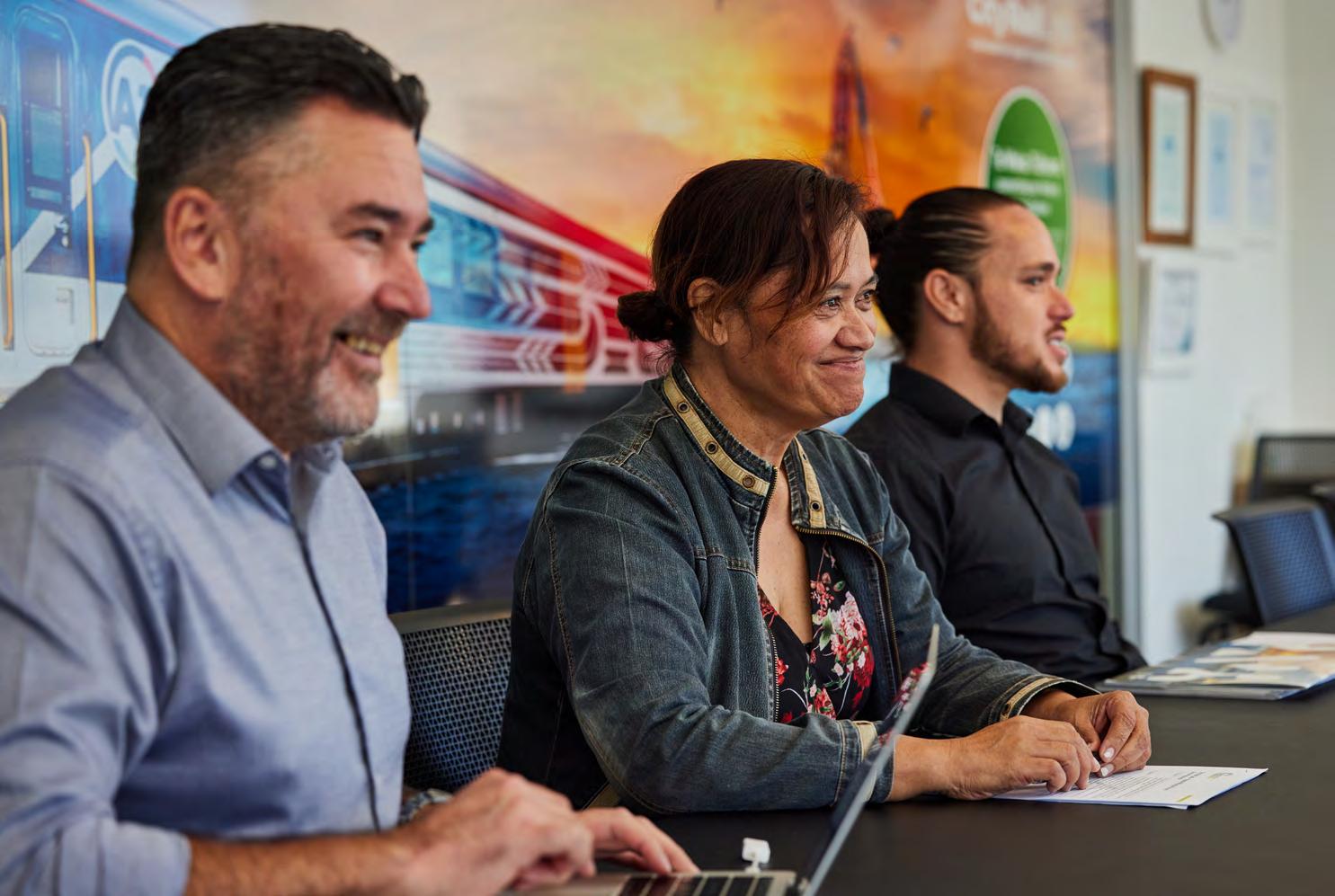
If the domain of the land is well, if the domain of the water is well, then we as mana whenua are well, thriving, and prosperous.
5. Whai Rawa (Finance)
The final pou of the Forum is Whai Rawa (economic) and is fundamental to the principles of sustainability and wellbeing – as well as giving substance to the goal of creating positive and long-lasting social outcomes.
One key means of achieving this goal is the CRL policy on supplier diversity, which is designed to foster Māori and Pasifika businesses and, in relation to construction, increase diversity across the industry.
To date, 7% of Link Alliance’s total spend has been on Māori and Pasifika-owned sub-contractors and suppliers. This has involved 41 contracts worth $79 million, a significant investment in the Māori and Pasifika business economy.
Of these, $188,000 has been contracted to mana whenua iwi. This year, Ngāti Whātua Nurseries was awarded a contract for the provision of plants as the project steps up work on the fitout of the new stations.
This is succeeding in building both capacity and capability in the Māori and Pasifika construction sector and benefiting the broader construction industry by increasing diversity in the supply chain.
This policy is also delivering significant economic and employment opportunities for Māori and Pasifika businesses and people, with an added benefit of keeping investment within the motu (country) and region.
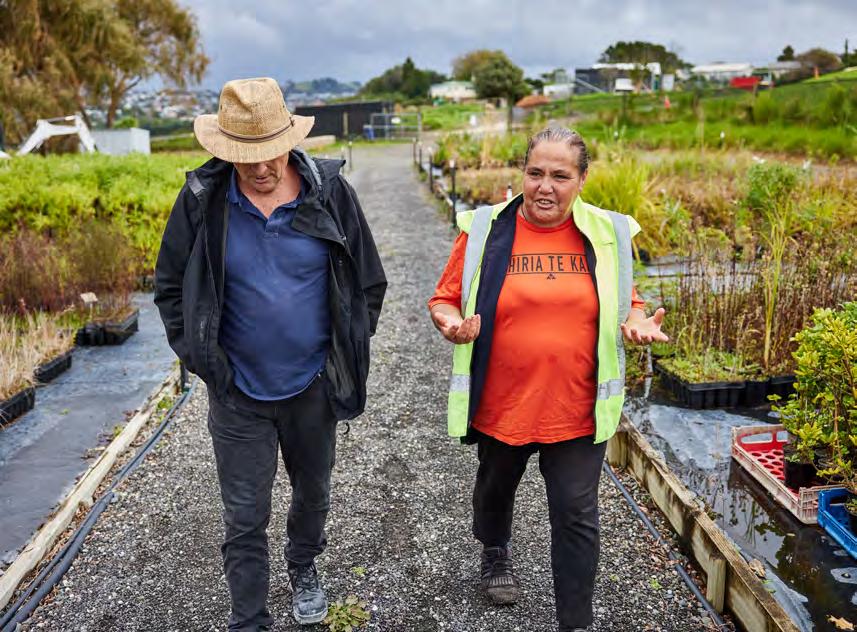
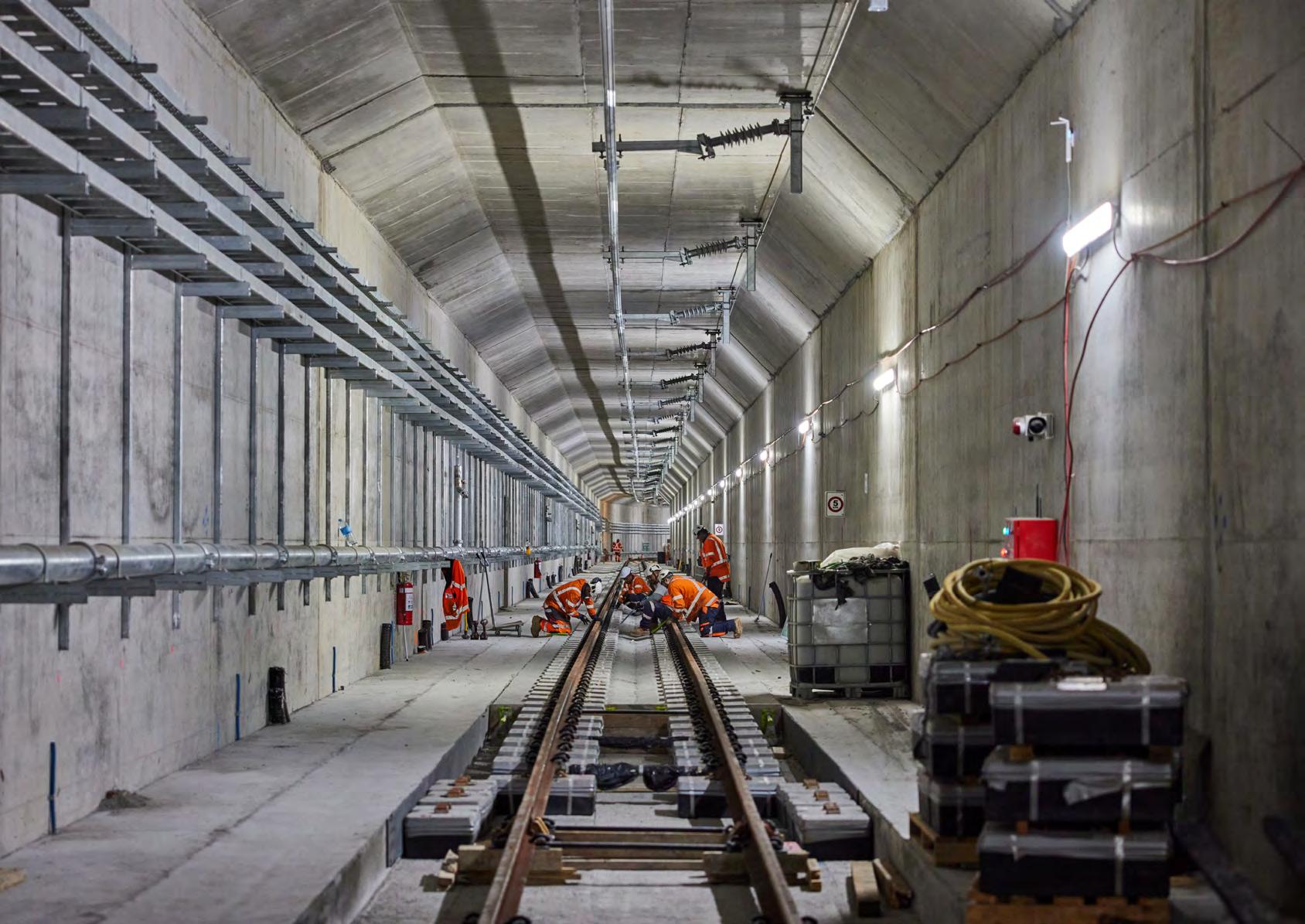 Progress being made in tunnel construction
Progress being made in tunnel construction
Governance and reporting
The project's sponsors, the Crown and Auckland Council, expect CRL to be designed, constructed and operated to achieve sustainability excellence, as set out in CRL Ltd's Statement of Intent, and is reported to Sponsors annually against the Statement of Performance Expectations.
CRL is being designed, procured and constructed to generate the greatest long-term environmental, social and economic value from the considerable resources needed to deliver the project. This will result in:
• An asset that has a carbon footprint optimised over its 100-year design-life
• A construction process that minimises the amount of waste sent to landfill
• Training and employment opportunities for those experiencing barriers, disadvantage or discrimination in the labour market
• Supply chain opportunities for Māori and Pasifika small and medium size enterprises and socially innovative businesses.
Link Alliance commitments
Many of CRL Ltd's performance expectations are being delivered by Link Alliance on C3. Embedded within the strategies and objectives are the following commitments:
• To minimise waste and limiting visual, air quality, water quality and noise impacts
• To integrate sustainability in design, construction, operation and maintenance
• To maximise opportunities to support local businesses and suppliers
• To recognise the broader dimensions of the environment, including social, cultural, economic and natural
• To maximise opportunities for training and skills development for the widest possible group of people
• To protect and promote our cultural and historic heritage for future generations.
Infrastructure sustainability
ISC's IS framework is a comprehensive rating and certification tool for evaluating sustainability across project design, construction and operation.
CRL adopted the IS rating framework to evaluate and drive sustainability performance. We adapted the framework in collaboration with mana whenua to ensure it is appropriate within the context of Tāmaki Makaurau.
CRL continues to meet criteria across the framework's six themes:
• Management and governance
• Using resources
• Emissions, pollution and waste
• Ecology
• People and place
• Innovation.
The IS rating tool ensures the project focuses on:
• Modelling and measuring resource consumption
• Identifying and implementing feasible opportunities to reduce consumption
• Achieving significant reductions in resource use across the infrastructure lifecycle
There are three levels of performance:
• Leading
• Excellent
• Commended.
CRL Ltd has required C1, C2 and C3 to achieve at least 65 points, which would result in at least an 'Excellent' rating.
To date both C1 and C2 have achieved a 'Leading' Design rating, C1 a 'Leading' As Built rating and C2 an 'Excellent' As Built rating.

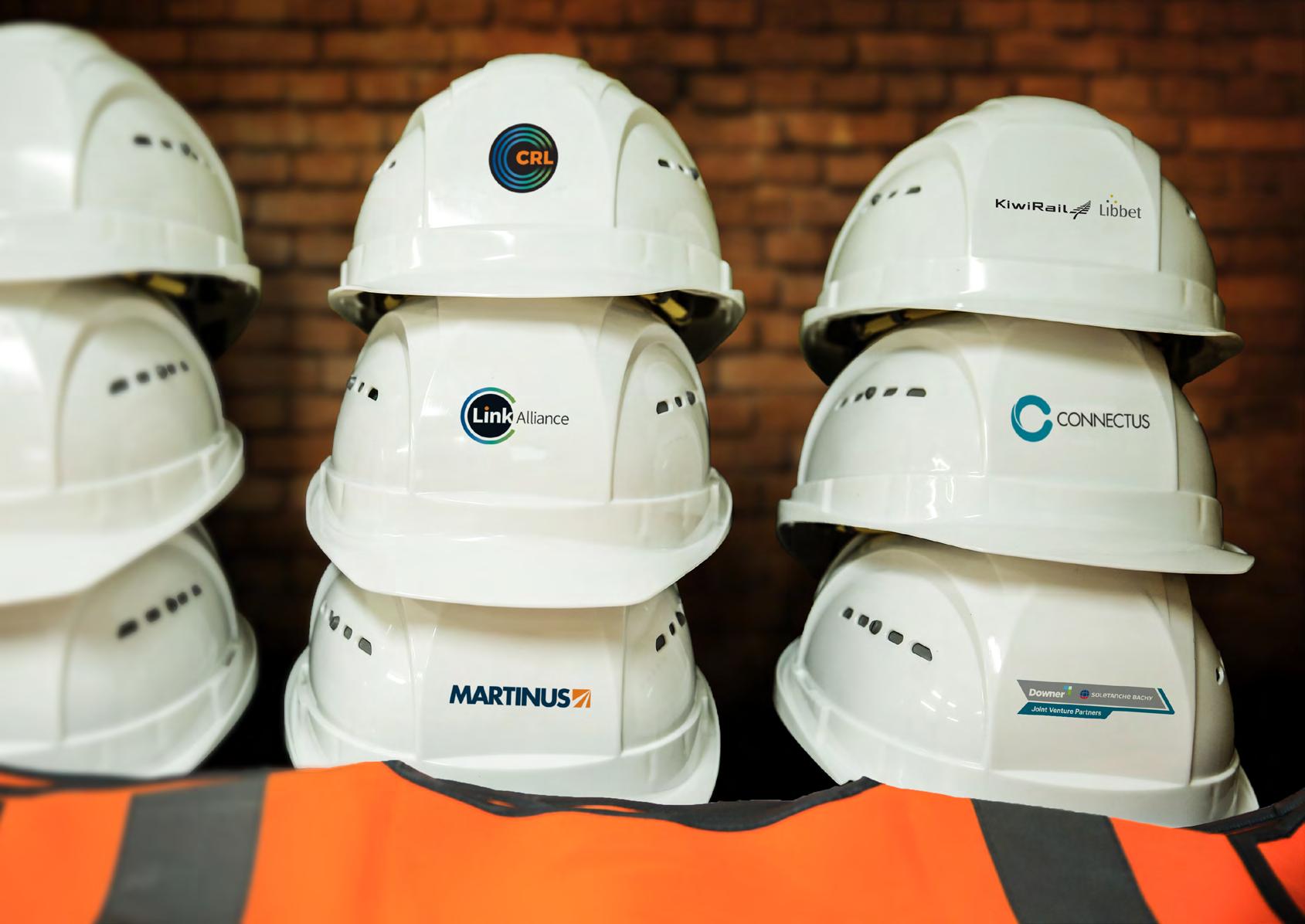
Delivering CRL safely and sustainably requires a shared commitment and collaboration - we acknowledge the efforts of all.
